|

|
|
AGENDA
Strategy, Finance and Risk Committee meeting
Monday, 13 May 2024
|
|
I hereby give notice that a Strategy, Finance and
Risk Committee meeting will be held on:
|
|
Date:
|
Monday, 13 May 2024
|
|
Time:
|
1pm
|
|
Location:
|
Bay of Plenty Regional Council Chambers
Regional House
1 Elizabeth Street
Tauranga
|
|
Please note that this
meeting will be livestreamed and the recording will be publicly available on
Tauranga City Council's website: www.tauranga.govt.nz.
|
|
Marty Grenfell
Chief Executive
|
Terms of reference – Strategy,
Finance & Risk Committee
Membership
|
Chairperson
|
Commission
Chair Anne Tolley
|
|
Deputy
chairperson
|
Dr
Wayne Beilby – Tangata Whenua representative
|
|
Members
|
Commissioner
Shadrach Rolleston
Commissioner Stephen
Selwood
Commissioner Bill Wasley
|
|
|
Matire
Duncan, Te Rangapū Mana Whenua o Tauranga Moana Chairperson
Te Pio Kawe – Tangata
Whenua representative
Rohario Murray – Tangata
Whenua representative
Bruce
Robertson – External appointee with finance and risk experience
|
|
Quorum
|
Five
(5) members must be physically present, and at least three (3) commissioners
and two (2) externally appointed members must be present.
|
|
Meeting
frequency
|
Six
weekly
|
Role
The role
of the Strategy, Finance and Risk Committee (the Committee) is:
(a)
to assist and advise the Council in discharging
its responsibility and ownership of health and safety, risk management,
internal control, financial management practices, frameworks and processes to
ensure these are robust and appropriate to safeguard the Council's staff and
its financial and non-financial assets;
(b)
to consider strategic issues facing the city and
develop a pathway for the future;
(c)
to monitor progress on achievement of desired
strategic outcomes;
(d)
to review and determine the policy and bylaw
framework that will assist in achieving the strategic priorities and outcomes
for the Tauranga City Council.
Membership
The Committee will consist of:
·
four commissioners with the Commission Chair appointed as the
Chairperson of the Committee
·
the Chairperson of Te Rangapū Mana Whenua o Tauranga Moana
·
three tangata whenua representatives (recommended by Te
Rangapū Mana Whenua o Tauranga Moana and appointed by Council)
·
an independent external person with finance and risk experience
appointed by the Council.
Voting
Rights
The tangata whenua representatives and the independent
external person have voting rights as do the Commissioners.
The Chairperson of Te Rangapu Mana Whenua o Tauranga Moana
is an advisory position, without voting rights, designed to ensure mana whenua
discussions are connected to the committee.
Committee's
Scope and Responsibilities
A. STRATEGIC ISSUES
The
Committee will consider strategic issues, options, community impact and explore
opportunities for achieving outcomes through a partnership approach.
A1 – Strategic Issues
The Committee's
responsibilities with regard to Strategic Issues are:
·
Adopt an annual work programme of significant strategic issues
and projects to be addressed. The work programme will be reviewed on a
six-monthly basis.
·
In respect of each issue/project on the work programme, and any
additional matters as determined by the Committee:
o
Consider existing and future strategic context
o
Consider opportunities and possible options
o
Determine preferred direction and pathway forward and recommend
to Council for inclusion into strategies, statutory documents (including City
Plan) and plans.
·
Consider and approve changes to service delivery arrangements
arising from the service delivery reviews required under Local Government Act
2002 that are referred to the Committee by the Chief Executive.
·
To take appropriate account of the principles of the Treaty of
Waitangi.
A2 – Policy and Bylaws
The Committee's
responsibilities with regard to Policy and Bylaws are:
·
Develop, review and approve bylaws to be publicly consulted on,
hear and deliberate on any submissions and recommend to Council the adoption of
the final bylaw. (The Committee will recommend the adoption of a bylaw to the
Council as the Council cannot delegate to a Committee the adoption of a bylaw.)
·
Develop, review and approve policies including the ability to
publicly consult, hear and deliberate on and adopt policies.
A3 – Monitoring of Strategic Outcomes
and Long Term Plan and Annual Plan
The Committee's
responsibilities with regard to monitoring of strategic outcomes and Long Term
Plan and Annual Plan are:
·
Reviewing and reporting on outcomes and action progress against
the approved strategic direction. Determine any required review / refresh of
strategic direction or action pathway.
·
Reviewing and assessing progress in each of the six (6) key
investment proposal areas within the 2021-2031 Long Term Plan.
·
Reviewing the achievement of financial and non-financial
performance measures against the approved Long Term Plan and Annual Plans.
B.
FINANCE AND RISK
The Committee will review the
effectiveness of the following to ensure these are robust and appropriate to
safeguard the Council's financial and non-financial assets:
·
Health and safety.
·
Risk management.
·
Significant projects and programmes of work focussing on the
appropriate management of risk.
·
Internal and external audit and
assurance.
·
Fraud, integrity and investigations.
·
Monitoring of compliance with laws and regulations.
·
Oversight of preparation of the Annual Report and other external
financial reports required by statute.
·
Oversee the relationship with the Council’s Investment
Advisors and Fund Managers.
·
Oversee the relationship between the Council and its external
auditor.
·
Review the quarterly financial and non-financial reports to the
Council.
B1 - Health and Safety
The Committee’s responsibilities through regard to
health and safety are:
·
Reviewing the effectiveness of the health and safety policies and
processes to ensure a healthy and safe workspace for representatives, staff,
contractors, visitors and the public.
·
Assisting the Commissioners to discharge their statutory roles as
"Officers" in terms of the Health and Safety at Work Act 2015.
B2 - Risk Management
The Committee's responsibilities with regard to risk
management are:
·
Review, approve and monitor the implementation of the Risk
Management Policy, including the Corporate Risk Register.
·
Review and approve the Council’s "risk appetite"
statement.
·
Review the effectiveness of risk management and internal control
systems including all material financial, operational, compliance and other
material controls. This includes legislative compliance, significant projects
and programmes of work, and significant procurement.
·
Review risk management reports identifying new and/or emerging
risks and any subsequent changes to the "Tier One" register.
B3
- Internal Audit
The Committee’s responsibilities with regard to the
Internal Audit are:
·
Review and approve the Internal Audit Charter to confirm the
authority, independence and scope of the Internal Audit function. The Internal
Audit Charter may be reviewed at other times and as required.
·
Review and approve annually and monitor the implementation of the
Internal Audit Plan.
·
Review the co-ordination between the risk and internal audit
functions, including the integration of the Council's risk profile with the
Internal Audit programme. This includes assurance over all material financial,
operational, compliance and other material controls. This includes legislative
compliance (including Health and Safety), significant projects and programmes
of work and significant procurement.
·
Review the reports of the Internal Audit functions dealing with
findings, conclusions and recommendations.
·
Review and monitor management’s responsiveness to the
findings and recommendations and enquire into the reasons that any
recommendation is not acted upon.
B4
- External Audit
The Committee's responsibilities with regard to the
External Audit are:
·
Review with the external auditor, before the audit commences, the
areas of audit focus and audit plan.
·
Review with the external auditors, representations required by
commissioners and senior management, including representations as to the fraud
and integrity control environment.
·
Recommend adoption of external accountability documents (LTP and
annual report) to the Council.
·
Review the external auditors, management letter and management
responses and inquire into reasons for any recommendations not acted upon.
·
Where required, the Chair may ask a senior representative of the
Office of the Auditor General (OAG) to attend the Committee meetings to discuss
the OAG's plans, findings and other matters of mutual interest.
·
Recommend to the Office of the Auditor General the decision
either to publicly tender the external audit or to continue with the existing
provider for a further three-year term.
B5
- Fraud and Integrity
The Committee's responsibilities with regard to Fraud and
Integrity are:
·
Review and provide advice on the Fraud Prevention and Management
Policy.
·
Review, adopt and monitor the Protected Disclosures Policy.
·
Review and monitor policy and process to manage conflicts of
interest amongst commissioners, tangata whenua representatives, external
representatives appointed to council committees or advisory boards, management,
staff, consultants and contractors.
·
Review reports from Internal Audit, external audit and management
related to protected disclosures, ethics, bribery and fraud related incidents.
·
Review and monitor policy and processes to manage
responsibilities under the Local Government Official Information and Meetings
Act 1987 and the Privacy Act 2020 and any actions from the Office of the
Ombudsman's report.
B6
- Statutory Reporting
The
Committee's responsibilities with regard to Statutory Reporting relate to
reviewing and monitoring the integrity of the Annual Report and recommending to
the Council for adoption the statutory financial statements and any other
formal announcements relating to the Council's financial performance, focusing
particularly on:
·
Compliance with, and the appropriate application of, relevant
accounting policies, practices and accounting standards.
·
Compliance with applicable legal requirements relevant to
statutory reporting.
·
The consistency of application of accounting policies, across
reporting periods.
·
Changes to accounting policies and practices that may affect the
way that accounts are presented.
·
Any decisions involving significant judgement, estimation or
uncertainty.
·
The extent to which financial statements are affected by any
unusual transactions and the manner in which they are disclosed.
·
The disclosure of contingent liabilities and contingent assets.
·
The basis for the adoption of the going concern assumption.
·
Significant adjustments resulting from the audit.
Power
to Act
·
To make all decisions necessary to fulfil the role, scope and
responsibilities of the Committee subject to the limitations imposed.
·
To establish sub-committees, working parties and forums as
required.
·
This Committee has not been delegated any
responsibilities, duties or powers that the Local Government Act 2002, or any
other Act, expressly provides the Council may not delegate. For the avoidance
of doubt, this Committee has not been delegated the power to:
o
make a rate;
o
make a bylaw;
o
borrow money, or purchase or dispose of assets, other than in
accordance with the Long-Term Plan (LTP);
o
adopt the LTP or Annual Plan;
o
adopt the Annual Report;
o
adopt any policies required to be adopted and consulted on in
association with the LTP or developed for the purpose of the local governance
statement;
o
adopt a remuneration and employment policy;
o
appoint a chief executive.
Power
to Recommend
To Council and/or any standing committee
as it deems appropriate.
|
Strategy,
Finance and Risk Committee meeting agenda
|
13
May 2024
|
7 Confirmation
of minutes
7.1 Minutes
of the Strategy, Finance and Risk Committee meeting held on 25 March 2024
File
Number: A15910798
Author: Caroline
Irvin, Governance Advisor
Authoriser: Anahera
Dinsdale, Acting Team Leader: Governance Services
|
Recommendations
That the minutes of the
Strategy, Finance and Risk Committee meeting held on 25 March 2024 be
confirmed as a true and correct record, subject to the following
correction/s:
(a)
|
Attachments
1. Minutes
of the Strategy, Finance and Risk Committee meeting held on 25 March 2024
|
 Strategy, Finance and Risk
Committee meeting minutes Strategy, Finance and Risk
Committee meeting minutes
|
25 March 2024
|
|

|
|
MINUTES
Strategy, Finance and Risk Committee
meeting
Monday, 25 March 2024
|
Order of Business
1 Opening karakia. 3
2 Apologies. 3
3 Public forum.. 4
4 Acceptance of late items. 4
5 Confidential business to be transferred into the open. 4
6 Change to order of business. 4
7 Confirmation of minutes. 4
7.1 Minutes of the Strategy, Finance and Risk Committee meeting held on
19 February 2024. 4
8 Declaration of conflicts of interest 4
9 Business. 4
9.1 Mainstreets' Monitoring Report for the period 1 July to 31 December
2023. 4
9.2 Local Alcohol Policy. 9
9.3 Adoption of Mount to Arataki Spatial Plan. 12
9.4 Non-Financial Performance Report - 6 monthly 2023/24 and Annual
Resident Survey 2023/24 - Wave 2. 13
9.5 Growth & Land Use Projects Progress Report - March 2024. 14
9.6 Urban Design Panel - Terms of Reference Update. 15
10 Discussion
of late items. 16
11 Public
excluded session. 16
11.1 Public Excluded minutes of the Strategy, Finance and Risk Committee
meeting held on 19 February 2024. 17
11.2 Appointment of Additional Urban Design Panel Members. 17
12 Closing
karakia. 17
Resolutions transferred into the open section
of the meeting after discussion. 17
11.2 Appointment
of Additional Urban Design Panel Members. 18
MINUTES OF Tauranga City
Council
Strategy, Finance and Risk
Committee meeting
HELD AT THE Bay of Plenty
Regional Council Chambers,
Regional House, 1 Elizabeth Street,
Tauranga
ON Monday, 25 March 2024, at
9.30 am
PRESENT: Commissioner Anne Tolley (Chairperson), Deputy Chairperson Dr Wayne
Beilby, Commissioner Shadrach Rolleston, Commissioner Bill Wasley and Ms
Rohario Murray and via Zoom Commissioner Stephen Selwood, Mr Te Pio Kawe and Mr
Bruce Robertson
IN ATTENDANCE: Christine Jones (General Manager: Strategy, Growth &
Governance), Sarah Omundsen (General Manager: Regulatory and Compliance),
Gareth Wallis (General Manager: City Development & Partnerships), Libby
Dodds (Team Leader: Community Relations), Jeremey Boase (Manager: Strategy
& Corporate Planning), Kendyl Sullivan, (City Partnerships Specialist),
Jane Barnett (Policy Analyst), Nigel McGlone (Manager: Regulatory and Compliance),
Carl Lucca, (Team Leader: Urban Communities), Kathryn
Hooker, (Corporate Planner), Andy Mead (Manager: City Planning & Growth),
Coral Hair (Manager: Democracy & Governance Services), Anahera Dinsdale
(Acting Team Leader: Governance Services), Caroline Irvin (Governance Advisor),
Aimee Aranas (Governance Advisor)
EXTERNAL: Mainstreet
Organisations:
Mahia Martelli (Manager)
Greerton
Genevieve Whitson (Manager) and Ash Gee
(Chairperson)
Mainstreet
Tauranga / Downtown Tauranga
Michael Clark
(Manager), Malika Ganley (Governance and Management Advisor), Mount Business
Association
Julia Manktelow (Events Contractor), Leah
Sutton (Chairperson)
Papamoa Unlimited
1 Opening
karakia
A karakia to open the meeting was given at the commencement of the
Extraordinary Council meeting.
2 Apologies
|
Committee Resolution SFR2/24/1
Moved: Dr
Wayne Beilby
Seconded: Ms Rohario Murray
That the apology for lateness from Mr Te Pio Kawe and Mr Bruce
Robertson, and the apology for absence received from Ms
Matire Duncan, be accepted.
Carried
|
3 Public forum
Nil
4 Acceptance of
late items
Nil
5 Confidential
business to be transferred into the open
Nil
6 Change to
order of business
Nil
7 Confirmation
of minutes
8 Declaration
of conflicts of interest
Commissioner
Shadrach Rolleston declared a conflict of interest in relation to item 9.5: ‘Resource Management Reforms and the Fast Track
Approvals Bill’ and took no part in the
discussion or voting on the matter.
Commissioner
Bill Wasley declared a conflict of interest in relation to item 9.5: ‘Growth & Land Use Projects
Progress Report - March 2024’ and took no part in the discussion or
voting on the matter.
Ms
Rohario Murray declared a conflict of interest in relation to item 9.5: ‘Resource Management Reforms and the Fast Track Approvals
Bill’ and took no part in the discussion or
voting on the matter.
9 Business
|
9.1 Mainstreet’s
Monitoring Report for the Period 1 July to 31 December 2023
|
|
Staff Gareth Wallis, General Manager: City Development &
Partnerships
Kendyl Sullivan, City Partnerships
Specialist
External Mahia Martelli (Manager) Greerton;
Genevieve
Whitson (Manager) and Ash Gee (Chairperson TBC) Mainstreet Tauranga /
Downtown Tauranga;
Michael
Clark (Manager) Malika Ganley (Governance and Management Advisor), Mount
Business Association; and
Julia
Manktelow (Events Contractor) Leah Sutton (Chairperson TBC) Papamoa Unlimited
1.
Greerton Village Community Association
- Mahia Martelli (Manager)
·
Ms Martelli thanked Tauranga City Council
(TCC) for its support.
·
The annual Cherry Blossom festival celebrated
spring and supported Greerton Village School. There were a record
number of visitors to last year’s celebration.
·
A Halloween Trail had been held for the
children in the community and a vintage market had been held outside the
Greerton Library in support of 150 years of Tauranga racing.
·
All trees outside the Greerton Library had
been covered in fairy lights as well as several others in the township.
·
In order to bring the organisation in line
with the new Mainstreet Agreement and its new constitution, the
organisation’s name had been changed to ‘Greerton Business
Association’ (GBA).
·
The organisation had been continuing to
experiment with digital advertising for its events and had received great
feedback.
·
Marketing activities over the last six months
included winter online giveaways, a Sun Media partnership, a website update, and
social media (Greerton Facebook page) which continued to attract people to
events and promotions, advertising space in local magazines and posters and
flyers in Matamata as there had been an increase in people from the Waikato
wishing to travel to the Greerton events.
·
A significant increase in the use of social
media within the younger and older demographic had been observed.
·
GBA continued to work closely with business
owners to build trust when dealing with issues and engaging them to buy into
local promotions and continued to work with TCC on Cameron Road Stage 2 from
its concept to its conclusion,
·
There were ongoing issues with homeless and
transient people. GBA was working together with local police and
business on what to do in serious events.
·
Looking forward, future activities included
changes to the Cherry Blossom festival including a renaming to ‘Cherry
Spring Fling Festival’ and more inclusivity, a nine star Matariki
celebration display, a strategic plan for Greerton, a possible Kiwiana street
display, a December tree light promotion and continued personal contact with
business owners.
·
Ms Martelli specifically thanked the Tauranga
City Urban Forest Team for their help with the contractors during the
lighting of the trees in Greerton last year, and the City Safety and
Engagement Advisor for his support with the ongoing issues with homeless and
transient people in the Greerton area.
In response to questions
·
There had only been initial conversations with
the City Partnerships Specialist regarding widening the area of interest to
include Maleme Street.
·
Parking concerns had been raised in regard to
the concept plans for Cameron Road Stage 2, however in the current plan there
would only be about four carparks removed. Local retailers situated at this
area were not concerned about this.
·
As part of GBA’s plan and intention for
the year, funding had and would further be, applied for through the various
available funding providers. The organisation had already applied for funding
to support the Matariki event and funding would also be applied for to
support the Greerton Spring Fling Festival.
·
The Chadwick Road end of Sherson Street was a
very industrialised area and as such it was felt that Maleme Street had more
of an attraction to businesses. However, this would be looked in to.
2.
Mainstreet Tauranga Downtown Tauranga -
Genevieve Whitson (Manager) and Ash Gee (Chairperson )
·
A new business model for downtown Tauranga had
been deployed on 1 July 2023 with a new vision for the city centre (defined
in the long term and short-term strategy).
·
The aim was to make downtown Tauranga
‘the best city centre in New Zealand’ given the incredible
potential within the city to be vibrant, diverse, and thriving. Included in
this was the aim to make it the region’s commercial, cultural, and
civic hub.
·
KPI’s included engaged membership, city
safety, community consideration and a city centre for everyone.
At 9.50pm, Mr
Bruce Robertson entered the meeting.
·
Key Highlights and Achievements included: appointment
of new manager Genevieve Witson, pro-active support for people and businesses,
the hiring of a social media company to promote a clear marketing and
promotion strategy for the city centre, a very successful ‘Christmas in
the City’ event, a well-attended Annual General Meeting and continued
work on building a solid foundation of trust and collaboration by advocating
for city centre businesses. A standout result of this was the
work done with the City Safety and Engagement Advisor in addressing
anti-social behaviour and the positive feedback from retailers.
·
In progress projects included working on a new
website, customer relationship management, media strategy and collaborative
stakeholder engagement.
·
Specific areas of interest were the analysis
of city centre foot traffic on Devonport Road which provided valuable insight
into current trends and future projections.
·
The general consensus from businesses was that
an increase in foot traffic had not always translated to additional revenue.
There needed to be more focus on revenue derived from people movement and
sales transactions across the city.
·
Accommodation sales had increased between July
to December in 2023, in comparison to 2022, and hospitality had experienced a
significant downturn in customers nationally for the same period in 2023.
·
Challenges included ongoing safety in the city
centre, more access routes and a variety of affordable transport options to
get into the city centre as well as more parking options.
·
Actions included a range of activities and
initiatives to increase support for members, exploring short and long-term
office space activations and projects and initiatives to generate a city
perception change.
·
Looking ahead a key objective was to finalise
and begin implementing the five-year strategy with a number of key
characteristics identified that illustrated the city centre’s true
potential.
In response to questions
·
There had been a very positive reaction from
the commercial sector in terms of the new direction and a trend that
businesses were wanting to bring their offices back downtown.
·
At this point, there was no plan to
extend/expand the revenue targeted base area, however there were many
retailers spreading further out to the avenues. This raised the question as
to how these businesses could be incorporated and supported going forward.
·
The importance of mana whenua was recognised
in terms of the strategic plan. Conversations with all parties
would begin shortly.
·
It had taken time to get the right people on
board to fully start the initiatives in the budget for the year but now that
this had been completed, the organisation was better placed to achieve its
goals for the 2023/2024 year.
Discussion points raised
·
Commission Chair Tolley thanked Downtown
Tauranga for their presentation, adding that the next five years would be
critical for Tauranga’s city.
·
There was a need to change the language and
the perception of Downtown Tauranga and that the report presented today had
completely encapsulated this. The strategic plan was very strong and
positive and had links to evidence and concrete actions in a very proactive
way.
·
Commission Chair Tolley advised that here was
merit and benefits in putting initiatives temporarily in place so that they
could be changed if not successful.
·
A fantastic job had been done in changing the
organisation which had been reflected in the report, in particular with
regards to how tough things were at the moment in terms of the cost of living
and disruption.
·
The vision for the city was great.
3.
Mount Business Association (MBA) -
Michael Clark (Manager)
Mr Clark
provided a summary of the following:
·
Key activities and achievements;
·
Retail sales data – total spend, hospitality
July to December and local versus non local;
·
2022/2023 KPI’s: member engagement,
safety and security and Placemaking;
·
Financials;
·
Opportunities to collaborate; and
·
Future activities.
In response to questions
·
MBA had held a meeting with Tourism Bay of
Plenty to discuss a ‘way finding’ strategy and would take a
collaborative working approach with them. TBOP would be invited to attend an
MBA member event where initial ideas would be put forward. It was recognised
this needed to be worked on sooner rather than later to be organised ahead of
the next cruise season.
·
MBA was open to the idea of building a
collaborative relationship between the Tauranga and Mount Associations. A
ferry crossing between the two locations would provide an amazing opportunity
to showcase the best of both worlds. This could be explored over the next six
months.
·
MBA would be providing advice to businesses on
how to market themselves for the next cruise season.
Discussion points raised
·
It would be good to see a drive to further
enhance the cultural connection of Mauao as this was definitely something
that encouraged passengers to disembark from the cruise ships, even in bad
weather. Passengers read about the connections iwi and hapu had with Mauao
and were eager to visit the site.
·
Several Commissioners were working with Bay of
Plenty Regional Council regarding a ferry crossing between Tauranga City and
Mount Maunganui. Presently the Tauranga city centre was not such a
tourist attraction as it was more of a construction site, but this would
eventually change. Staff were investigating an offer that had been made to
Council and would approach the Associations when this was completed. This was
a great idea not only for visitors but also for commuters.
·
The idea of a ferry between Tauranga City and
Mount Maunganui was not new and was the best way to get across the
harbour. Reinstating this would be advantages for both locations.
·
The process of each organisation presenting
their reports to the Committee today was very advantageous as each could see
and understand the others information and perspectives and as such find more
ways to collaborate and market themselves.
·
‘Placemaking’ helped to link
different elements of an area and provided benefits, in particular from a
business perspective.
·
Commission Chair Tolley requested that the lay
runners on the flag poles be followed up in relation to the way finding
strategy.
3.
Papamoa Unlimited - Julia Manktelow
(Events Contractor) and Leah Sutton (Chairperson)
·
Ms Manktelow and Ms Sutton advised that
Papamoa Unlimited’s purpose was to create three or four annual events
for the region that brought people into the area, to increase visitor numbers
from previous years and to promote the destination.
·
Over the past six months two major events had
taken place: ‘Mānawatia a Matariki - Papamoa Light up the
Stormwater Trail’ and the Papamoa Santa Parade. The next
‘Mānawatia a Matariki’ event would soon take place.
·
The Papamoa Santa Parade last Christmas was
700 metres long with a lot more diversity in the parade including many
multi-cultural associations participating, creating a very positive energy.
·
‘Mānawatia a Matariki - Papamoa
Light up the Stormwater Trail’ had been nominated as an event finalist
for excellence at the Western Bay of Plenty Community Awards. The
organisation was looking forward to Matariki again this year.
·
Papamoa Unlimited was working on
‘Ngā mounga tahorā’ – the story of the three
Whales which was synonymous with the region. This was something that was being
worked on at the moment with full engagement from iwi which was greatly
appreciated.
·
Next steps included data collection/creation,
a strategic plan for Papamoa, an increase/change in the ratepayer zone, and engagement
with key stakeholders to grow and strengthen those associations, with iwi
relationships being a defining characteristic of ‘who we are’ as
a town centre.
Discussion points raised
·
It was great to see Papamoa Unlimited
represented at the Western Bay of Plenty Community Awards.
·
Commercial entities needed to see the value of
what Papamoa Unlimited was bringing to the table. Promoting events and
ideas was a great way to link and draw in the wider commercial base.
·
The work being done and overall engagement
with mana whenua was to be commended. Incorporating the purako/stories
within the area was important and unique.
|
|
Committee Resolution SFR2/24/3
Moved: Commissioner
Bill Wasley
Seconded: Dr Wayne Beilby
That the Strategy,
Finance and Risk Committee:
(a) Receives the
report "Mainstreets' Monitoring Report for the period 1 July to 31
December 2023".
(b) Receives the Greerton Village Community
Association Report to 31 December 2023.
(c) Receives the Mainstreet Tauranga Report to 31
December 2023.
(d) Receives the Mount Business Association Report
to 31 December 2023.
(e) Receives the Papamoa Unlimited Report to 31
December 2023.
Carried
|
At 10.45am Mr Te Pio Kawe entered the
meeting.
At 10.48am Commission Chair Tolley withdrew
from the meeting.
At 10.50am Dr
Wayne Beilby assumed the role of Chairperson for the remainder of the meeting.
|
9.2 Local
Alcohol Policy
|
|
Staff Sarah Omundsen, General Manager: Regulatory and Compliance
Jane Barnett, Policy Analyst
Nigel McGlone, Manager: Environmental
Regulation
Key points
·
The background of the report set out the
policy development process which commenced in late 2021.
·
This Committee discontinued the approved Local
Alcohol Policy (LAP) in December 2023 in order to further understand the
impacts of any changes to the current LAP and to have conversations with
individuals and organisations over that period of time.
·
The decisions to be considered were reviewed
in October 2023 and related to both on and off licence operating provisions.
·
Each of the recommendations for the seven
issues were taken separately with clauses (c), (d), (e) and (f) taken at the
end of the discussions.
|
|
Committee Resolution SFR2/24/4
Moved: Ms
Rohario Murray
Seconded: Commissioner
Shadrach Rolleston
PART 1/A
That the Strategy,
Finance and Risk Committee:
(a) Receives
the report "Local Alcohol Policy".
Carried
|
|
Committee Resolution SFR2/24/5
PART 2/B
Moved: Commissioner
Stephen Selwood
Seconded: Ms Rohario
Murray
That the Strategy,
Finance and Risk Committee approves:
|
Item No.
|
Issue
|
Option
|
|
One
|
Starting sales time for off-licensed
premises
|
Option B:
Retain current starting time for
off-licensed premises at 7am.
|
Carried
|
|
Committee Resolution SFR2/24/6
PART 3/B
Moved: Commissioner
Bill Wasley
Seconded: Commissioner
Shadrach Rolleston
That the Strategy,
Finance and Risk Committee approves:
|
Item No.
|
Issue
|
Option
|
|
Two
|
Final sales time for off-licensed
premises
|
Option A:
Retain the current final sales time of
10pm for all off-licensed-premises.
|
CARRIED
|
|
Committee Resolution SFR2/24/7
PART 4/B
Moved: Commissioner
Bill Wasley
Seconded: Commissioner
Stephen Selwood
That the Strategy,
Finance and Risk Committee approves:
|
Item No.
|
Issue
|
Option
|
|
Three
|
Locations for new bottle stores
|
Option B:
No new bottle stores to be established in areas with a
deprivation index of 9 or 10.
Does
not apply to new licences for an existing premises that has been sold, or
for an existing premises that relocates to a new site within the same area
of deprivation (being a defined proxy for ‘suburb’).
|
Carried
|
|
Committee Resolution SFR2/24/8
PART 5/B
Moved: Commissioner
Bill Wasley
Seconded: Commissioner
Stephen Selwood
That the Strategy,
Finance and Risk Committee approves:
|
Item No.
|
Issue
|
Option
|
|
Four
|
New on-licensed premises in industrial
areas
|
Option C:
Retain the current LAP position: no
location restrictions for on-licensed premises.
|
Carried
|
|
Committee Resolution SFR2/24/9
PART 6/B
Moved: Ms Rohario
Murray
Seconded: Commissioner
Stephen Selwood
That the Strategy,
Finance and Risk Committee approves:
|
Item No.
|
Issue
|
Option
|
|
Five
|
Final
sales time for on-licensed premises in the city centre
|
Option B:
Change the
final sales time to 2am.
|
Carried
|
|
Committee Resolution SFR2/24/10
PART 7/B
Moved: Ms
Rohario Murray
Seconded: Commissioner
Bill Wasley
That the Strategy,
Finance and Risk Committee approves:
|
Item No.
|
Issues
|
Options
|
|
Six
|
One
way door policy
|
Option A:
Remove
the one-way door provision.
|
CARRIED
|
|
Committee Resolution SFR2/24/11
PART 8/B
Moved: Commissioner
Bill Wasley
Seconded: Commissioner
Shadrach Rolleston
That the Strategy,
Finance and Risk Committee approves:
|
Item No.
|
Issues
|
Options
|
|
Seven
|
Discretionary conditions for off-licensed
premises
|
Option B:
Include the discretionary conditions in the revised draft LAP
with the following amendments:
Replace ‘No single sales of beer or ready to drink
spirits (RTDs) in bottles, cans or containers of less than 440 mls in
volume may occur except for craft beer’ with ‘Restrictions on single sales’.
Remove ‘restrictions on sales
based on the type of product and/or its price’ from the list of discretionary conditions for off-licensed
premises.
|
CARRIED
|
|
Committee Resolution SFR2/24/12
Moved: Commissioner
Bill Wasley
Seconded: Commissioner
Shadrach Rolleston
That the Strategy,
Finance and Risk Committee:
(c) Approves the final Local Alcohol Policy
incorporating the options approved in (b) above
and gives public notice in accordance with the regulations made under the
Sale and Supply of Alcohol Act 2012.
(d) Approves the Local Alcohol Policy
approved in resolution (c) above coming into force on 8 July 2024.
(e) Delegates to the General Manager
Regulatory and Compliance to make any necessary minor drafting or
presentation amendments to the Local Alcohol Policy, prior to public
notification.
(f) That a review of the Local
Alcohol Policy be included in the report on development of the Policy Work
Programme considered by the incoming Council.
CARRIED
|
|
9.3 Adoption
of Mount to Arataki Spatial Plan
|
|
Staff: Christine Jones, General Manager: Strategy, Growth and Governance
Carl Lucca, Team
Leader: Urban Communities
External: David Phizacklea (Planning Consultant)
Key points
·
The spatial plan delivered a 30-year blueprint
that provided strategic direction for existing and future growth needs of the
area, working together with mana whenua, key stakeholders and the community.
·
This included a ten-year implementation plan
that focused on key issues that had been identified and needed to be invested
in. It therefore formed the basis for Council’s Long Term Plan (LTP)
and was in strong alignment with the draft 2024 to 2034 LTP.
·
This area was of local, national and
international importance due to its outstanding natural environment and as
such this plan was about seeking to balance competing demands on the area to
ensure a sustainable future for everyone.
·
This had been a 15-month process that included,
amongst other things, ongoing engagement with stakeholders, community
engagement and analysis. This included the Mount Industrial Planning study
which had been done by Mr Phizacklea.
·
The structure of the spatial plan consisted of
elements that would be brought together to achieve key outcomes that included
wellbeing of the community and their environment, better housing, proactive management
of hazards and supporting an economically healthy industrial environment.
These would be incorporated into neighbourhood based action plans.
·
Hapu aspirations included place-based values,
guiding principles, takiwa mapping and environmental wellbeing.
In response to questions
·
A lot of work had been undertaken by the Mauao
Trust to protect and enhance Mauao. The spatial plan looked to reflect this
with a leading story around Mauao, and at the same time find a balance within
the broader urban context.
·
Plan change 33 provided for a centre based
approach.
·
Engagement had taken place with Priority One
and the Industrial Steering group over the last six months. The steering
group consisted of a number of key businesses and had provided guidance for
the industrial blueprint.
·
A confidential draft of the blueprint provided
confidence that key elements had been picked up. It would, however take a
business perspective in terms of making recommendations as to how businesses
themselves could respond.
·
It was hoped the Environmental Accord would be
released shortly. It was understood this was a commitment from the businesses
as to how they would proactively respond to the issues identified through the
Mount Industrial Planning study and the Mount Spatial plan.
·
Many of the actions and initiatives of the
spatial plan were intended to support overall economic wellbeing. Economic
wellbeing could be strengthened and carried through as a key directive.
Discussion points raised
·
In terms of importance and relationships,
Mauao could be reflected more within the spatial plan.
·
It was important to get links to economic
performance and wellbeing strongly captured within the spatial plan.
·
The General Manager Strategy, Growth and
Governance advised that, in respect of Plan Change 33, factual alignment was
needed, while retaining the direction. This meant that if someone were to
pick it up in six months’ time, essentially staff would ensure the
facts would align at that point in time without changing the direction.
|
|
Committee Resolution SFR2/24/13
Moved: Commissioner
Stephen Selwood
Seconded: Commissioner Bill Wasley
That the Strategy,
Finance and Risk Committee:
(a) Receives
the report "Adoption of Mount to Arataki Spatial Plan".
(b) Adopts
the ‘Mount to Arataki Spatial Plan – Te Mahere ā-Takiwā
o Mauao ki Arataki’ in Attachment A, to guide development and
investment prioritisation in the Mount to Arataki area.
(c) Delegates
to the General Manager: Strategy, Growth and Governance to approve any
necessary or minor amendments to the spatial plan including to ensure
alignment and consistency with the following projects (as endorsed by
Council):
(i) Plan
Change 33 – Enabling Housing Supply
(ii) Connecting Mount Maunganui Indicative
Business Case.
Carried
|
At 12.09pm, the meeting adjourned.
At 12.42pm, the meeting reconvened.
|
9.4 Non-Financial
Performance Report - 6 monthly 2023/24 and Annual Resident Survey 2023/24 -
Wave 2
|
|
Staff Kathryn Hooker, Corporate Planner
Christine Jones, General Manager
Strategy, Growth and Governance
In response
to questions
·
There were four separate waves of feedback
that took about four weeks each, effectively covering 16 weeks of the
year. This assisted in minimising the impact of any individual
event. Staff would continue to engage with the Communications Team on
how best to engage with the community.
·
Council had a ‘feedback and complaints’
website service that recorded how satisfied customers were with a service
they had received. ‘Kōrero mai’ was a platform that
people could subscribe to, to be kept up to date with what was happening
across the city and share their feedback.
·
Every time Council went through the LTP
process, activities were revisited and questioned as to whether the
information captured was useful and if it was being used. If not, this
would be rephrased and repurposed by better information gathering from the
community.
·
There were no national standardised system of
questions, however, they were similar between councils and generally comprised
of satisfaction questions around how services were being received within the
community. The questions were sent out by a market research company who
ensured that, in terms of demographics, the right weighting across the city
would be achieved.
Discussion points raised
·
There had been an interesting amount of
engagement from the community, however, it did not seem to translate into
feedback that Council was doing as much as it could to connect with the
community. This was disappointing.
·
The survey may have been impacted by a number
of events happening in the city at the same time such as the Cameron Road
works and its impacts, traffic, which consistently came up as a key
aggravating issue, and parking which was also a very emotive topic. Hopefully,
the community would see things coming to fruition and that projects were
happening.
|
|
Committee Resolution SFR2/24/14
Moved: Commissioner
Shadrach Rolleston
Seconded: Commissioner Bill Wasley
That the Strategy,
Finance and Risk Committee:
(a) Receives the report
"Non-Financial Performance Report - 6 monthly 2023/24 and Annual
Resident Survey 2023/24 - Wave 2".
Carried
|
|
9.5 Growth
& Land Use Projects Progress Report - March 2024
|
|
Staff Christine Jones, General Manager: Strategy, Growth and Governance
Andy Mead, Manager:
City Planning & Growth
Key points
·
Milestones achieved over the last three months
included the Greenfield Projects and the achievement of notification of a
number of plan change projects, in particular for Tauriko West and the
Tauriko Business Estate. The Enabling Works contract was now in place
and construction underway.
·
Good progress had been made regarding the
updated SmartGrowth future development strategy. Deliberations had been
completed with further reporting work to be done to get the strategy
endorsed.
·
The government was doing a lot of work around
the Resource Management Act (RMA) reform. Fast tracking consenting bills had
been introduced to Parliament which provided opportunities for urban
development and infrastructure projects in Tauranga. Staff were assessing
this and were expecting another lot of bills later this year, heading towards
next year with the replacement legislation of the RMA.
·
A substantial redraft of the Government Policy
Statement for Land Transport had been released which was significantly
changed in focus towards economic development and efficiency, in particular
state highway projects. There was less focus on public transport,
walking and cycling which meant that considerable work was going on in terms
of the implications of this and the submission Council would make on
this.
·
Paragraph 26 in the report contained requested
information around the Greenfield development capacity allocations including
land that had been consented but not developed and land where the consenting
processes had not commenced.
In response to questions
·
Development capacity in the Greenfield areas
was definitely running out without the rezoning of new areas like Tauriko
West.
·
Generally, Tauranga developers and landowners
were active. Not a lot of land was being held back or banked for future
development.
·
In terms of the anticipated timeline for 6000
houses, it was thought the bulk this would be achieved within five to ten
years. The challenge was that there were some sites that were more problematic
and would take longer than this.
·
Staff were working closely with the Māori
Land Trust to identify barriers and which of those related back to Council.
At 1.10pm, Mr Bruce Robertson entered the meeting.
·
The Committee would be provided with a table
listing the Brownfields and Greenfields capacity projects and their timelines.
·
Plan Change 38 was a big plan change with a
lot of work being done on it this year and next year. Notification was
expected to take place towards the end of 2025. The existing Council would
sign off and endorse this plan, so it would be well underway by the time the
new Council was in place. This could be incorporated and reflected in the
SmartGrowth implementation plan so that it would come through as part of the
SmartGrowth package that would be signed off a the SmartGrowth Leadership
Group partnership level.
|
|
Committee Resolution SFR2/24/15
Moved: Commissioner
Shadrach Rolleston
Seconded: Commissioner Bill Wasley
That the Strategy,
Finance and Risk Committee:
(a) Receives the
report "Growth & Land Use Projects Progress Report - March 2024".
Carried
|
|
9.6 Urban
Design Panel - Terms of Reference Update
|
|
Staff Christine Jones, General Manager: Strategy, Growth and Governance
Carl Lucca, Team Leader: Urban
Communities
In response
to questions
·
Often, an application had many matters beyond
urban design that had to be dealt with. The purpose of the process was to
bring people to the table and help clear pathways by working with the
panel. To date this was proving to be advantageous.
·
The Terms of Reference did not specifically
respond to the establishment of Public Art Panel.
·
There were kaupapa Māori members and
kaupapa Māori design experts on the panel. Each time the panel
received an application/proposal, it would be looked at and a suitable specialist
chosen if needed. Sometimes projects needed direct hapu and mana whenua
engagement. If there was any uncertainty around this, input would be sought
from Te Pou Takawaenga.
·
The role of the Māori design expert was
to do a review and obtain appropriate input from tangata whenua, look at the
design process that had been undertaken and ask if the input/direction was
appropriate. If not, there would be an opportunity to talk with tangata
whenua representatives.
·
Acknowledging the importance of finding the
right experts to determine tangata whenua values for each
application/proposal could be built into the Terms of Reference. A draft
example of this wording could be brought back to the Committee.
Discussion points raised
· The panel should give consideration to innovation and design
around material, sustainability, energy use and zero impacts on water
discharge to the moana which was particularly important in terms of
intergenerational aspects of the city and the landscape.
·
The following would be added to the Terms of
Reference at the request of Commissioner Wasley:
o
Public Art Panel as a specific reference, with
the onboarding of experts;
o
‘Public Realm’ be added to
the list of triggers for panel review; and
o
Heritage considerations be added to draft
information requirements – context analysis.
|
|
Committee Resolution SFR2/24/16
Moved: Commissioner
Bill Wasley
Seconded: Commissioner
Shadrach Rolleston
That the Strategy,
Finance and Risk Committee:
(a) Receives
the report "Urban Design Panel - Terms of Reference Update".
(b) Endorses
the updated Urban Design Panel Terms of Reference.
(c) Notes
that reporting on the Urban Design Panel will be provided to the Strategy,
Risk and Finance Committee on a regular basis as part of the City Planning
and Growth quarterly reporting.
(d) Notes
that a full review of the Urban Design Panel will be reported to the
Strategy, Risk and Finance Committee on a three yearly basis.
(e) Delegates authority to the Chief
Executive Officer to make minor changes to the Terms of Reference and changes
to panel membership.
Carried
|
10 Discussion of late items
Nil
11 Public excluded session
Resolution to exclude the public
|
Committee Resolution SFR2/24/17
Moved: Ms
Rohario Murray
Seconded: Commissioner
Bill Wasley
That
the public be excluded from the following parts of the proceedings of this
meeting.
The
general subject matter of each matter to be considered while the public is excluded,
the reason for passing this resolution in relation to each matter, and the
specific grounds under section 48 of the Local Government Official
Information and Meetings Act 1987 for the passing of this resolution are as
follows:
|
General subject of each
matter to be considered
|
Reason for passing this
resolution in relation to each matter
|
Ground(s) under section 48
for the passing of this resolution
|
|
11.1 - Public Excluded minutes
of the Strategy, Finance and Risk Committee meeting held on 19 February
2024
|
s6(b) - The making available of the
information would be likely to endanger the safety of any person
s7(2)(a) - The withholding of the
information is necessary to protect the privacy of natural persons,
including that of deceased natural persons
s7(2)(b)(i) - The withholding of the
information is necessary to protect information where the making available
of the information would disclose a trade secret
s7(2)(b)(ii) - The withholding of the
information is necessary to protect information where the making available
of the information would be likely unreasonably to prejudice the commercial
position of the person who supplied or who is the subject of the
information
s7(2)(d) - The withholding of the
information is necessary to avoid prejudice to measures protecting the
health or safety of members of the public
s7(2)(g) - The withholding of the
information is necessary to maintain legal professional privilege
s7(2)(h) - The withholding of the
information is necessary to enable Council to carry out, without prejudice
or disadvantage, commercial activities
s7(2)(j) - The withholding of the
information is necessary to prevent the disclosure or use of official
information for improper gain or improper advantage
|
s48(1)(a) - the public conduct of the relevant
part of the proceedings of the meeting would be likely to result in the
disclosure of information for which good reason for withholding would exist
under section 6 or section 7
|
|
11.2 - Appointment of
Additional Urban Design Panel Members
|
s7(2)(a) - The withholding of the
information is necessary to protect the privacy of natural persons,
including that of deceased natural persons
|
s48(1)(a) - the public conduct of the
relevant part of the proceedings of the meeting would be likely to result
in the disclosure of information for which good reason for withholding
would exist under section 6 or section 7
|
Carried
|
12 Closing karakia
Commissioner Shadrach Rolleston closed the
meeting with a karakia.
Resolutions transferred into the open section of
the meeting after discussion
|
11.2 Appointment
of Additional Urban Design Panel Members
|
|
Committee Resolution SFR2/24/18
Moved: Commissioner
Bill Wasley
Seconded: Commissioner Shadrach Rolleston
That the Strategy, Finance and Risk Committee:
(a) Receives the report
"Appointment of Additional Urban Design Panel Members".
(b) Appoints the following
people to the Tauranga Urban Design Panel:
(i) Shannon Bray
(ii) Jack Jiang
(iii) Claire Graham
(iv) Haley Hooper.
(c) Transfers
this report and resolutions (excluding Attachments) into the open section of
the meeting once the successful appointees have been informed. Attachment 1
will remain confidential to protect the privacy of natural persons in
accordance with section 7(2)(a) of Local Government Official Information and
Meetings Act 1987.
Carried
|
The meeting closed at 1.49pm.
The
minutes of this meeting were confirmed as a true and correct record at the
Strategy, Finance and Risk Committee meeting held on 13 May 2024.
...................................................
Commission Chair Anne Tolley
CHAIRPERSON
|
Strategy,
Finance and Risk Committee meeting agenda
|
13
May 2024
|
9 Business
9.1 Tauranga
Urban Design Action and Investment Plan Adoption
File
Number: A15780590
Author: Carl
Lucca, Team Leader: Urban Communities
Authoriser: Christine
Jones, General Manager: Strategy, Growth & Governance
Purpose of the Report
1. This report presents the Tauranga Urban
Design Action and Investment Plan (“the
UD AIP”) for adoption.
|
Recommendations
That the Strategy, Finance and Risk Committee:
(a) Receives the report
"Tauranga Urban Design Action and Investment Plan Adoption
2024-2034".
(b) Adopts the Tauranga Urban
Design Action and Investment Plan Adoption 2024-2034 (Attachment A) to
improve urban design outcomes in Tauranga.
(c) Delegates the Group Manager: Strategy, Growth and
Governance to approve minor amendments to the Plan, if required prior to
publication.
(d) Notes that the Tauranga Urban Design Strategy (2006) is
superseded by the Urban Design Action and Investment Plan and approves that
the Strategy be rescinded.
|
Executive
Summary
2. This report outlines the
need for a comprehensive strategy to enhance urban design outcomes in Tauranga
due to significant growth and environmental change. Currently, there is a lack
of consolidated guidance despite various existing documents promoting quality
urban design in Tauranga. This UD AIP replaces the 2006 Urban Design Strategy
and provides an action plan to support Council’s role in design leadership
and supporting design excellence as our city continues to grow.
3. The UD AIP aligns with
national and local strategies such as the New Zealand Urban Design Protocol,
National Policy Statement on Urban Development, and SmartGrowth Strategy.
4. As part of the UD AIP
preparation process, engagement has been undertaken with key built environment
stakeholders, including Tauranga City Council teams, professional bodies and
community organisations, Kaupapa Māori Design experts, Te Rangapū
Mana Whenua o Tauranga Moana, government agencies and the Tauranga Urban Design
Panel. Feedback received during stakeholder engagement has informed the
development of key directives and actions contained within the UD AIP.
5. The key directives of
the UD AIP include Design Leadership and Design Excellence, focusing on
leadership, communication, partnership, and promoting high-quality design
outcomes.
6. No ‘action’
in the UD AIP has any additional financial implications for Council – all
budgets are operational in nature and provided for through the 2024-2034 Long
Term Plan.
Background
Where we are now
7. Tauranga continues to
experience significant growth. As the city grows, there is a need for a greater
emphasis on the role of urban design. Currently, Council is providing for
growth in greenfield areas and through a continued transition to a more
compact, mixed-use and multi-unit residential outcomes. Recent increases in
extreme weather events in New Zealand is also driving an increased focus on
sustainable design and designing for climate resilience.
8. In line with national,
sub-regional and local direction to accommodate density and in response to
current housing and environmental challenges, Tauranga is undergoing numerous
plan changes and updates to its City Plan.
9. Alongside current
changes to the City Plan, there are several existing documents and resources
which promote high-quality urban design outcomes in Tauranga. These include:
(a) The
Tauranga Moana Design Principles
(b) The
Residential Outcomes Framework
(c) The
Te Papa, Otumoetai and Mount to Arataki Spatial Plans
(d) The
Street Design Guide and Infrastructure Development Code and
(e) The
Tauranga Urban Design Panel.
10. While
these documents help to promote quality urban design outcomes, there is not one
current and consolidated document which provides overarching direction and
guidance for urban design in Tauranga. The existing Urban Design Strategy for
Tauranga (‘Great City, Great Design’) was prepared in 2006. The
context and actions contained within this document are now outdated. The UD AIP
will effectively replace the 2006 Strategy, providing direction for urban
design over the coming decade.
Why this Plan was Developed
11. The UD AIP serves as a blueprint
for actions that supporting high-quality urban design outcomes in Tauranga. It
builds upon existing documents which promote quality urban design (including
the 2006 Urban Design Strategy. It addresses current challenges, acknowledges
the importance of collaboration, and guides future development in Tauranga
through stated directions and actions.
12. Urban design is vital for shaping
Tauranga’s identity, functionality, and liveability. Operating across a
wide range of scales, from city-wide initiatives and interventions through to
the design of individual buildings and streetscapes, urban design aims to
create places where people thrive. This includes recognition of historical and
cultural aspects, as well as the integration of natural features into urban
landscapes.
13. Core principles of good urban
design have been outlined in the UD AIP. These principles reflect current best
practice and input from partners and key stakeholders. They form the basis of
how we should plan, design and develop our cities and are framed around
developments that are – contextual, liveable, connected and sustainable.
14. Improved communication and
education on urban design will also assist to socialise strategic outcomes and
benefits of urban design and showcase and celebrate high quality outcomes as
they are delivered.
Key Directives
15. Council has a key leadership role
in supporting urban design outcomes in Tauranga. For urban design to function
effectively in Tauranga, it must be integrated into various facets of council
activities, spanning from the development of urban design guidance to
leadership, education and stakeholder collaboration initiatives.
16. Design Leadership and Design
Excellence have been selected as the key urban design directives to address
the challenges facing Tauranga today and to promote the overarching principles
of good urban design.
17. Design Leadership focuses on
providing urban design leadership through processes and projects (both in
planning and investment) and acknowledges the importance of:
(a) Communicating the value of urban design.
(b) Leading by example through projects and processes.
(c) Promoting good urban design outcomes in city
planning and projects.
(d) Encouraging co-design and partnership approaches with
the community and stakeholders.
(e) Fostering connections across projects and between built
environment professionals and the community.
18. Design Excellence aims to
support and enable high-quality urban design outcomes, and acknowledges the
importance of:
(a) Providing clear urban design direction and guidance.
(b) Promoting safety and accessibility for all in design.
(c) Supporting vibrant and liveable communities,
places, and spaces by enhancing community identity, culture, heritage,
sustainability, resilience, natural environments, and biodiversity.
(d) Connecting people, places, and spaces, supporting the
aspirations and perspectives of mana whenua (indigenous people) through the
utilization of Tauranga Moana Design Principles.
(e) Celebrating and acknowledging projects that exemplify
good urban design.
19. The actions contained within the UD
AIP seek to promote the key directives of Design Leadership and Design
Excellence and describe how Council will deliver upon our commitment to quality
urban design in Tauranga.
Strategic / Statutory Context
20. High-quality urban design outcomes in
Tauranga are supported nationally and locally through a framework of strategies
and policies, which this Plan will assist to deliver on. These include:
· New Zealand Urban
Design Protocol, 2005
· National Policy
Statement on Urban Development (NPS-UD), 2020
· Bay of Plenty
Regional Policy Statement (RPS), 2018
· SmartGrowth
Strategy, 2023
· Our Direction,
2023.
21. The UD AIP helps to progress our
city vision and community outcomes. It sits under the ‘Tauranga Tatai
Whenua – a well-planned city’ primary strategy within Councils Our
Direction Strategic Framework (2023). Due to the holistic nature of urban
design – the Plan has strong connections with all five primary strategies
and close connections with other Action and Investment Plans (City Centre,
Climate, Accessible Tauranga, Nature and Biodiversity, Arts, Culture and
Heritage, Safer Communities, and Reserves and Open Space).
PREPARATION PROCESS
22. Best practice research was
undertaken into other urban design strategies / action plans to inform the
development of this UD AIP.
23. An urban design stocktake report
was prepared outlining the current resources available to promote quality urban
design outcomes in Tauranga and capturing urban design related actions
contained with other AIPs.
24. Principles of good urban design
were drafted. These were informed by the previous Urban Design Strategy (2006),
Tauranga City Council’s ‘Our Direction’ strategic framework,
the Tauranga Moana Design Principles, national and international best practice,
urban design strategy research and other relevant Council documents.
25. Workshops and wānanga were
held key built environment stakeholders. These workshops and wānanga
provided targeted feedback with regards to:
·
The challenges facing Tauranga in the coming decade – and the urban
design opportunities that might arise in response to these challenges.
·
What is working in terms of promoting quality urban design outcomes in
Tauranga.
·
What is not working or is detracting from quality urban design outcomes in
Tauranga.
·
What gaps exist in terms of urban design strategy, guidance, policy,
engagement, research, education, and marketing.
·
What needs greater visibility.
26. Stakeholder feedback was translated
into our two key directives and 13 UD AIP actions, and feedback sought from key
stakeholders to refine the draft UD AIP.
Consultation / Engagement
27. As part of the UD AIP preparation
process, engagement has been undertaken with key built environment
stakeholders. Input was received though a number of workshops with various
built environment stakeholders as outlined in the table below:
|
Organisation
|
Explanation
|
|
Tauranga City Council
|
Workshop with
representatives from different Council teams with a vested interest in urban
design.
|
|
Targeted feedback on
the draft UD AIP from relevant Council teams.
|
|
Professional Bodies and
Community Organisations
|
Workshop with
representatives from Urban Task Force, Property Development Forum, Mount
Business Association, NZILA, NZIA, Connected Communities reps, Mainstreet
organisations (e.g., Mount Business Association) and relevant other
stakeholder entities.
|
|
The Tauranga Urban
Design Panel
|
Workshops with Tauranga
Urban Design Panel members. A selection of eight Tauranga Urban Design Panel
members from a range of disciplines reviewed the document and provided
feedback.
|
|
Government Agencies
|
Workshop with
representatives from Waka Kotahi, Kainga Ora, Ministry of Education, Bay of
Plenty Health Board, Ministry for the Environment. All representatives were
provided the opportunity to review the draft UD AIP.
|
Kaupapa
Māori design expertise and Te Rangapū Mana Whenua o Tauranga Moana
Partnership input
28. Alongside stakeholder engagement,
specific input was also sought from Kaupapa Māori design experts
(including those with local whakapapa and knowledge) and Te Rangapū Mana
Whenua o Tauranga Moana Partnership. Three wānanga were held with the
Kaupapa Māori Design experts. These sessions helped to inform:
(a) The development of principles for strategic engagement
– when working on projects of a significant nature, scale, and / or of
cultural importance to tangata whenua.
(b) Key actions to showcase meaningful mana whenua
engagement process and Kaupapa Māori Design outcomes and to promote
cultural capability.
29. Following the wānanga, the
relevant UD AIP content was presented to Te Rangapū on the 28th
of March 2024 and received positive feedback.
Options Analysis
Option
One (recommended) – Adopt the Tauranga Urban Design Action and Investment
Plan included in Attachment A
|
Advantages
|
Disadvantages
|
|
· Provides
current, clear and consolidated direction on how to promote high quality
urban design outcomes in Tauranga over the coming decade - through stated
principles, directives, actions and measures.
· Replaces
the outdated Urban Design Strategy for Tauranga (2006).
· Has
gone through stakeholder engagement sessions in the form of workshops,
wānanga and peer review. Proposed directions and actions have sought to
be reflective of the feedback received from consulted groups and to address
identified challenges and opportunities related to urban design.
|
· Will
require staff time to implement and monitor the progress of proposed actions.
|
Option
Two – Do not adopt the Tauranga Urban Design Action and Investment Plan
included in Attachment A
|
Advantages
|
Disadvantages
|
|
· Business
as usual – no staff time required to implement and monitor the progress
of proposed actions.
|
· There
is not a current, consolidated, and unified direction on how to promote
quality urban design outcomes in Tauranga.
· The
2006 Urban Design Strategy for Tauranga is not replaced (and outdated actions
remain).
· The
stakeholder engagement process undertaken as part of the UD AIP does not
result in the articulation of a current, consolidated future direction for
urban design in Tauranga.
· Actions
supporting design excellence and leadership will not be endorsed, resulting
in potential negative urban design impacts on the city.
|
Financial Considerations
30. No ‘action’ in the UD
AIP has any additional financial implications for Council - all budgets are
operational in nature and provided for through the 2024-2034 Long Term Plan.
31. All Action and Investment Plans
will be reviewed in the year prior to development of each long-term plan, to
ensure they appropriately inform its development and budgets are appropriately
allocated.
Legal Implications / Risks
32. There are no identified legal
implications for this Plan.
33. The primary risk is that the
council may not be able to resource the actions identified in the UD AIP and,
as a result, may not be able to deliver on urban design aspirations articulated
within Our Direction.
Significance
34. The Local Government Act 2002
requires an assessment of the significance of matters, issues, proposals and
decisions in this report against Council’s Significance and Engagement
Policy. Council acknowledges that in some instances a matter, issue,
proposal or decision may have a high degree of importance to individuals,
groups, or agencies affected by the report.
35. In making this assessment,
consideration has been given to the likely impact, and likely consequences for:
(a) The current and future social, economic,
environmental, or cultural well-being of the district or region.
(b) Any persons who are likely to be
particularly affected by, or interested in, the matter.
(c) The capacity of the local authority to perform
its role, and the financial and other costs of doing so.
36. In accordance with the
considerations above, criteria and thresholds in the policy, it is considered
that the matter is of low significance.
Next Steps
37. The
adopted UD AIP will be available on Councils website as soon as possible.
38. Implementation of the actions identified in the plan.
Attachments
1. Attachment
A: Urban Design Action and Investment Plan 2024-2034 - A15889436 ⇩ 
|
Strategy,
Finance and Risk Committee meeting agenda
|
13
May 2024
|
























|
Strategy,
Finance and Risk Committee meeting agenda
|
13
May 2024
|
9.2 Natural
Hazard and Resilience Planning - Release of Natural Hazard Information (Coastal
Flooding)
File
Number: A14340355
Author: Natalie
Rooseboom, Manager: Asset Services
Arran Murch,
Resilience Specialist - Natural Hazards and Infrastructure
Authoriser: Wally
Potts, Acting General Manager: Infrastructure
Purpose of the Report
1. To update the Strategy,
Finance and Risk Committee on the release of Tauranga coastal flooding mapping
in August 2024 (final date to be confirmed) by the Bay of Plenty Regional
Council.
|
Recommendations
That the Strategy,
Finance and Risk Committee:
(a) Receives the report
"Natural Hazard and Resilience Planning - Release of Natural Hazard
Information (Coastal Flooding)".
|
Background
2. Tauranga is affected by
numerous natural hazards, including flooding from rainfall, coastal flooding
(coastal or harbour inundation), flooding from groundwater, tsunami, coastal
and harbour erosion, earthquakes, volcanic ash fall and landslides. Our changing
climate will influence the frequency and severity of some of these natural
hazards.
3. Tauranga City Council
aims to have a good understanding of the areas potentially at risk from natural
hazards to support appropriate land-use planning and development decisions and
the civil defence response. Mapping is the most accepted method to identify
hazard-prone areas and a useful way to provide the greatest level of certainty
to the public.
4. Tauranga City Council
has been researching, mapping and informing our community about natural hazards
for over 20 years. With an increase in understanding of known natural hazards
and Tauranga’s susceptibility to such events, the Council and wider
community will be better placed to determine risk and the necessary strategies
to avoid, defend or adapt long-term.
STRATEGIC / STATUTORY CONTEXT
5. Council’s natural hazards and resilience planning sits within
a wider national context established under the Local Government Act 2002,
Resource Management Act 1991, Building Act 2004 and Civil Defence Emergency
Management Act 2002. The operative Bay of Plenty Regional Policy
Statement also provides the framework for roles and responsibilities in natural
hazard planning in the Bay of Plenty region.
coastal
FLOODING (INUNDATION)
6. Coastal flooding (inner
harbour inundation and coastal inundation) is the flooding of low-lying coastal
areas from the sea. Coastal flooding is particularly likely when high tides,
storm surge and wave set-up occur at the same time. The extent and frequency of
coastal flooding will be exacerbated by ongoing sea level rise.
7. Bay of Plenty Regional
Council (BOPRC) is nearing completion of a project mapping coastal flooding
along the region’s shoreline (modelled by NIWA). The mapping shows
inundation likely to occur during a coastal storm event, both now and in the
future, considering a range of storm sizes and sea level rise scenarios.
8. Tauranga
City Council previously released coastal flooding information (also modelled by
NIWA) that was confined to the harbour (referred to as the inner harbour
inundation mapping). This mapping will change where there is an influence of
both harbour and open coast inundation (Pilot Bay) or where there have been
earthworks since the original release.
RELEASE OF COASTAL INUNDATION
INFORMATION
9. BoPRC has been working
with territorial authorities on the coastal flooding mapping to achieve a
consistent region-wide dataset. As the project is approaching completion a
joint communication strategy is under development based on informing and
educating the public and landowners about the hazard.
10. The coastal inundation mapping for
Tauranga City will either be hosted by BoPRC on the BayHazard Viewer or by
Tauranga City Council on the Council’s external GIS viewer Mapi and a map
viewer that allows viewing a range of sea level rise and storm event
scenarios.
11. A joint regional media release
(BoPRC and territorial authorities) is planned to draw the community’s
attention to the information (mapping and report). This media release
will also refer to inner harbour inundation and coastal erosion information for
other areas, but the message will be clear that this information was previously
released for Tauranga City and new information for the city mainly applies to
coastal inundation.
12. Our coastal flooding webpages www.tauranga.govt.nz/coastalflooding
including the coastal inundation page will be updated with links to the related
technical report, maps, information leaflets and frequently asked questions.
13. Tauranga City Council will send
letters (jointly with BoPRC approval) to approximately 2,000 directly affected
landowners in August. These will be for properties affected by the 1%
Annual exceedance probability (AEP) storm on top of the 1.25m sea level rise
(Motoriki Vertical Datum) scenario, which is the scenario used in land-use
planning. Letters will include information on upcoming drop-in information
sessions.
14. Three drop-in information sessions
will be held in August/September 2024 to provide information to the community
and the opportunity for residents to speak directly with staff and technical
experts.
15. Māori trusts, the Insurance
Council of New Zealand (ICNZ), the Real Estate Institute of New Zealand (REINZ)
and practitioners from the local developer, design, planning and building
communities will be informed via electronic newsletters or email updates and
information will be presented at sector meetings as required.
16. Staff will be available to answer
questions from any landowner or stakeholder wishing to understand the
information further.
17. Following the release of the
information, reference to the mapping and information will be included in LIM
reports under the Local Government Official Information and Meetings Act 1987
(LGOIMA).
Significance
18. This issue is of high significance
as it affects a wide range of people and has large consequences. The
release of information is of low significance as it relates to data and
mapping.
Next Steps
19. The Council will continue to
progress the natural hazards program with its partners, Western Bay of Plenty
District Council and Bay of Plenty Regional Council.
20. Tauranga City Council plan to
release natural hazards information including updated flood mapping for some
areas and tsunami inundation mapping (jointly with BOPRC) over the next year.
Attachments
Nil
|
Strategy,
Finance and Risk Committee meeting agenda
|
13
May 2024
|
9.3 Approach
to Preparation of Proposed Plan Change 38 - Business Land Framework
File
Number: A15836220
Author: Janine
Speedy, Team Leader: City Planning
Authoriser: Christine
Jones, General Manager: Strategy, Growth & Governance
Purpose of the Report
1. The purpose of this
report is to provide an overview of the project plan to progress proposed Plan
Change 38 – Business Land Framework (PPC38)
|
Recommendations
That the Strategy,
Finance and Risk Committee:
(a) Receives the report
"Approach to Preparation of Proposed Plan Change 38 - Business Land
Framework".
(b) Approves the proposed Plan
Change 38 – Business Land Framework objectives as follows:
i. Give effect to the NPS-UD to provide
sufficient business land for different sectors (in terms of location and land
use) over the short, medium, and long term to the extent practicable.
ii. Develop strategic objectives and policies for
the sustainable and integrated management of commercial and industrial land
to ensure planning decisions support well-functioning urban environments, now
and into the future.
iii. Establish a range of prescribed commercial and
industrial zones with land use frameworks to support their respective roles.
(c) Notes that regular progress
updates will be provided to the relevant committee as the plan change
progresses with the next significant milestone being options presented for
direction in early 2025.
|
Executive Summary
2. In
accordance with the direction received from the Strategy, Finance and Risk
Committee on 4 December 2023, staff have progressed with scoping and project
planning for PPC38.
3. The
primary purpose of PPC38 is to comprehensively review the commercial and
industrial zones within the Tauranga City Plan (City Plan).
4. Staff
have undertaken project planning for PPC38 to identify project objectives,
timeframes, workstreams and risks.
Background
5. There
are a number of key drivers for progressing a review of the business land,
including:
a) The
lack of a clear commercial hierarchy in the City Plan;
b) Implementation
issues with City Plan provisions raised by representatives of a number of
commercial centres;
c) Inconsistency
with the National Planning Standards structure and framework for commercial and
industrial zones;
d) Provisions
within the City Plan that are no longer fit for purpose to support development
in the commercial/industrial zones or alignment with strategic outcomes, such
as lack of standards for end of trip facilities or ability to manage high trip
generating activities on the transport network;
e) The
need to better manage effects of industrial activities within zones and
adjacent sensitive zones, including outcomes from the Mount Industrial Planning
Study; and
f) Reviewing
the spatial allocation of commercial and industrial land across the City to
give effect to the NPS-UD.
6. Three key plan change
objectives have been identified as follows:
a) Give effect to the NPS-UD to provide
sufficient business land for different sectors (in terms of location and land
use) over the short, medium, and long term to the extent practicable.
b) Develop strategic objectives and policies
for the sustainable and integrated management of commercial and industrial land
to ensure planning decisions support well-functioning urban environments, now
and into the future.
c) Establish a range of prescribed commercial
and industrial zones with land use frameworks to support their respective
roles.
7. Six workstreams have
been set up within the project team to work on the preparation of PPC38.
8. Workstream
1: Strategic and Spatial and Workstream 2: Zone Provisions will be tasked with
the bulk of the project and work closely together. The Strategic and Spatial
workstream will determine the strategic outcomes, proposed zoning and spatial
allocation across the city. This workstream will include progressing the
resolutions made at the Strategy, Finance and Risk Committee on 4 December 2024
which relate to land use policy intervention identified in the Mount Industry
Planning Study.
9. The Zone
Provisions workstream will draft the land use framework to implement the
strategic direction that has been set.
10. There are district
wide matters which will be influenced and may require amendments to reflect
strategic outcomes and proposed zoning relating to business land. This includes
matters such as transport, noise, signage and subdivision. Workstreams 3 to 5
will manage these district wide matters. Workstream 6 will lead any urban
design related matters.
11. There is the potential for some of these
workstreams to become separate plan changes. As research and investigation is
undertaken this year, further work will be undertaken to understand whether
separate plan changes is preferred. This is largely due to the large scope of
the plan change. If this is the case, direction will be sought for Council to
separate some matters into a separate plan change.
12. The proposed timeframes to progress
PPC38 are as follows:
|
Timeframe
|
Phase
|
Deliverable
|
|
2024
|
· Research
and information gathering
· Technical
assessments
· Options
analysis
|
· Complete
supporting research
· Key
stakeholder engagement on issues and options
· Complete
technical assessments
· Options
analysis and prepare discussion papers.
|
|
Early 2025
|
· Seek
direction on options
|
· Report
to the relevant committee to confirm direction on options for components of
the plan change
|
|
2025
|
· Drafting
plan provisions, maps and s.32
|
· Prepare
a full set of proposed provisions and planning maps
|
|
Late 2025
|
· Pre-consultation
· Analysis
and feedback
|
· Draft
plan change released for tangata whenua consultation and public feedback.
· Refinements
made to plan change as feedback is received.
|
|
Early 2026
|
Notification
|
· Plan
change released for public submissions
|
|
2026-2028
|
Hearings
|
· Expert
conferencing, hearings, appeals
|
Strategic / Statutory Context
13. The NPS-UD requires Council to
provide at least sufficient development capacity to meet expected demand for
business land over the short term, medium term and long term. In relation to
the short term and medium term, business land must be zoned in an operative or
proposed district plan to provide sufficient capacity.
14. The Urban Form and Transport
Initiative (UFTI) and draft SmartGrowth Strategy sets out the connected centres
programme. A key component of the connected centres approach is to establish a commercial
centres hierarchy through PPC38 to ensure that centres can thrive and meet the
outcomes of UFTI. Technical work for PPC38 will need to consider commercial
centres at the sub-regional level as some commercial and retail catchments will
cross council boundaries. This will include working with Western Bay of Plenty
District Council and reporting back to SmartGrowth to confirm direction.
15. The Housing and Business Capacity
Assessment identifies a shortfall in industrial zoned land in the medium to
longer term (2027-2052). Through desktop analysis undertaken as part of the
preparation of the SmartGrowth Strategy, land within the Western Bay of Plenty
Council are the preferred locations to meet this demand. Therefore, PPC38 will
not seek to meet all business land shortfalls identified in the Housing and
Business Capacity Assessment.
Financial Considerations
16. There are no financial
considerations associated with this report. The costs associated with preparing
PPC38 are within existing Long Term Plan budgets.
Legal Implications / Risks
17. Proposed Plan Change 38 will need
to meet all the statutory requirements of Schedule 1 of the RMA.
18. The scale of the project presents
several critical risks. There remains uncertainty from central Government on
the resource management reforms, in particular timing of the reforms and what
changes will be made to the Resource Management Act (RMA). Council is also
required to implement the National Planning Standards. The National Planning
Standards presents a significant challenge to plan changes as it requires
Council to implement a new formatting structure for our entire City Plan and
implement definitions. This can only realistically be achieved in full
through a full City Plan Review.
19. As set out above, this is a
significant plan change with the number of workstreams to progress and
therefore the large scope. Further work will be undertaken to understand
whether separate plan changes for some of the workstreams are preferred to
manage scope.
20. Through the preparation of the plan
change it may be proposed to change zoning and provisions across the city,
which will affect future land uses. This is likely to be opposed by some
directly affected businesses. There may be other parts of the community that consider
that the proposed amendments to zones and provisions do not go far enough to
meet expectations of future land use.
Consultation / Engagement
21. Consultation and engagement on
PPC38 is yet to commence as the project is in the project set up phase. Consultation
and engagement is a key part of the project.
22. Staff are currently gathering
feedback from previous engagement processes undertaken by Council to identify
issues already raised by internal teams, key stakeholders, tangata whenua and
the community.
Significance
23. The Local Government Act 2002
requires an assessment of the significance of matters, issues, proposals and
decisions in this report against Council’s Significance and Engagement
Policy. Council acknowledges that in some instances a matter, issue,
proposal or decision may have a high degree of importance to individuals,
groups, or agencies affected by the report.
24. In making this assessment,
consideration has been given to the likely impact, and likely consequences for:
(a) The current
and future social, economic, environmental, or cultural well-being of the
district or region.
(b) Any persons who are likely to be
particularly affected by, or interested in, the matter.
(c) The capacity of the local authority to
perform its role, and the financial and other costs of doing so.
25. In accordance with the
considerations above, criteria and thresholds in the policy, it is considered
that the matter is of high significance.
26. While PPC38 is considered high
significance, this report is of low significance as the purpose is to provide
an overview of the proposed approach to the plan change.
ENGAGEMENT
27. Taking into consideration the above
assessment, that the matter is of high significance, officers are of the
opinion that the consultation and engagement will be undertaken to meet the
requirements of Schedule 1 of the RMA. Engagement will involve workshops with
tangata whenua and key stakeholders to understand issues and options. Wider
community engagement will occur through pre-consultation of the draft
provisions and planning maps.
Next Steps
28. Commence with technical assessments
to inform the drafting of provisions and section 32 evaluation report.
29. Undertake internal and external
engagement on identifying issues and opportunities.
30. Progress on PPC38 will be provided
through regular updates to the Strategy, Finance and Risk Committee or other
relevant committees.
Attachments
Nil
|
Strategy,
Finance and Risk Committee meeting agenda
|
13
May 2024
|
9.4 Procurement
Policy Review
File
Number: A15880998
Author: Vicky
Grant-Ussher, Policy Analyst
Angela Murray, Team
Leader: Procurement
Authoriser: Alastair
McNeil, General Manager: Corporate Services
Purpose of the Report
1. This paper outlines the
issues and options identified through the scheduled three yearly review of the
Council’s procurement policy and presents the updated draft policy for
adoption.
|
Recommendations
That the Strategy,
Finance and Risk Committee:
(a) Receives the report
"Procurement Policy Review".
(b) Approves the following
amendments to the procurement policy:
(i) Lift the value at
which procurements must have a documented procurement plan authorised by the
procurement team, the person with delegated financial authority for the
contract and relevant senior manager (tier three or above) from $100,000 to
$250,000 (policy clause 6.7.4).
(ii) Lift the chief
executive’s delegation to approve an exemption from open competition
from $500,001 to $3 million (policy clause 6.5).
(iii) Create a new category of
general manager approval for an exemption from open competition for projects
$250,001 - $500,000 (policy clause 6.5).
(iv) Clarify that if the council
becomes aware of, or suspects, modern slavery or a breach of employment
standards we will alert the appropriate authorities (policy clause 6.7.6).
(v) Clarify
that the council (or appropriate council committee) may, by resolution, set
targets, or mandatory requirements for procurement for the purpose of achieving
broader outcomes (policy clause 6.2.5).
(vi) Clarify that to achieve public
value council will monitor the performance of suppliers to ensure they are
delivering on expected outcomes (policy clause 6.1.4).
(vii) Clarify that the procurement policy
does not apply to development agreements and instead procurement expectations
for developers will be set out in the development agreement (policy scope).
(viii) Update material within the policy to
reflect updates to the strategic direction, relevant legislation and minor
edits to improve readability (policy clause 4.1, 6.1.4, 6.2.4, 6.2.5, 6.7.6
and references section).
(c) Approves the adoption of
the updated procurement policy included as Attachment One to this report.
(d) Delegates any minor or presentational
changes required to the policy prior to the publication of the policy to the
General Manager Corporate Services.
|
Executive Summary
2. The
procurement policy is due for its scheduled three-year review. As part of the
review, we sought feedback from the procurement team, project management groups
within Council, the Risk Team, Finance Team and the Sustainability and Waste
Team.
3. Overall feedback
suggests the policy is working well. Some minor issues were highlighted that
could be addressed to update and improve the policy including:
(a) Increasing procurement limits to reflect inflation
effects and the increased scale of the projects the council needs to deliver.
(b) Clarifying several matters including:
o That
if the council becomes aware of, or suspects, modern slavery or a breach of
employment standards we will alert the appropriate authorities.
o That
the Council (or appropriate Council committee) may, by resolution, set targets,
or mandatory requirements for procurement for the purpose of achieving broader
outcomes.
o That
to achieve public value the Council will monitor the performance of suppliers
to ensure they are delivering on expected outcomes.
o That
the procurement policy does not apply to development agreements and instead
procurement expectations for developers will be set out in the development
agreement.
(c) Updating material within the policy to reflect
updates to the strategic direction, relevant legislative changes and other
minor edits to improve readability.
Background
4. The procurement policy
outlines the principles and concepts that apply to all Council procurement to
ensure all products, services and works are fit for purpose, value for money
and are bought using commercially astute and appropriate processes.
5. The
procurement manual sits alongside the policy to provide staff with
information on how to apply the principles and concepts within the procurement
processes of Council.
6. On 16 October 2023, the
Council agreed to set social procurement targets and include mandatory
requirements in tenders with the aim of achieving broader outcomes from
procurement [CO19/23/5 refers]. The report noted that the procurement policy
would be updated to reflect these changes.
Strategic / Statutory Context
7. The procurement policy
supports staff to meet their obligations under the Local Government Act 2002.
The policy sets out relevant concepts and principles to support staff to meet
these obligations.
8. The procurement policy
also contributes towards the council’s strategic direction through
requiring staff to consider sustainability outcomes and the broader outcomes
that can be achieved through procurement.
Options Analysis
Procurement limits
9. The attached draft
policy suggests a range of adjustments to procurement limits and categories to
allow for the efficient delivery of projects whilst ensuring appropriate
governance oversight and to reflect increased inflation.
10. Since the last policy review the
Council has invested in lifting the Council’s project management maturity
in order to respond to the increased size and scale of the capital programme
ahead of the Council. A breakdown of the current number of projects by value is
provided in Figure One.
11. Adjusting the procurement limits to
recognise this increased maturity and the scale of the investment ahead will
ensure that governance oversight is focussed on procurement where it will have
the most value. Reducing the level of approval required for low to medium value
projects will allow for greater efficiency allowing projects to deliver faster.
12. The proposed changes:
· Lift
the value at which procurements must have a documented procurement plan
authorised by the procurement team, the person with delegated financial
authority for the contract and relevant senior manager (tier three or above)
from $100,000 to $250,000.
· Lift
the chief executive’s delegation to approve an exemption from open
competition from $500,001 to $3 million in line with other similar sized
councils (see Figure Three).
· Creates
a new category of general manager approval for an exemption from open
competition for projects $250,001- $500,000.
13. Figure One: Tauranga City Council
projects by value

* Note that figures in the 2022/23 Financial year may
be higher than typical due to a backlog of procurements being added to the
register in this year. The 2023/24 figures include projected figures for the
last two months of the 2023/24 year.
14. Figure
Two: Exemptions to Open Competition

*Note that figures in the 2022/23 Financial year may be
higher than typical due to a backlog of procurements being added to the
register in this year. The 2023/24 figures are as at 24 April 2024. The values
shown are based on the Total Potential Values of the contract.
15. Figure Three: Chief Executive
Procurement Limits
|
Council
|
Population Size (approx. based on census 2018)
|
Chief Executive Delegation Limit
|
|
Tauranga City
|
136,000
|
$500,000
current
$3
million proposed
|
|
Hamilton City
|
160,911
|
$3 million
|
|
Christchurch City
|
369,000
|
$15 million (with
expectation that amounts over $10 million be reported to a committee)
|
|
Palmerston North
|
85,000
|
$320,000
|
|
Napier City
|
62,000
|
$5 million
|
|
Hastings District
|
81,000
|
$10 million
|
16. Table One: Procurement Limit
Options
|
Option
|
Advantages
|
Disadvantages
|
|
Option One: No changes
to Status Quo procurement limits
|
· Retains
high level of governance oversight over the decision to not use open
competition for medium value projects ($500,000 - $3 million)
· Retains
a high level of documentation and scrutiny for projects between $100,000 to
$200,000
|
· Given
the scale of the capital programme ahead of Council, requiring governance
oversight on a significant number of projects may reduce efficiency
· The
impacts of inflation are not addressed
· Not
reflective of similar sized councils’ approaches to procurement
|
|
Option Two: Update the
procurement limits as per draft policy (and summarised in paragraph 12 of
this report)
Recommended
|
· May
increase efficiency for low and medium value projects due to more
streamlined approvals
· The
impacts of inflation are addressed
· Reflective
of similar sized councils’ approaches to procurement
|
· Retains
high level of governance oversight over the decision to not use open
competition for medium value projects
· Reduces
the level of documentation and scrutiny for projects between $100,000 to
$200,000
|
Clarifications and
updates
17. Following consultation with staff
it was identified that a number of clarifications would be useful to better
explain the council’s expectations. Recommendations include clarifying:
o That
if the Council becomes aware of, or suspects, modern slavery or a breach of
employment standards we will alert the appropriate authorities (policy clause
6.7.6).
o That
the Council (or appropriate council committee) may, by resolution, set targets,
or mandatory requirements for procurement for the purpose of achieving broader
outcomes (policy clause 6.2.5).
o That
to achieve public value council will monitor the performance of suppliers to
ensure they are delivering on expected outcomes (policy clause 6.1.4).
o That
the procurement policy does not apply to development agreements and instead
procurement expectations for developers will be set out in the development
agreement (policy scope).
18. Since the last review the Council
has adopted a new strategic direction which outlines how the council plan to
support a number of community outcomes and how as a council we will operate.
Changes are recommended to the policy to better reflect this direction,
relevant legislation updates and minor edits to improve readability (policy
clause 4.1, 6.1.4, 6.2.4, 6.2.5, 6.7.6 and references section).
19. Table Two: Proposed
clarifications and updates
|
Option
|
Advantages
|
Disadvantages
|
|
Option One: No changes
to Status Quo policy
|
· None
|
· The
Council’s position on several matters is unclear
· References in
the policy will be dated
|
|
Option Two: Include the
clarifications and updates in the attached policy (and summarised in
paragraph 17-18 of this report)
|
· Clarifies
council position on several matters
· Updates
references in the policy
|
· None
|
Financial Considerations
20. There are no financial impacts from
updating the policy.
Legal Implications / Risks
21. Increases to procurement limits are
considered proportionate to other similar sized councils.
22. Clarifying how the Council will
respond if it becomes aware of, or suspects, modern slavery or a breach of
employment standards ensures that the Council position is clear should the
draft legislation on modern slavery continue to progress.
Significance
23. The Local Government Act 2002
requires an assessment of the significance of matters, issues, proposals and
decisions in this report against Council’s Significance and Engagement
Policy. Council acknowledges that in some instances a matter, issue,
proposal or decision may have a high degree of importance to individuals,
groups, or agencies affected by the report.
24. In making this assessment,
consideration has been given to the likely impact, and likely consequences for:
(a) The current
and future social, economic, environmental, or cultural well-being of the
district or region.
(b) Any persons who are likely to be
particularly affected by, or interested in, the issue.
(c) The capacity of the local authority to
perform its role, and the financial and other costs of doing so.
25. In accordance with the
considerations above, criteria and thresholds in the policy, it is considered
that the issue is of low significance.
ENGAGEMENT
26. Taking into consideration the above
assessment, that the issue is of low significance, officers are of the opinion
that no further engagement is required prior to making a decision.
Next Steps
27. Following the committee’s
approval, the council website, delegation manual and procurement manual will be
updated to reflect the changes alongside internal communications to staff.
Attachments
1. Procurement
Policy - A15768497 ⇩ 
|
Strategy,
Finance and Risk Committee meeting agenda
|
13
May 2024
|









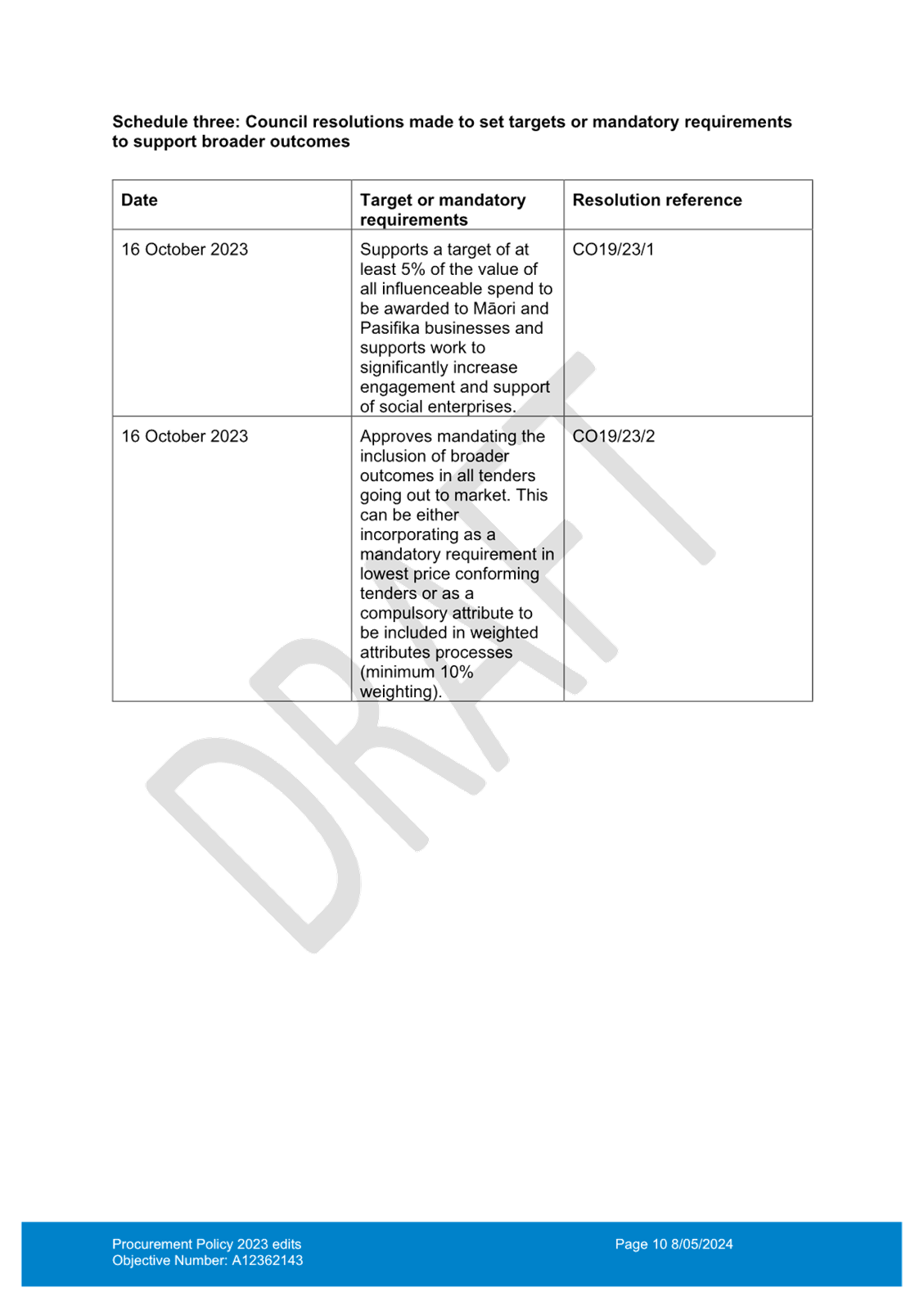
|
Strategy,
Finance and Risk Committee meeting agenda
|
13
May 2024
|
9.5 Annual
Residents Survey Report - Wave 3, 2023/24
File
Number: A15772945
Author: Kathryn
Hooker, Corporate Planner
Authoriser: Christine
Jones, General Manager: Strategy, Growth & Governance
Purpose of the Report
1. The purpose of this
report is to provide an overview of the results from the Annual Residents
Survey for the third quarter (Wave 3).
|
Recommendations
That the Strategy,
Finance and Risk Committee:
(a) Receives the report
"Annual Residents Survey Report - Wave 3, 2023/24".
|
Executive Summary
2. This
report, along with the material in attachment one, provides a high-level summary of the Wave 3 results of the Annual Residents
Survey.
Background
3. The Annual Residents
Survey allows Council to better understand the community’s perception and
satisfaction with Council, its services, functions and activities.
4. 159 surveys via a post
to online method, have been undertaken with Tauranga City residents. An
invitation letter, containing an embedded link to an online survey, was sent to
a random selection of residents, sourced from the Electoral Roll, with a
subsequent reminder follow up.
5. Wave 3 fieldwork was
conducted from 37 February 2024 to 6 March 2024.
Strategic / Statutory Context
6. The Annual
Residents’ Survey allows effective monitoring of performance and insights
to be gained to inform future planning.
Discussion
7. The results of the key
performance indicators include:
· For
2023/24 overall performance, 26% of respondents are satisfied or very
satisfied with Tauranga City Council in general, down from 40% in 2022/23.
· Reputation
measures the community’s perception of four key areas – leadership,
faith and trust, financial management and quality of services/facilities. For
2023/24 reputation, 21% of respondents are satisfied or very satisfied
with Tauranga City Council in general, down from 29% in 2022/23.
· Within
reputation, there is the measure in terms of respondent’s trust in
Council, the year-to-date result is that 21% of respondents are satisfied or
very satisfied, down from the full year result for 2022/23 which was 30%.
· For
2023/24 overall value for money, 36% of respondents are satisfied or
very satisfied with Tauranga City Council in general, down from 38% full year
result of 2022/23.
· A
summary of the rest of the high-level survey results of the 2023/24 full year
compared to 2022/23, and their trend is summarised in the table below:
|
Measure
|
2022/23 result
|
2023/24 result
|
Trend
|
|
Overall
performance
|
40%
|
26%
|
6
|
|
Overall
image and reputation
|
29%
|
21%
|
6
|
|
Overall
value for money
|
38%
|
36%
|
6
|
|
Overall
core services deliverables
|
60%
|
59%
|
6
|
|
Overall
water management
|
56%
|
62%
|
5
|
|
Overall
road and footpaths
|
32%
|
25%
|
6
|
|
Overall
waste management
|
71%
|
71%
|
-
|
|
Overall
outdoor spaces
|
68%
|
74%
|
5
|
|
Overall
public facilities
|
71%
|
70%
|
6
|
Options Analysis
8. There are no options
associated with this report. The report is provided as information only.
Legal implications / risks
9. There are no legal
implications or risks associated with this report.
Consultation / Engagement
10. This report is made public.
Significance
11. The Local Government Act 2002
requires an assessment of the significance of matters, issues, proposals and
decisions in this report against Council’s Significance and Engagement
Policy. Council acknowledges that in some instances a matter, issue,
proposal or decision may have a high degree of importance to individuals,
groups, or agencies affected by the report.
12. In making this assessment,
consideration has been given to the likely impact, and likely consequences for:
(a) The current
and future social, economic, environmental, or cultural well-being of the
district or region.
(b) Any persons who are likely to be
particularly affected by, or interested in, the matter.
(c) The capacity of the local authority to
perform its role, and the financial and other costs of doing so.
13. In accordance with the
considerations above, criteria and thresholds in the policy, it is considered
that the matter is of low significance.
ENGAGEMENT
14. Taking into consideration the above
assessment, that the matter is of low significance, officers are of the opinion
that no further engagement is required prior to Council making a decision.
Next Steps
15. The final wave (Wave 4) for 2023/24
is due to be collected during May - June 2024 with the results scheduled to be
reported to this committee in August 2024.
Attachments
1. Annual
Residents Survey 2023_24 Wave 3 - Performance Report - A15844100 ⇩ 
|
Strategy,
Finance and Risk Committee meeting agenda
|
13
May 2024
|
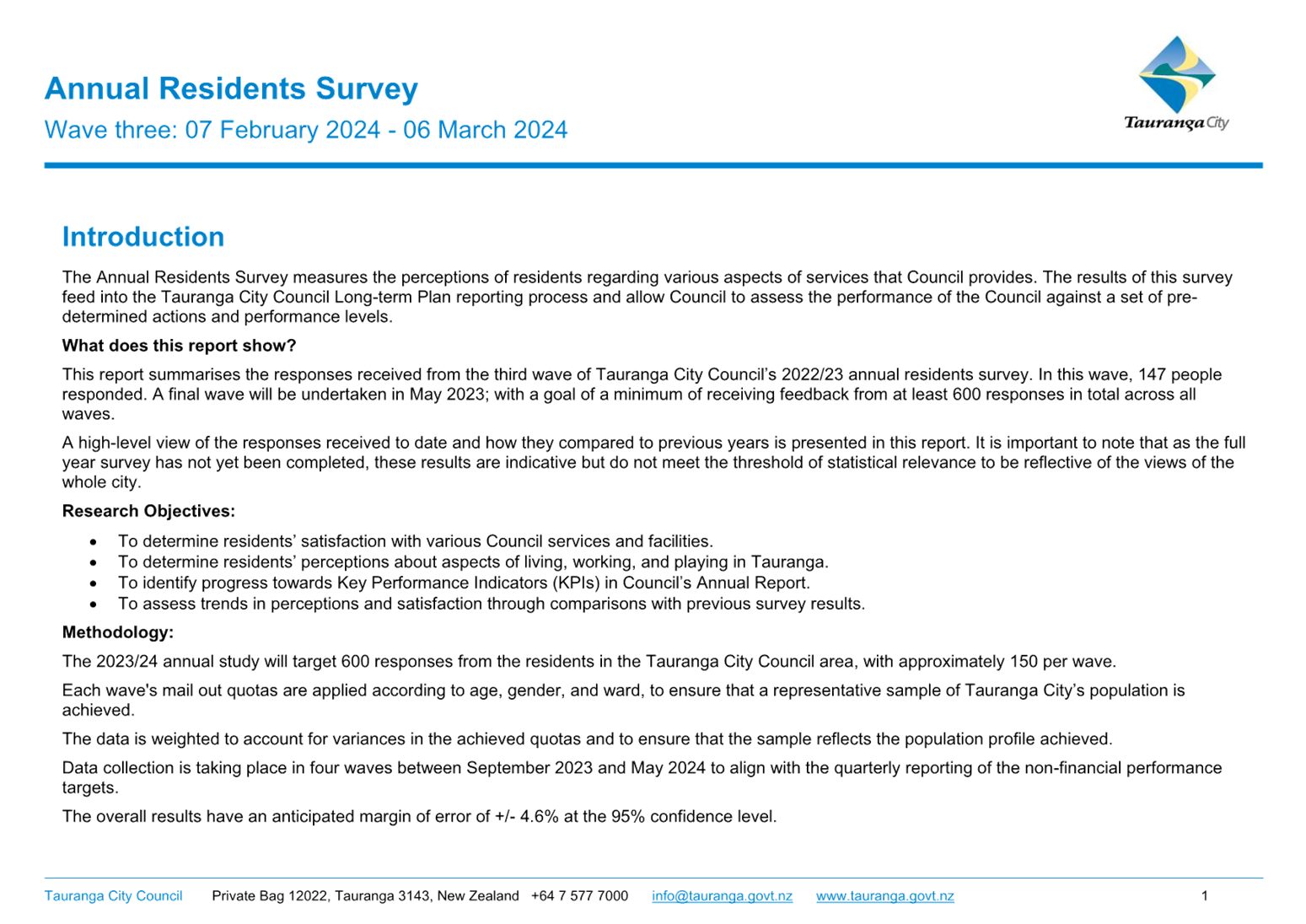









|
Strategy,
Finance and Risk Committee meeting agenda
|
13
May 2024
|
9.6 LGOIMA
and Privacy Report Q3 for 2023/2024 year
File
Number: A15882329
Author: Darelle
Howard, Administrator: Democracy Services
Authoriser: Christine
Jones, General Manager: Strategy, Growth & Governance
Purpose of the Report
1. The purpose of this report is to update the Committee on
Local Government Official Information and Meetings Act 1987 (LGOIMA) and
Privacy requests for the third quarter of 2023/24
|
Recommendations
That the Strategy,
Finance and Risk Committee:
(a) Receives the report
“LGOIMA and Privacy Report Q3 for 2023/2024 year.
|
Executive Summary
2. These reports are
provided to the Committee to provide assurance on statutory compliance for
LGOIMA and Privacy requests.
Attachments
1. Q3
Report LGOIMA and Privacy requests - Jan-Mar 2024 - A15882301 ⇩ 
|
Strategy,
Finance and Risk Committee meeting agenda
|
13
May 2024
|
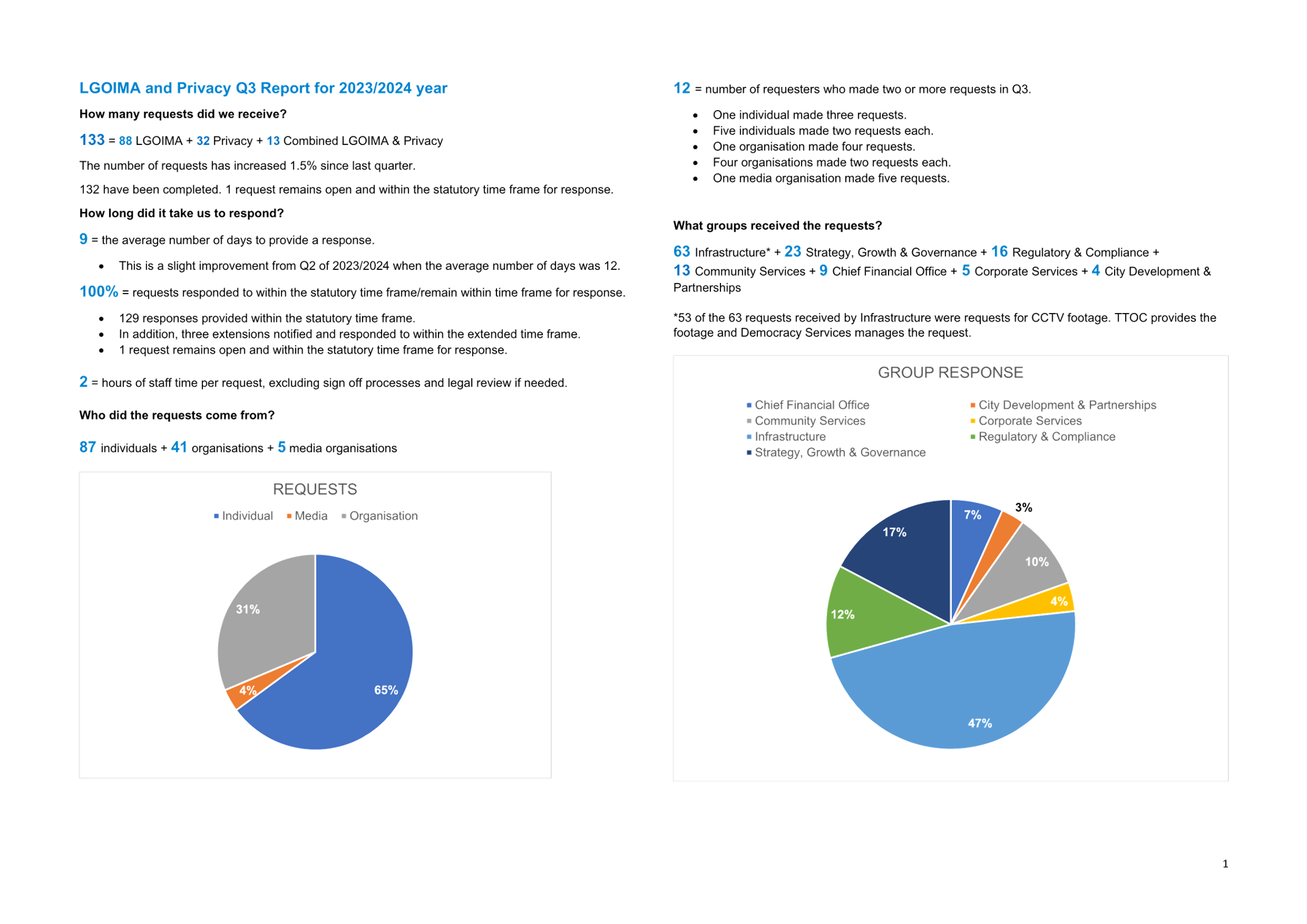
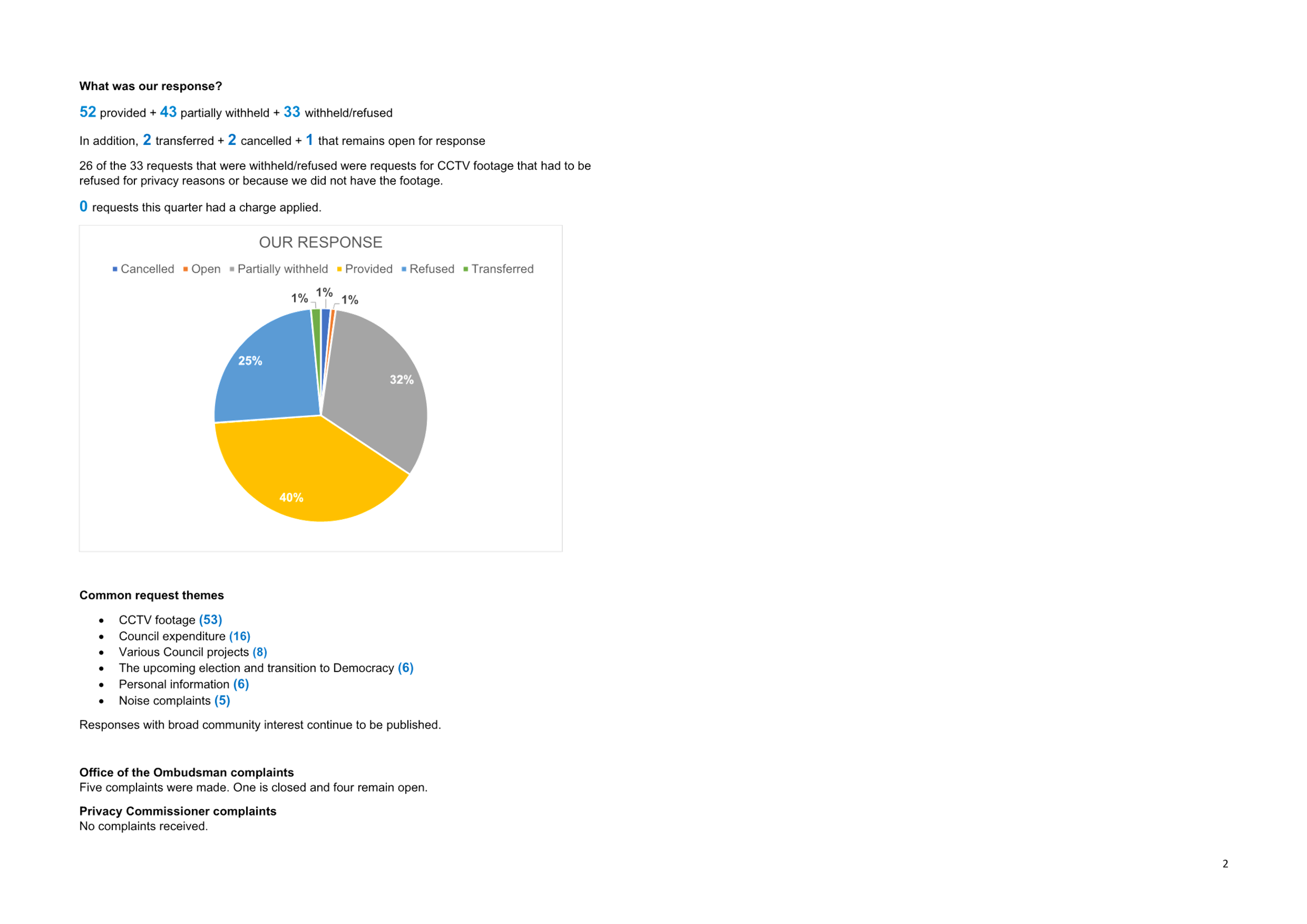
|
Strategy,
Finance and Risk Committee meeting agenda
|
13
May 2024
|
9.7 Health
& Safety Report - Q3 - January to March 2024
File
Number: A15889994
Author: Stuart
Kokaua, Health, Safety and Wellbeing System Support
Authoriser: Alastair
McNeil, General Manager: Corporate Services
Purpose of the Report
1. To provide a summary of
Health, Safety and Wellbeing activities over the January to March 2024 quarter.
|
Recommendations
That the Strategy,
Finance and Risk Committee:
(a) Receives the report
"Health & Safety Report - Q3 - January to March 2024".
|
Executive Summary
2. This is a quarterly
report provided to the Committee, designed to monitor Health, Safety and
Wellbeing activities, and share learnings.
3. Any feedback regarding
content or topics that the committee would like is welcomed.
Attachments
1. Health
& Safety Report - Q3 - January to March 2024 - A15832845 ⇩ 
|
Strategy,
Finance and Risk Committee meeting agenda
|
13
May 2024
|
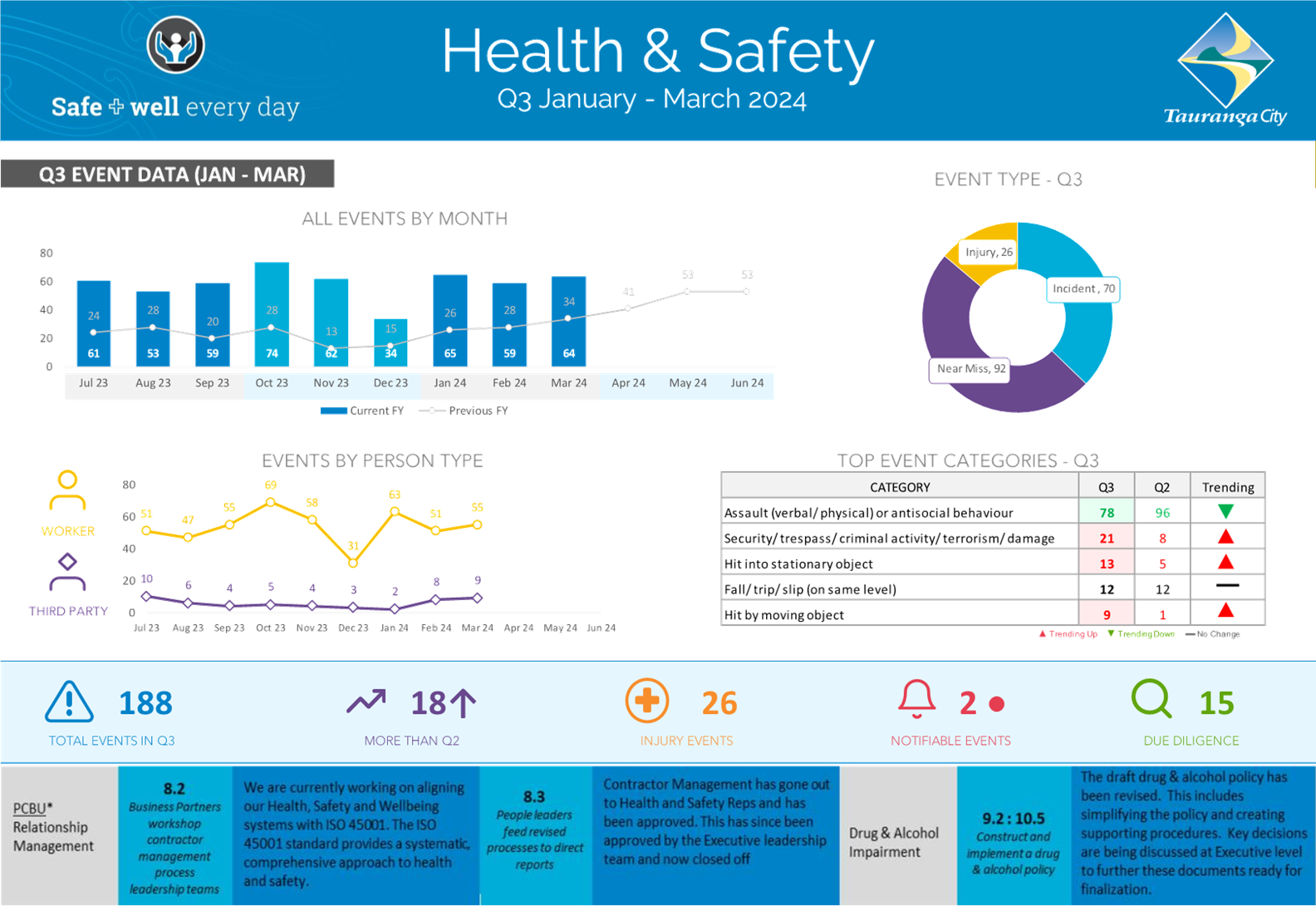

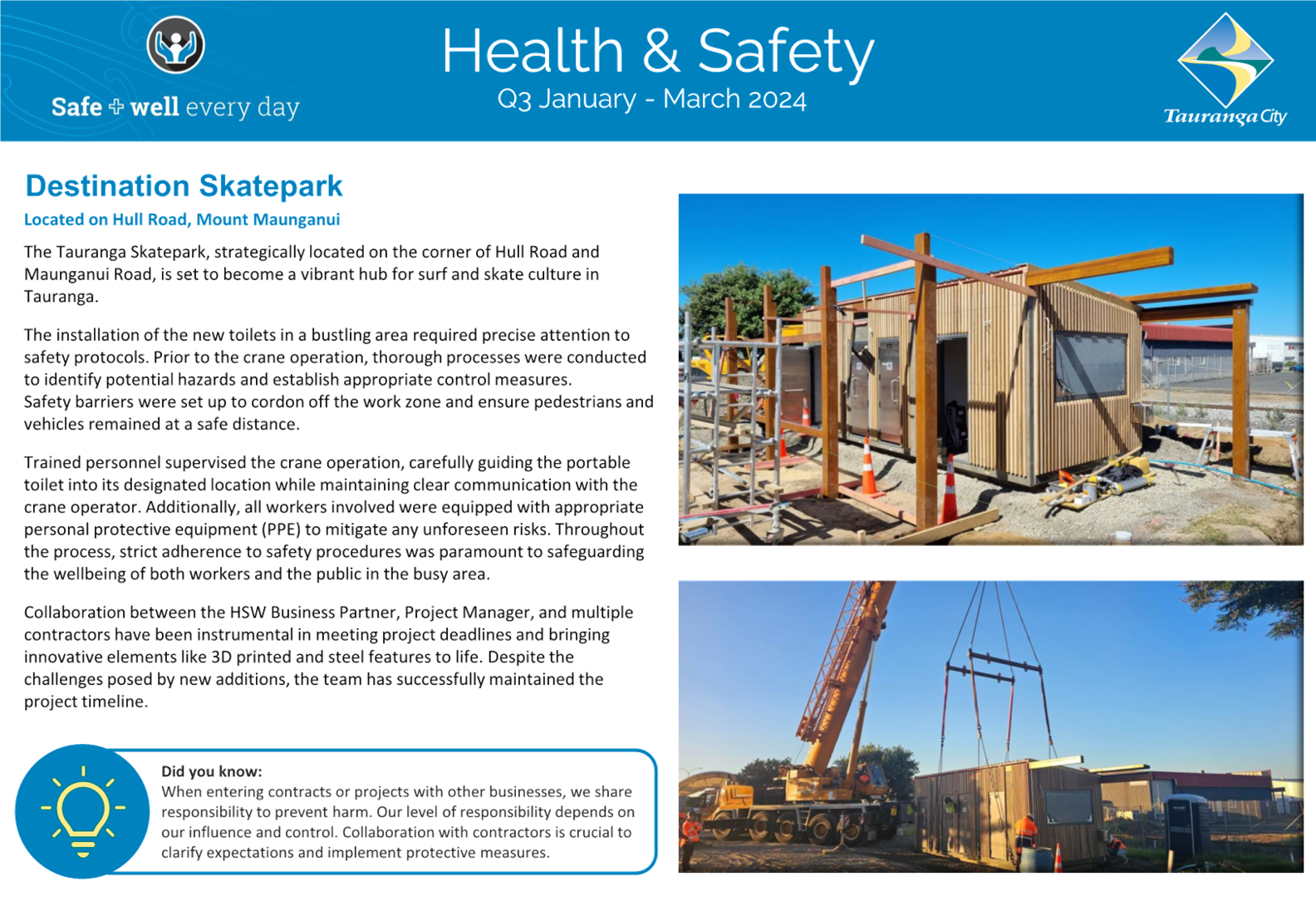
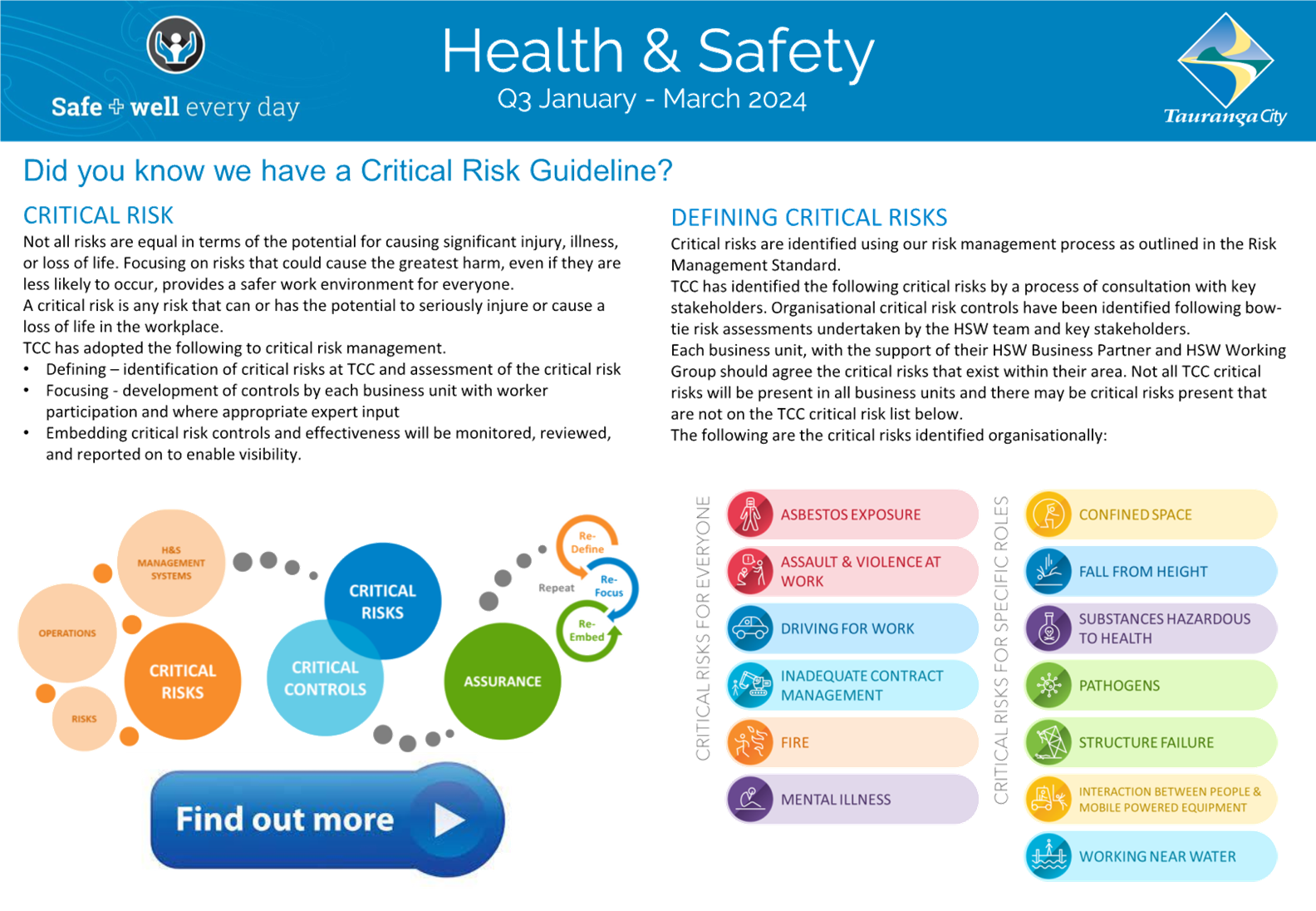
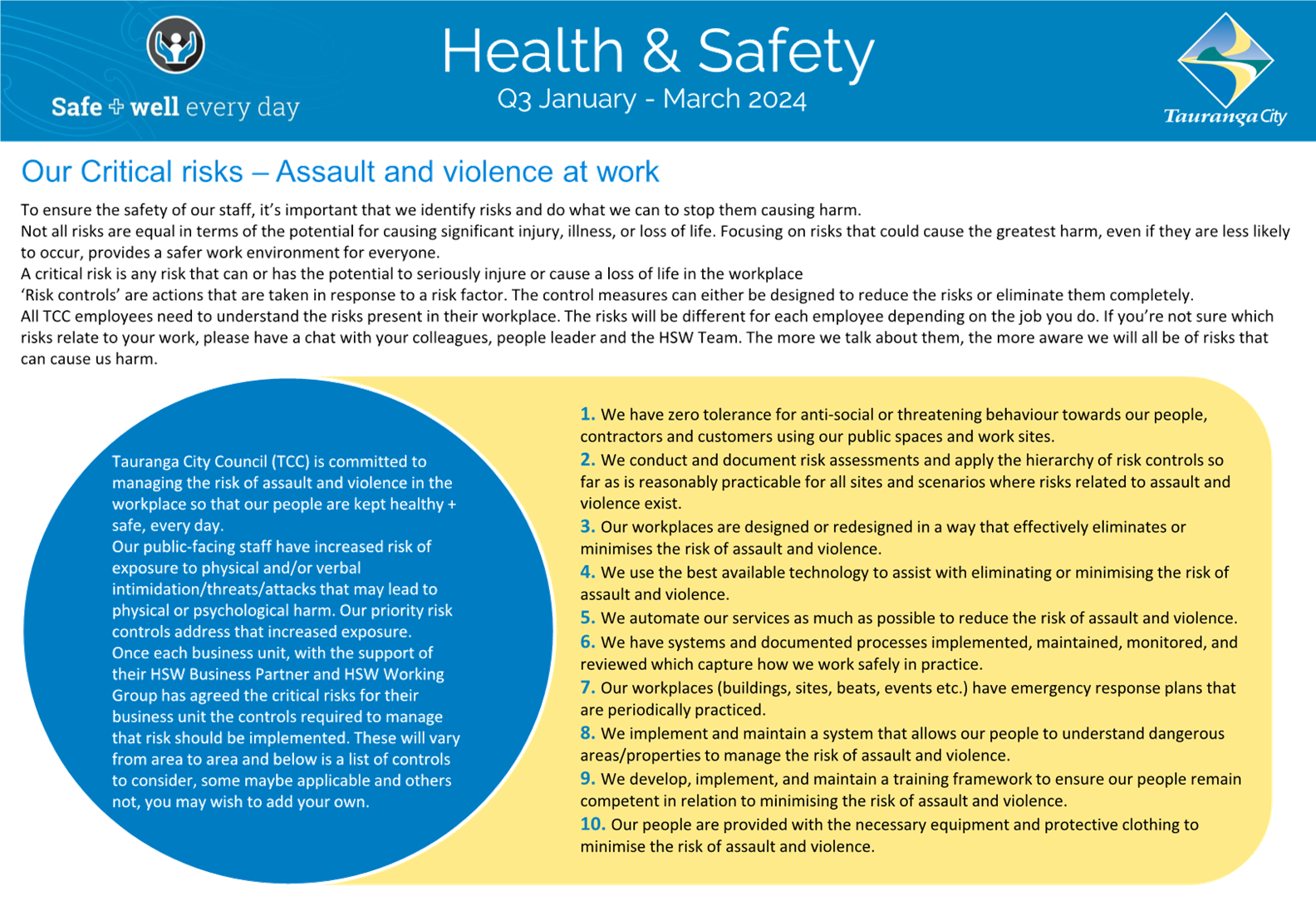
|
Strategy,
Finance and Risk Committee meeting agenda
|
13
May 2024
|
9.8 Quarterly
Financial Monitoring Report for the Nine Months to 31 March 2024
File
Number: A15814486
Author: Tracey
Hughes, Financial Insights & Reporting Manager
Kathryn Sharplin,
Manager: Finance
Authoriser: Paul
Davidson, Chief Financial Officer
Purpose of the Report
1. The purpose of this
report is to provide an update on the financial performance of Council against
budget for the nine months to 31 March 2024.
|
Recommendations
That the Strategy,
Finance and Risk Committee:
(a) Receives the report
"Quarterly Financial Monitoring Report for the Nine Months to 31 March
2024".
|
Executive Summary
2. This
report, along with the material in Attachment 1, outlines
Council’s financial performance against budget for the nine months to 31
March of the 2023-24 financial year. The Statement of Comprehensive Revenue and
Expense (SOCRE), along with capital reporting and treasury performance are
presented and variances explained in Attachment 1.
3. The
overall operating deficit for the first nine months is $47.2m, which is $11.8m
unfavourable to budget, with key driver being depreciation at $9m over budget.
Unfavourable variances across other categories are largely offset by higher
revenue.
4. Total
operating expenditure is forecast to be significantly above budget for the year
($44m). Most of the overspend is not funded by rates in the current year as it
relies on carried forward funding (related to expenditure budgeted in 2023 that
was not spent), loan-funded expenditure (e.g. digital development and Tauriko
West), and unfunded depreciation.
5. The
full year forecast for development contributions has been reduced by $17.5m
reflecting reduced volumes of new dwelling consents. This reduction in revenue
will impact the forward debt position.
6. There
is a risk that the overall rates requirement for the year may be $2-$3m
(approximately 1%) above what has been collected based on current forecast,
which would then increase loans. The Executive continues to monitor and
mitigate the forecast position. Specific analysis is being prepared on the
forecast above budget expenditure on digital development, noting this would not
be directly rate funded whether operating or capital in nature.
7. Capital
Expenditure of $248m has been delivered which compares to the year-to-date
revised budget of $270m, excluding vested assets and projects delivered by
third parties and operational projects of a capital nature (Digital and Tauriko
West). Full year forecast is currently $395m, lower than forecast in Quarter 2.
This is an optimistic forecast which would require monthly expenditure in the
last quarter of the year to be significantly in excess of what has been
achieved to date. If this forecast is not achieved, the debt position at year
end would be more favourable than currently forecast, and a higher level of
carry forwards would be requested.
8. Gross
debt is $1.15b at 31 March and net debt is $937m with $213m held in bank
balances and term deposits.
Background
9. This
report is for monitoring and reporting purposes showing Council’s third
quarter financial performance against Annual Plan budgets, the basis for our
annual reporting. For management purposes budgets are adjusted for
carried forward expenditure and associated funding from the prior year,
reflected as the Revised Budget in the SOCRE.
10. The revised budget
is provided in the SOCRE as it gives context to the forecast year end position,
and they provide similar operating deficit outcomes.
DISCUSSION
Part 1: Financial Performance
11. The financial
results to 31 March 2024, which is the third quarter of the 2023-24 year are
provided as Attachment 1 to this report.
12. Forecasts have
been reviewed, indicating that an increase in the operating deficit of $32m is
expected against annual plan, however this is $10m less than forecast at
quarter two. Forecasts include the impacts of items carried forward from the
prior year as well as updated expectations.
13. The overall year
to date operating deficit is $11.8m unfavourable to budget. There are a
number of variances that relate to timing of revenue or expenditure.
Expenditure
14. Operating
expenditure is tracking slightly above budget as shown in the graph below with
the main drivers of increased expenditure impacting from November.
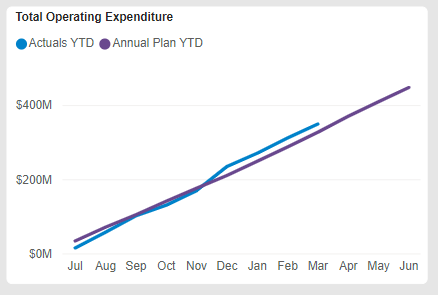
15. The main drivers
of expenditure are as follows:
(a) Depreciation
is $9m over budget year to date and is expected to be $12m over budget for the
full year. Depreciation is reported as calculated through the fixed assets
register (since November) and includes all impacts of revaluation and
capitalisation from 2023. The 2023 revaluations were finalised after the 2024
Annual Plan adoption, and as the waters revaluation in particular was very
significant, this has had a similarly significant impact on depreciation, over
budget. The additional depreciation will not be funded in the current year.
(b) Personnel
costs are $2.6m over budget currently and are forecast to be $2.6m over budget
for the full year most of which is in loan-funded digital projects. Direct
salary costs are under budget for the year. Capitalisation in the transport
activity is above budget, however much of the time spent on Digital projects
cannot now be capitalised, leading to a negative year to date variance of
$2.1m. Salary savings are not being realised as replacement staff are employed
quicker than anticipated and the impacts of restructures are also expected to
affect the full year position. These impacts are expected to be offset
elsewhere.
(c) Finance
costs are $4.8m over budget resulting from higher opening balances and higher
rates than had been anticipated in the annual plan. This is currently
substantially offset by finance revenue ($4.7m over budget year to date), for
the same reasons. The forecast for finance costs net of revenue is projected to
be $1.6m over budget for the year, impacted by elevated interest rates and a
slightly higher forecast debt position. This would generate an additional rates
requirement of approximately $1.1m. If the current Capital forecast is not achieved,
the overspend in interest for the year will be reduced.
(d) Other
expenditure is currently $6.1m over budget and forecast to be $24.2m over
budget for the full year. Overall however, most of this variance will not
impact rates funding as follows:
(i) A
significant proportion of both year-to-date expenditure and forecast is related
to items initially budgeted and funded in the 2023 financial year and brought
forward ($9.3m), mainly community contributions and grants.
(ii) Items that
are or are likely to become loan-funded ($15.4m) such as Tauriko West (timing
adjustments only), business case development and software development charges
(budgeted as capital).
(iii) Digital budgets
whether operational or capital have been put under pressure by the need to
respond to new business requests and the impact of this is being monitored.
(e) More
detailed information on how expenditure is tracking by activity can be seen in Attachment
1.
Revenue
16. Operating revenue
is currently $10.7m ahead of budget, and capital revenue $17.5m behind as
follows:
(a) Rates
revenue is currently $2.2m ahead of budget and will remain ahead of budget to
the end of the year. A portion of this is for kerbside collection, with the
remainder a result of identifying additional rating units after the adoption of
the rates resolution.
(b) Metered
water revenue is nearly $2m ahead of budget for the nine months. Full year
revenue is expected to be ahead of budget but by less than it is year to date
as demand drops off over the Autumn/Winter period.
(c) Subsidies
and grants are slightly behind budget (1.7%) for the year to date and expected
to be 3.4% behind annual plan budget for the full year. Subsidies and grants
relating to capital projects carried forward from 2023 are included in the
forecast, along with additional revenue agreed with NZTA Waka Kotahi.
Offsetting these favourable forecast increases are:
(i) A
reduction in expected revenue relating to subsidies for work on Waters reform.
(ii) Updates on timing of expected Tauriko
West IFF subsidies.
(iii) Further central
government grants relating to the Te Maunga Redevelopment are no longer
expected as the project is on hold.
(iv) $3.9m of grants
related to Community amenity has been either delayed to 2025 (Merivale
Community Centre) or will no longer eventuate (Gordon Spratt Reserve shared
club).
The net result of these impacts on the full year subsidy revenue
forecast is a decrease of $4.2m, across both capital and operational subsidies.
(d) Fees and
Charges are above budget for the nine months by $2.4m and expected to remain so
to the end of the year.
(i) $690k
additional revenue in Wastewater has been generated by demand from Omokoroa
residents (utilising capacity in the Chapel St treatment plant).
(ii) $900,000 of
revenue has been recognised in Building services that was recorded as
pre-receipts at 2023 year end.
(iii) A focus on
business process has maintained revenue in Environmental Planning, despite
reduced volumes.
(iv) Other above
budget revenue areas are Parking Management and Baycourt.
(e) Growth-related
revenue including development contributions and vested assets are below
budget. Revenue is recognised as building and subdivisions occur or as
developers complete and vest assets to council. The full year forecast for
development contributions has been reduced by $17.5m reflecting reduced volumes
of new dwelling consents. This reduction in revenue will impact the forward
debt position.
Capital Expenditure
17. Capital
expenditure (including operational projects of a capital nature but
excluding land sales and vested assets) of $278.4m has been delivered at the
end of the third quarter, which compares to the year-to-date budget of $309.7m.
The full year forecast has been revised to $435.3m, which is $35.7m below the
revised budget (including carry forwards from 2023). The main variances
driving this forecast are:
(a) Delayed
delivery of the Civic Admin Building fit out and Art Gallery refurbishment.
(b) Delay in
the commencement of the construction of the Gordon Spratt Sports Pavilion. This
work is now underway, with the contractor established onsite.
(c) Delayed
delivery of Memorial Park Aquatics due to a change in the procurement strategy.
A revised procurement strategy will be presented to the TMOTP Ltd Board for
approval in May.
(d) Construction
delays for Tauriko West projects, as a result of scope adjustment.
(e) NZTA subsidy on Grenada Street Cycleway
has been revoked. Work on this project has paused while alternative funding
sources are being explored.
18. The original annual plan budget was $397m
however on 4 September it was revised to $496m by Council. Since then budgets
have been revised and further changes to the timing of budgets resulting in a
revised budget of $471m. This is summarised in the graph below. Attachment
2 details capital budget adjustments over the year approved either by
Council decision or by the CE under delegation.
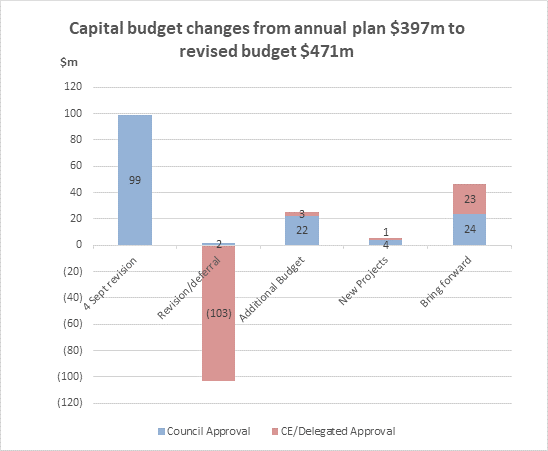
Treasury
19. The treasury
report in Attachment 1 shows gross debt at 31 March 2024 as $1.15bn and
net debt as $937m. Interest rate hedging and debt maturity profiles
remain within Treasury policy, however approximately $40m of hedging will be
required prior to 30 June to ensure the fixed debt profile remains within
policy . Approved debt issuance for the year is $275m which aligns to the
2024 Annual Plan borrowing limit. Council has also approved $42m of
additional borrowing for specific bring forwards, unbudgeted spends and land
purchases which have occurred during the year. At this stage the
additional approved borrowing has not been required as underspends in other
areas have offset the additional spend.
20. The OCR has
remained at 5.5% since 24 May 2023 with the next reserve bank monetary policy
announcement on 22 May 2024. While the OCR remains relatively high,
Council’s average cost of borrowing including margins is 4.60% and the
average investment rate is currently 5.88%.
OPTIONS ANALYSIS
21. There are no options associated
with this report. The report is provided as information only.
FINANCIAL CONSIDERATIONS
22. This report monitors performance to
budget to ensure council delivers on proposed expenditure within allocated
budgets to ensure financial sustainability and accountability.
STRATEGIC/STATUTORY CONTEXT
23. Maintaining
expenditure within annual plan budget ensures delivery of services in a
financially sustainable way. Variance review assists in identifying risks and
trends facing council.
Legal Implications / Risks
24. This monitoring report has no
specific legal implications or risks.
Consultation / Engagement
25. This report is made public.
Significance
26. The Local Government Act 2002
requires an assessment of the significance of matters, issues, proposals and
decisions in this report against Council’s Significance and Engagement
Policy. Council acknowledges that in some instances a matter, issue,
proposal or decision may have a high degree of importance to individuals,
groups, or agencies affected by the report.
27. In making this assessment,
consideration has been given to the likely impact, and likely consequences for:
(a) The current
and future social, economic, environmental, or cultural well-being of the
district or region.
(b) Any persons who are likely to be
particularly affected by, or interested in, the matter.
(c) The capacity of the local authority to
perform its role, and the financial and other costs of doing so.
28. In accordance with the
considerations above, criteria and thresholds in the policy, it is considered
that the matter is of low significance.
ENGAGEMENT
29. Taking into consideration the above
assessment, that the matter is of low significance, officers are of the opinion
that no further engagement is required prior to Council making a decision.
Next Steps
30. This report
ensures monitoring of Council performance to ensure compliance with
Council’s budgets, policies and delegations. The non-financial
monitoring report summary will be presented on the Council website.
Attachments
1. Opex,
Capex and Treasury reports Q3 - A15883380 ⇩ 
2. Changes to capital
budgets 2023/24 - A15893770 ⇩ 
|
Strategy,
Finance and Risk Committee meeting agenda
|
13
May 2024
|
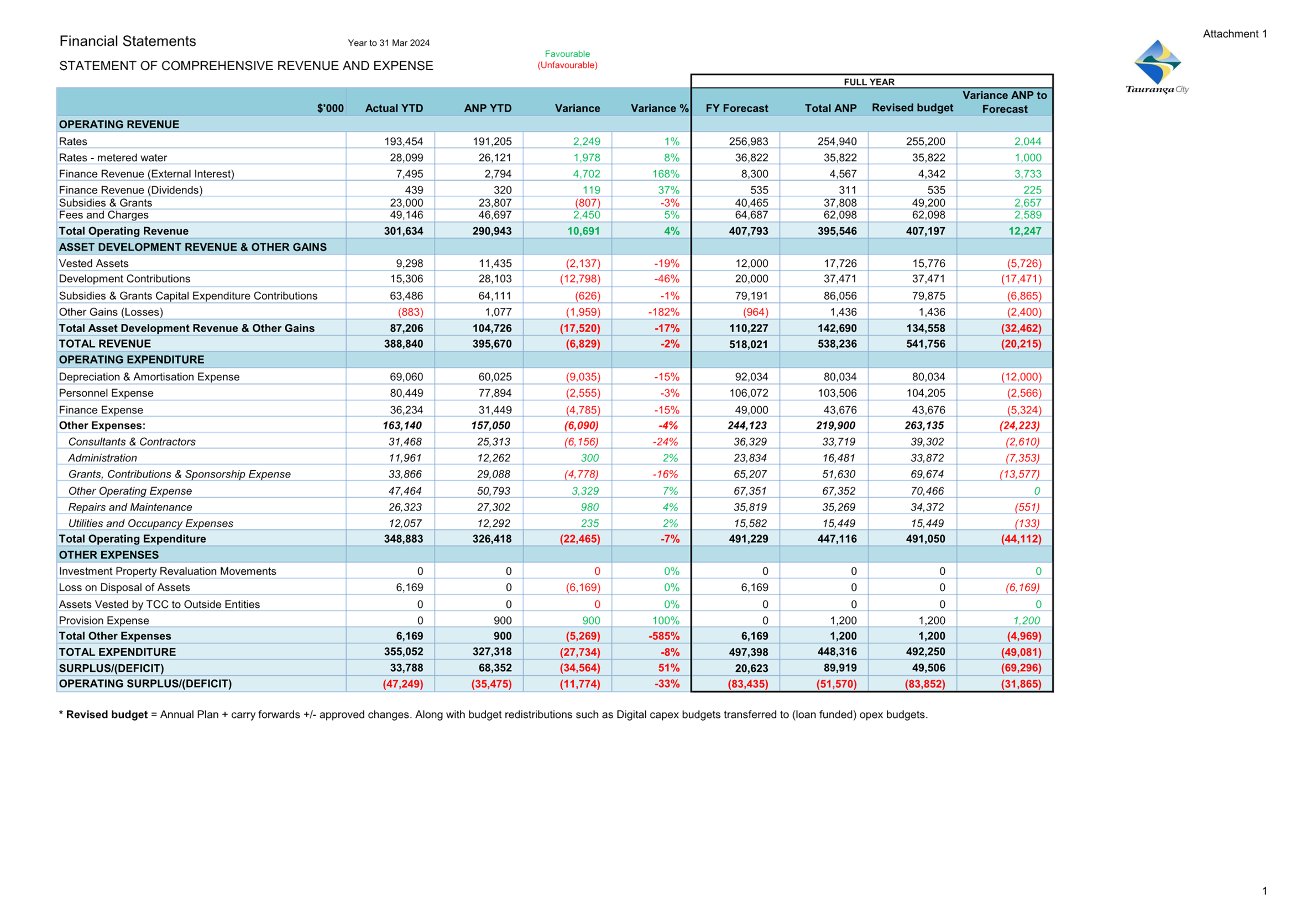
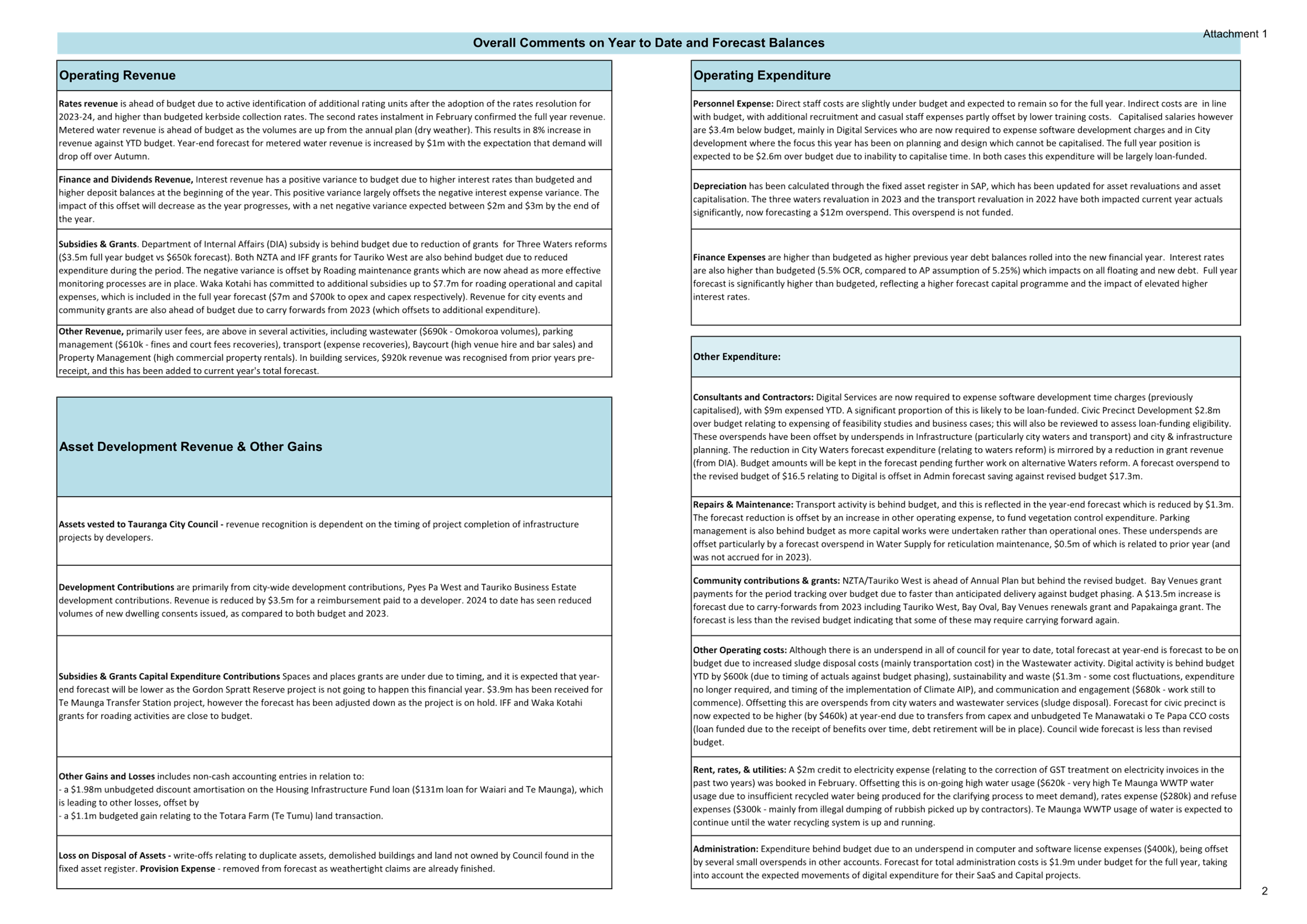
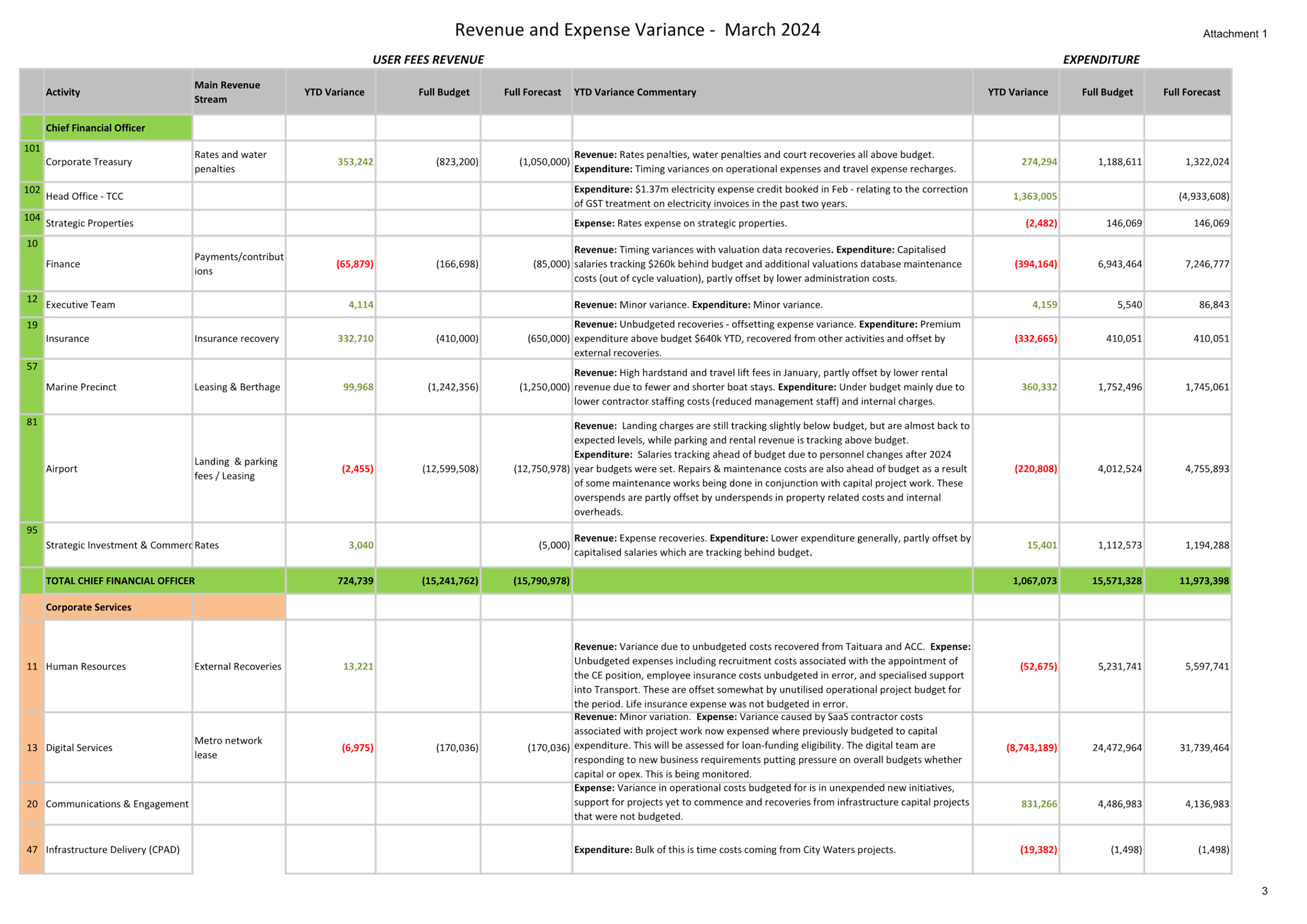
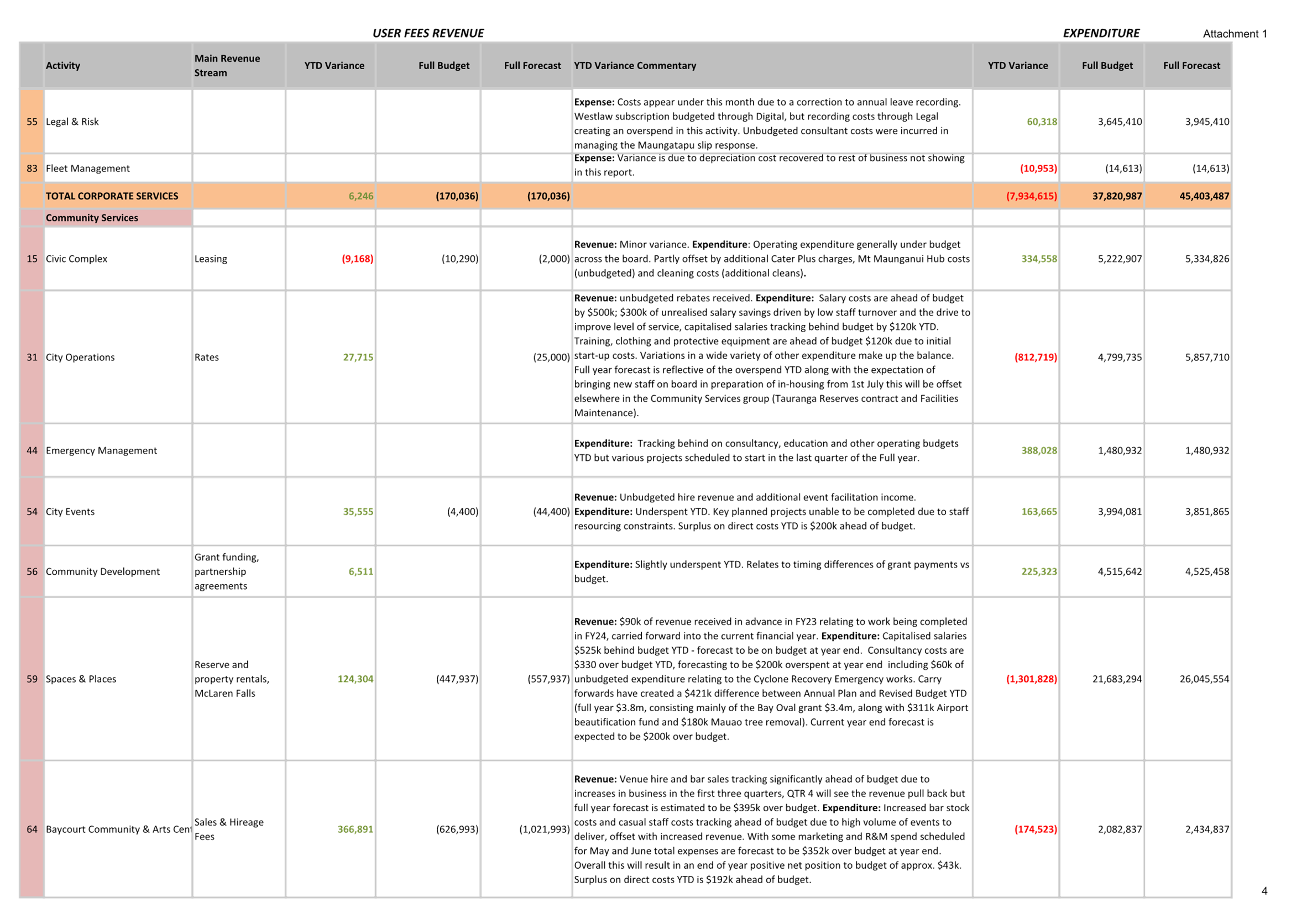
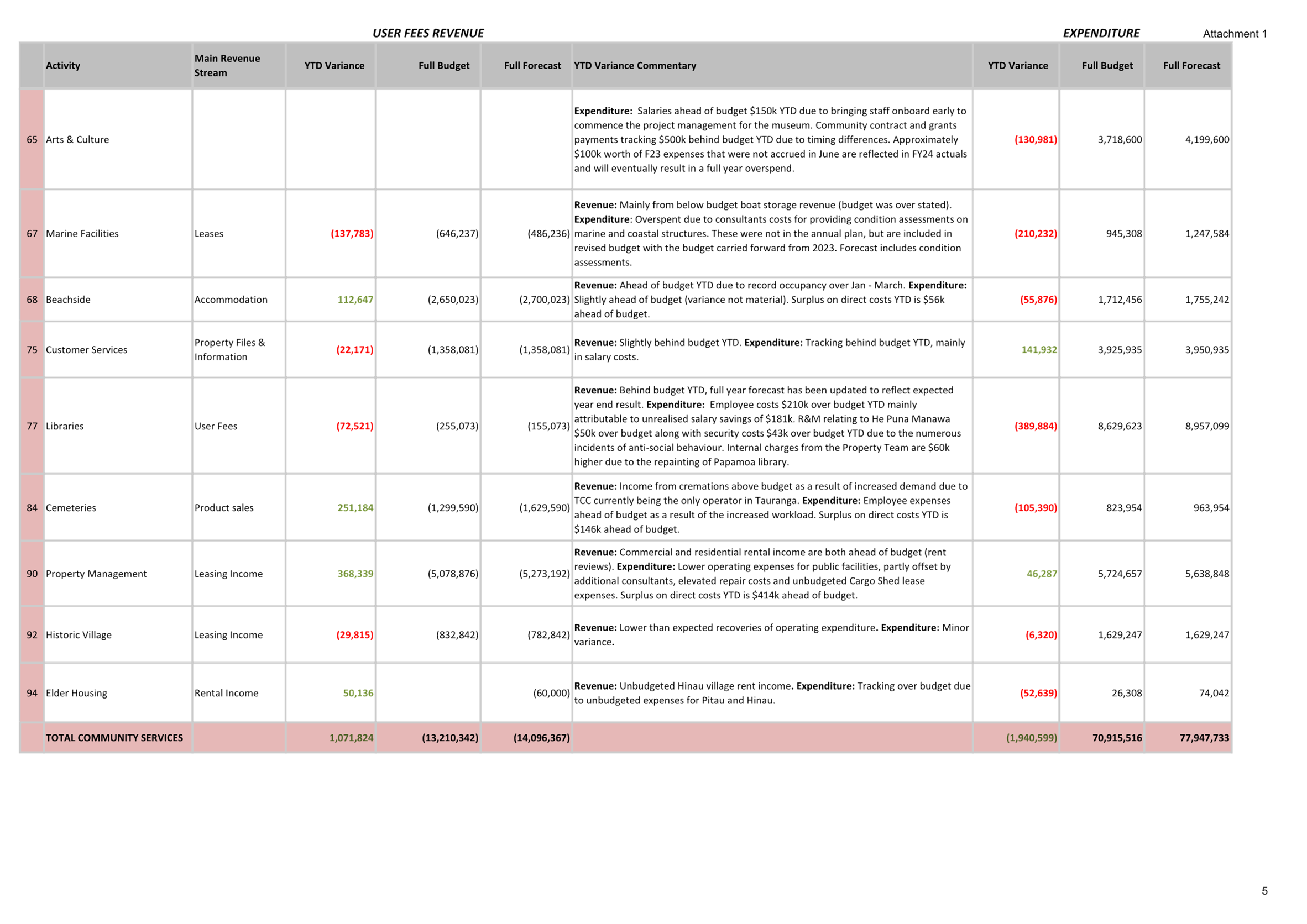
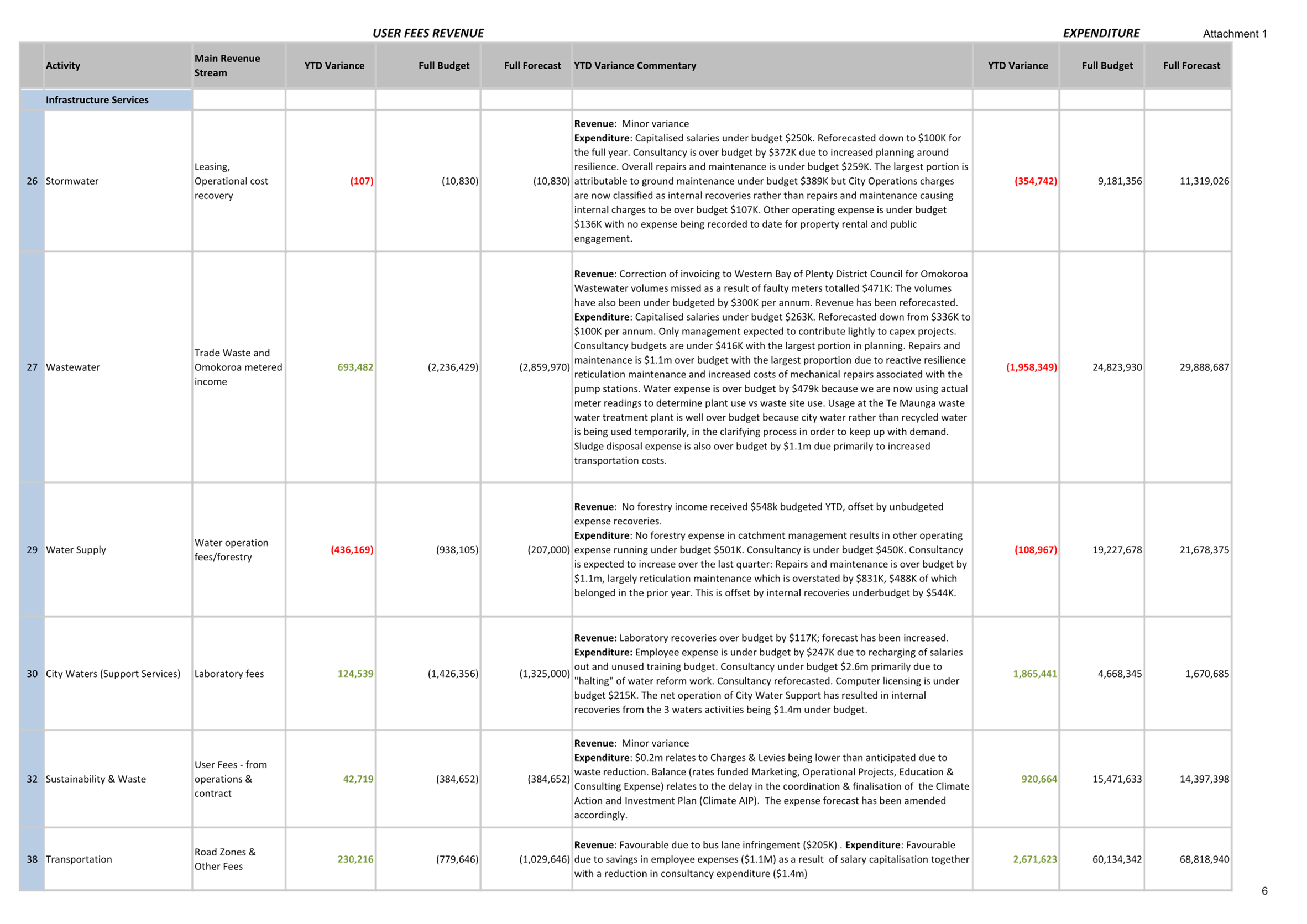
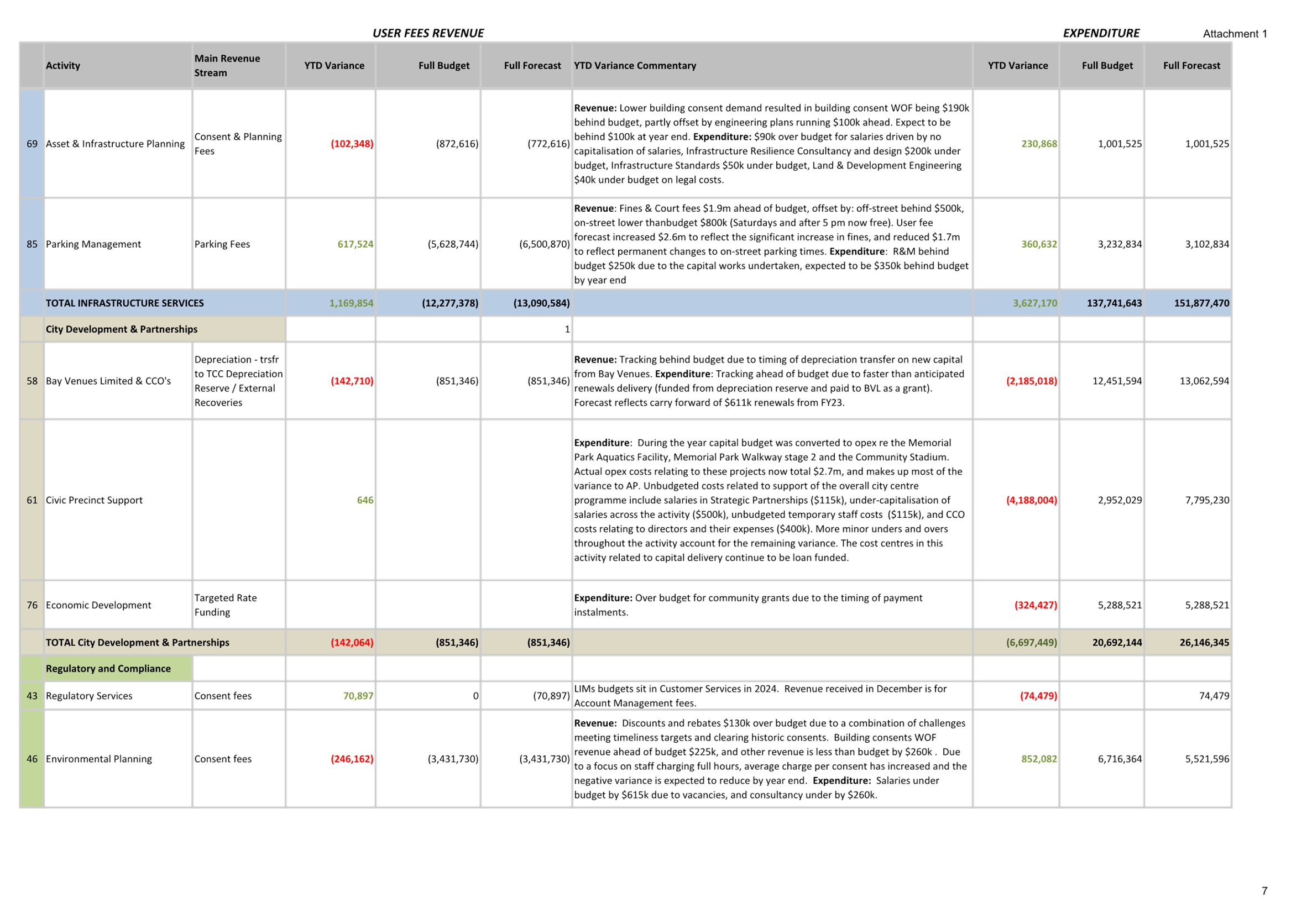
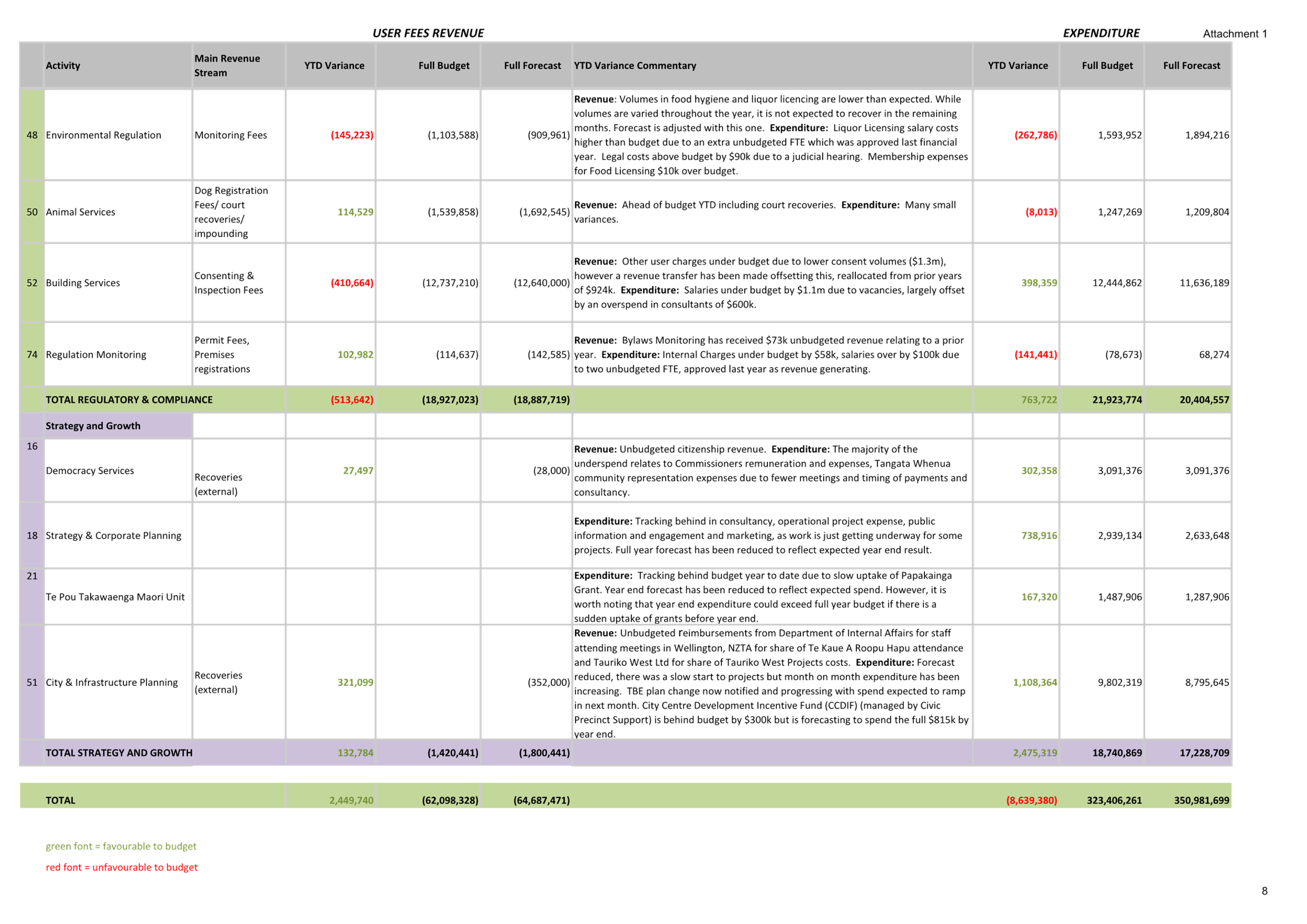
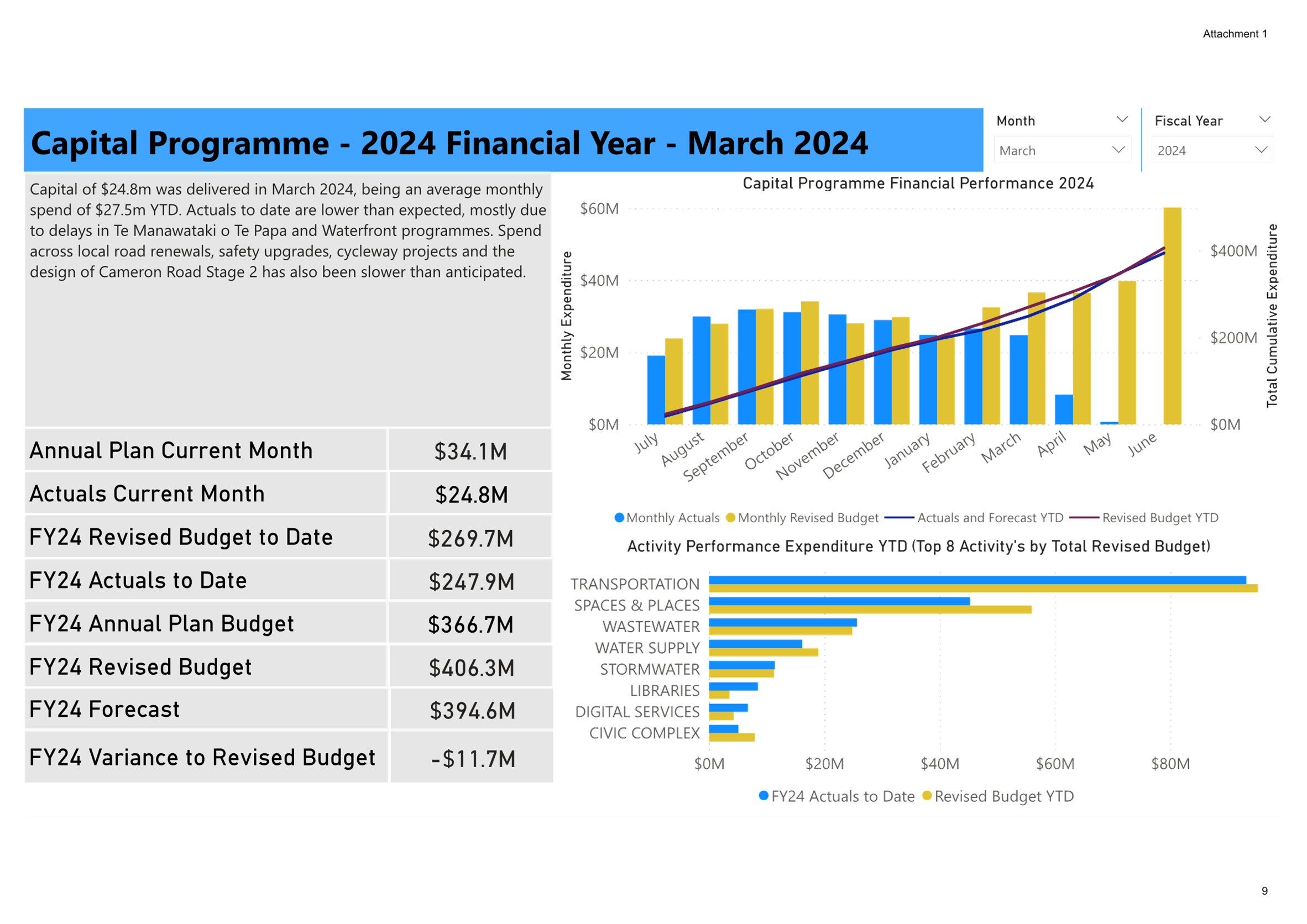
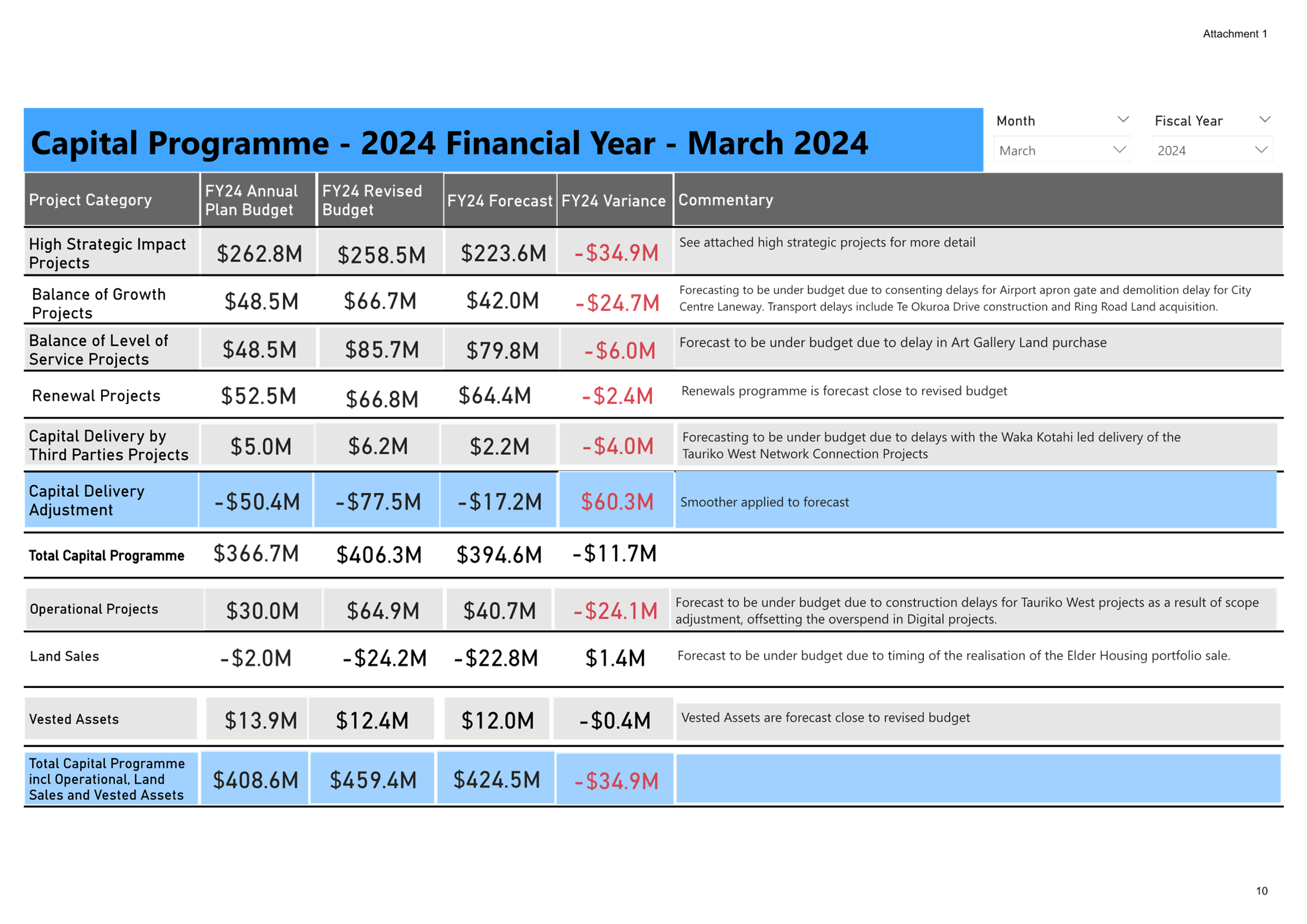
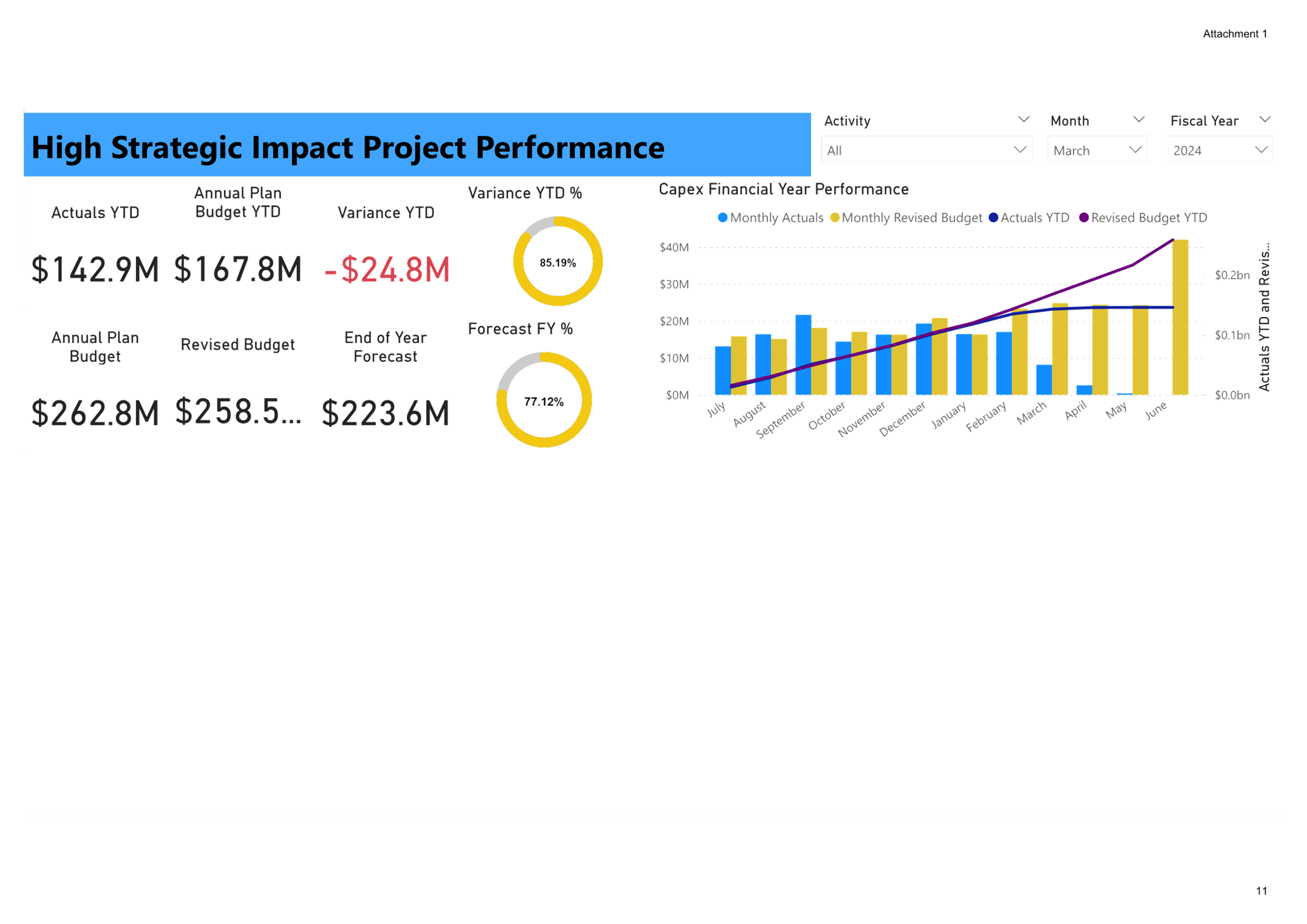
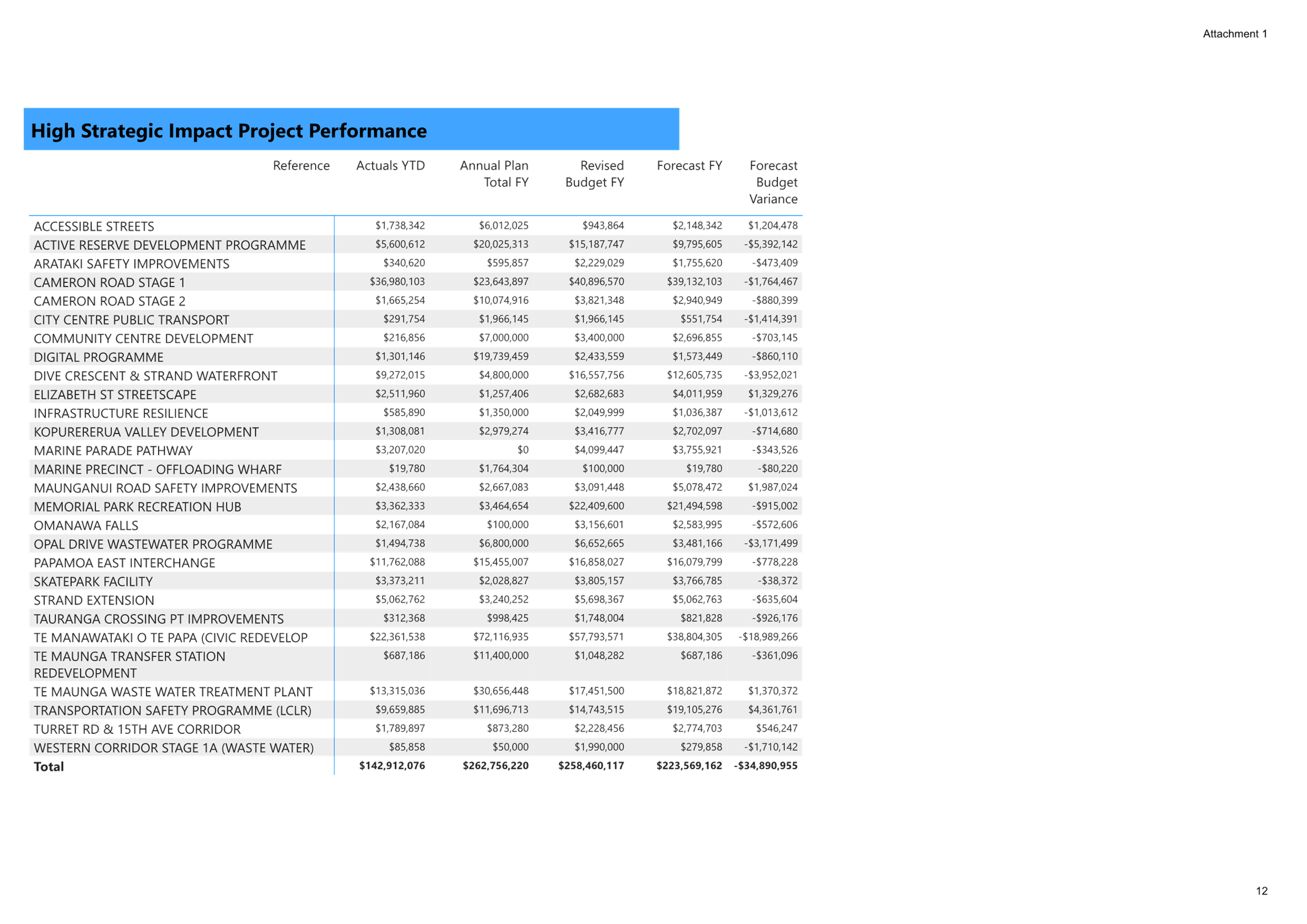
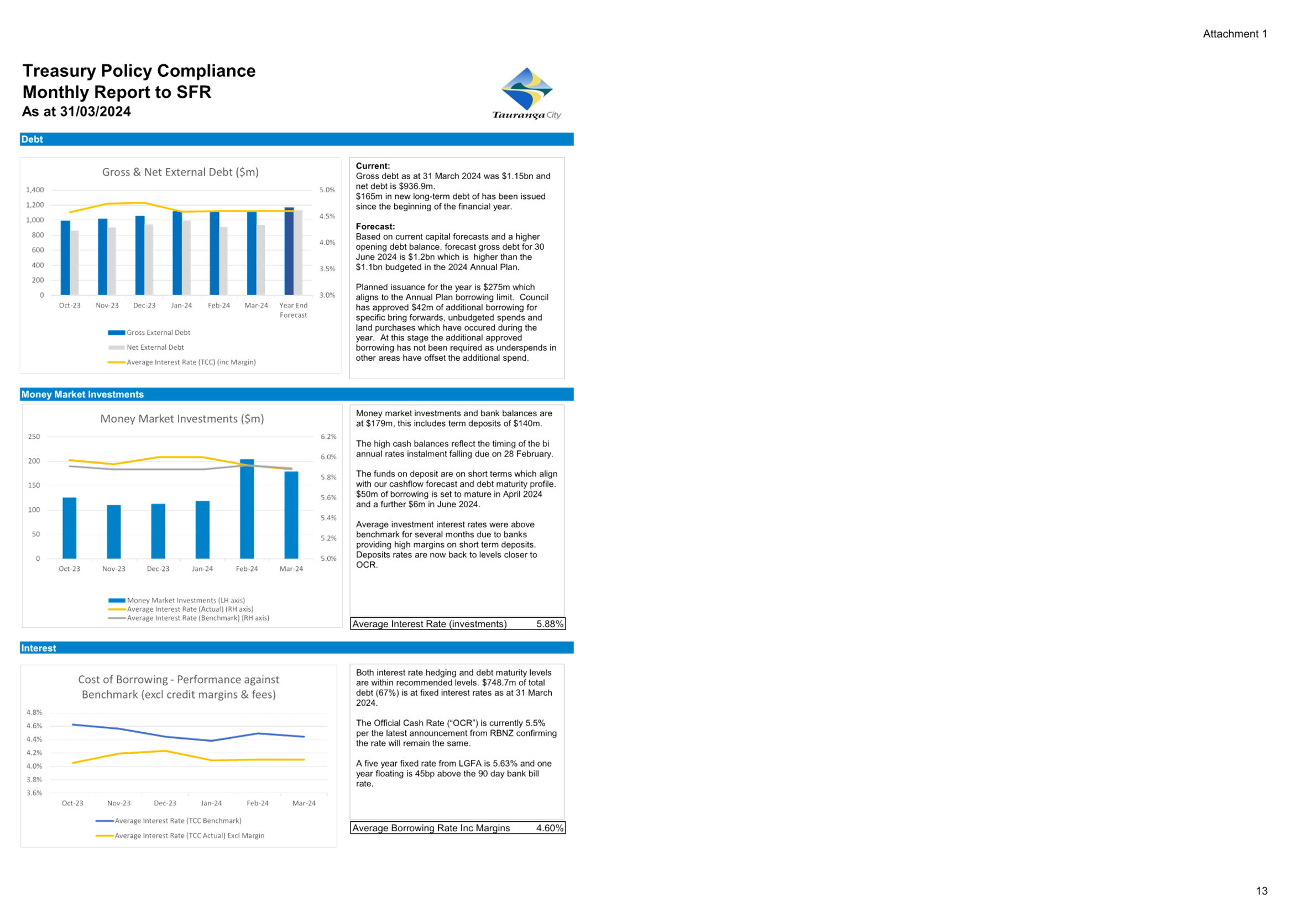
|
Strategy,
Finance and Risk Committee meeting agenda
|
13
May 2024
|
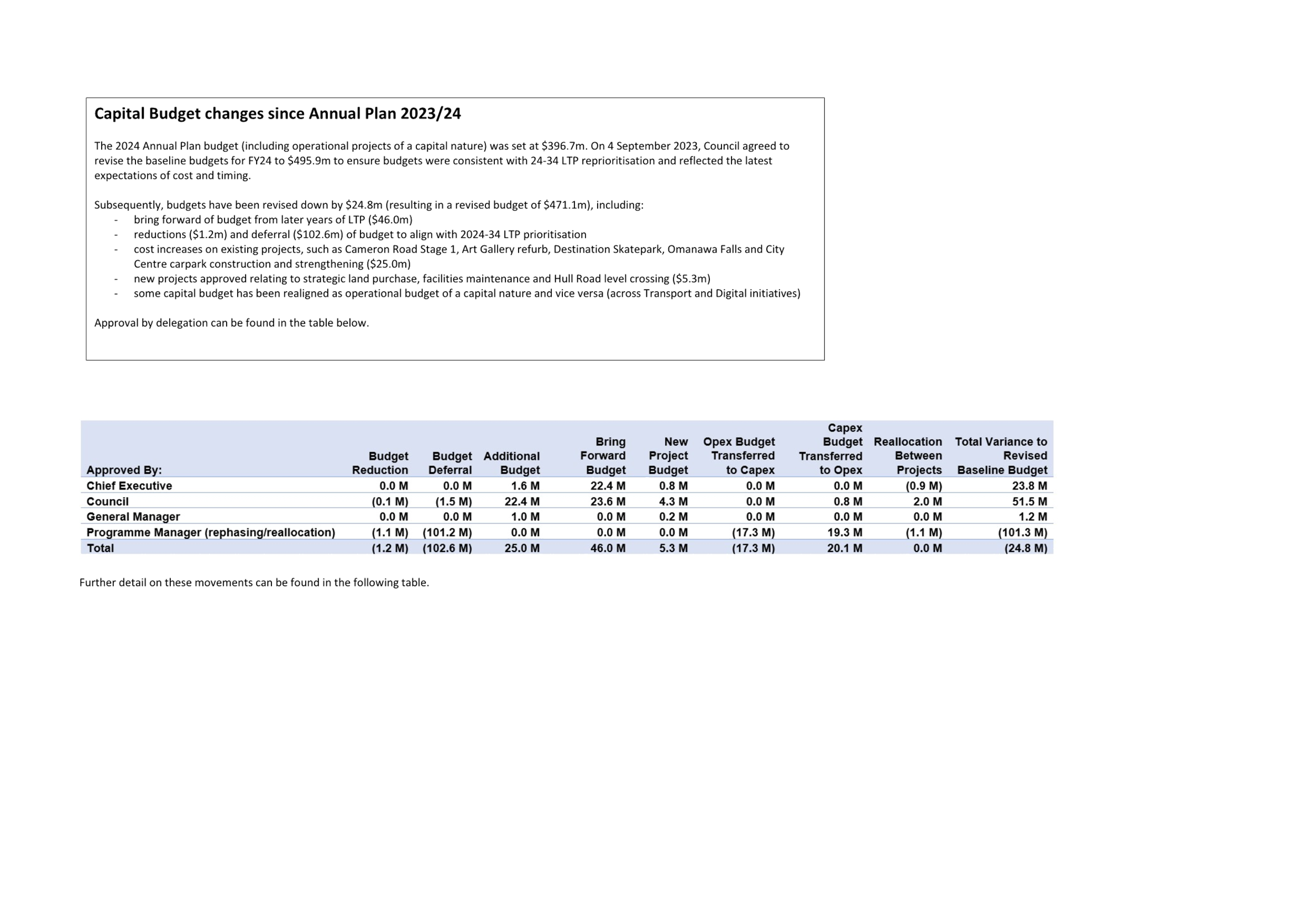
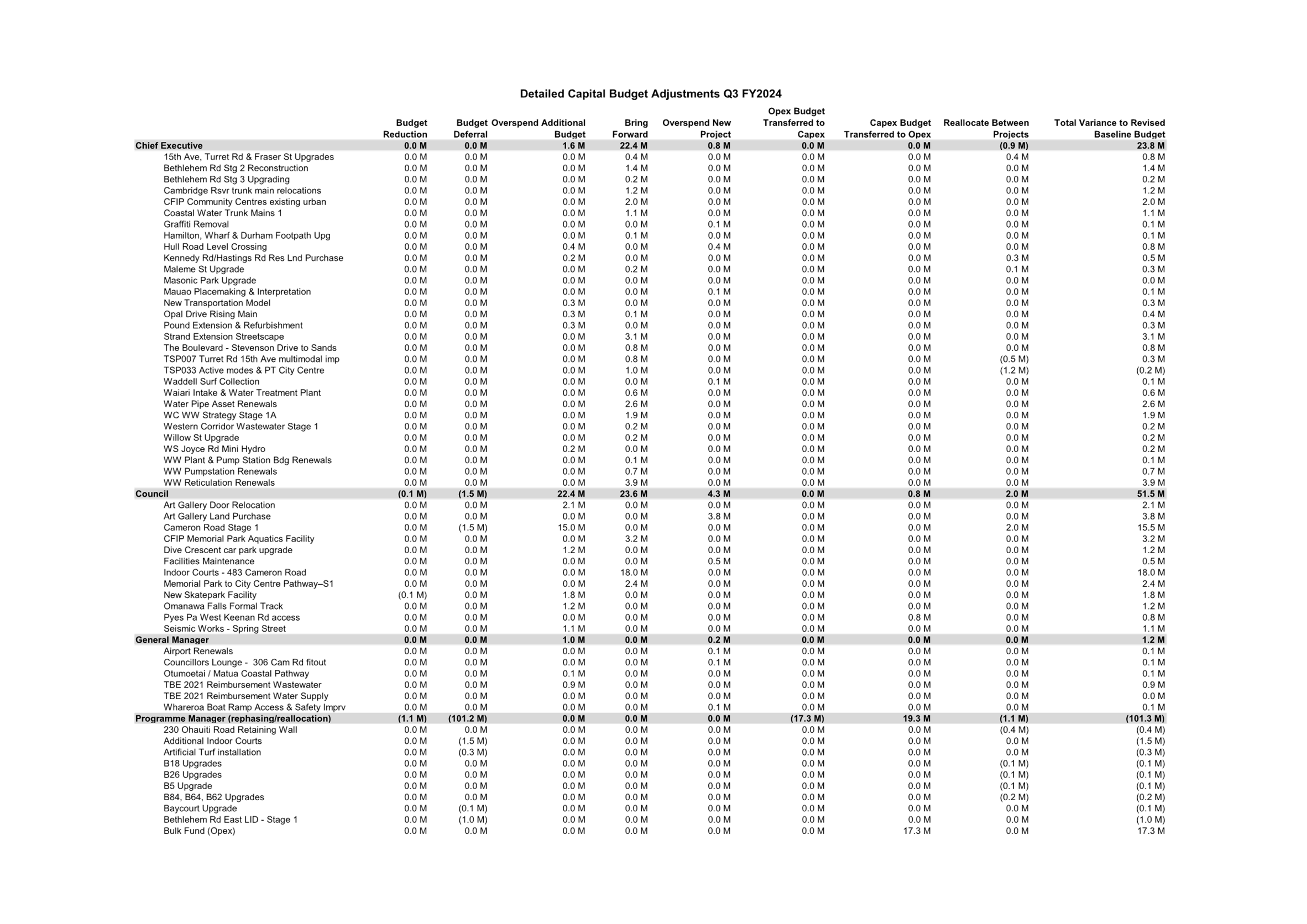

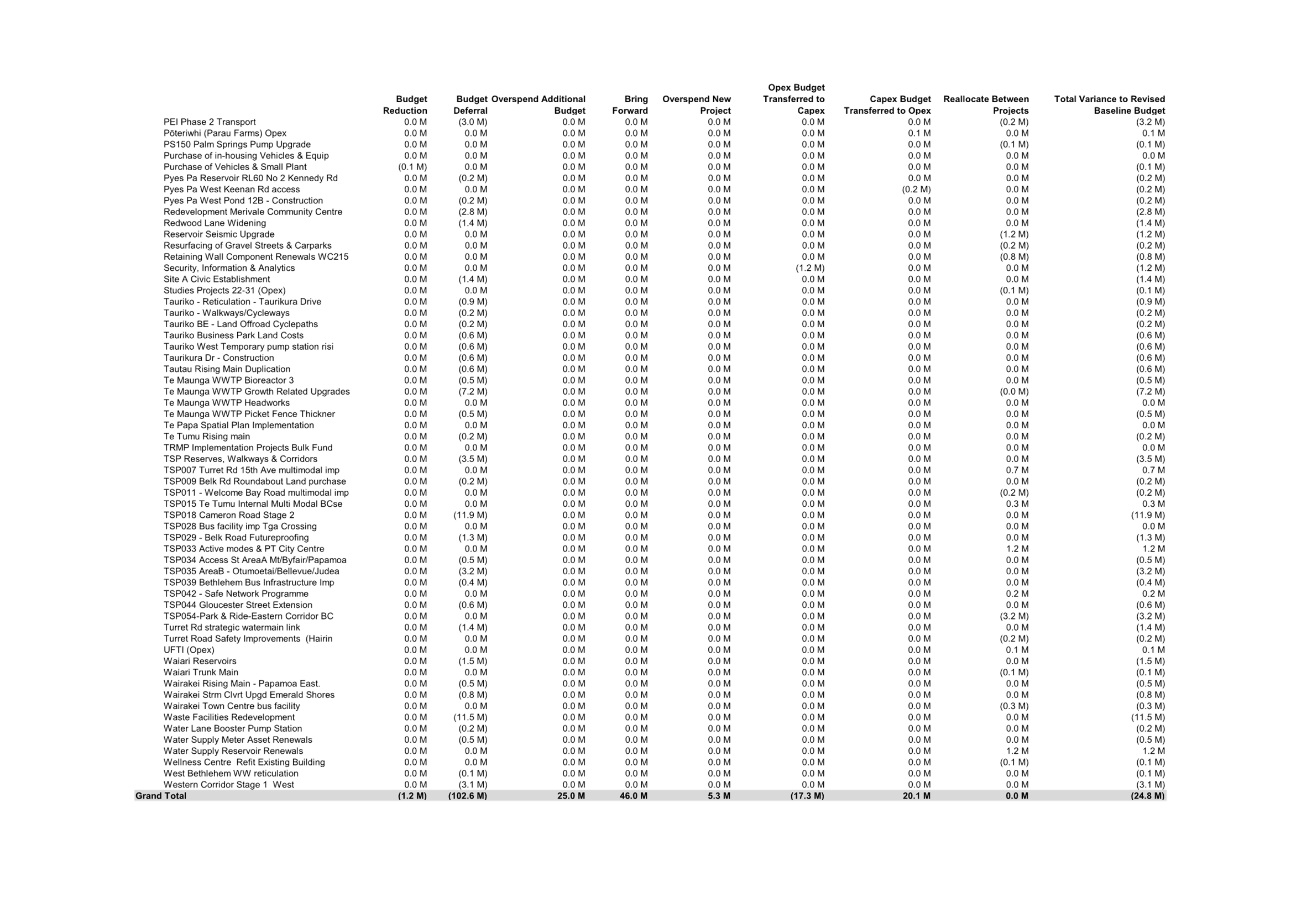
|
Strategy,
Finance and Risk Committee meeting agenda
|
13
May 2024
|
9.9 Capital
Programme 2023/24 3rd Quarter Update
Attachments
Nil
|
Strategy,
Finance and Risk Committee meeting agenda
|
13
May 2024
|
9.10 Audit
New Zealand - Report to the Commissioners on the Audit of the 2024-34 Long-Term
Plan
File
Number: A15914349
Author: Kathryn
Sharplin, Manager: Finance
Josh Logan, Team Leader:
Corporate Planning
Authoriser: Paul
Davidson, Chief Financial Officer
Purpose of the Report
1. This
report presents as an attachment the Audit New Zealand report to the
Commissioners on the audit of Tauranga City Council’s 2024-34 Long-term
Plan (LTP).
|
Recommendations
That the Strategy, Finance and Risk Committee:
(a) Receives
the report ‘Audit New Zealand – Report to the Commissioners on
the Audit of the 2024-34 Long-Term Plan’.
|
Executive Summary
2. The
attached report to the Commissioners from Audit New Zealand on the LTP sets out
their audit findings.
3. Overall,
Audit New Zealand issued a non-standard audit report on 22 April 2024. Without
modifying their audit opinion, they included three emphasis of matter
paragraphs in their audit report drawing attention to:
(a) Risks
associated with minimal debt headroom;
(b) Uncertainty
over the delivery of the capital programme; and
(c) Uncertainty
over external funding sources for the proposed community stadium and civic
precinct.
4. The
attached report outlines the audit opinion which was included with the final
LTP document.
Background
5. The
LTP is prepared under the Local Government Act 2002 (LGA). Under section
94 of the Act, Audit New Zealand is required to audit whether the plan gives
effect to the purpose of the LTP and on the quality of the information and
assumptions underlying the forecast information provided.
6. Audit
New Zealand raised a number of key findings from the Audit of the 2024-34
Long-term Plan. These are discussed in detail in the attached report. The
headings of the audit highlights were:
(a) Three-waters reform;
(b) Compliance with the National
Policy Statement on Urban Development (NPS-UD);
(c) Infrastructure Strategy’s
compliance with the LGA;
(d) Financial Strategy;
(e) Assumptions;
(f) Waka Kotahi (NZTA)
funding;
(g) Uncertainty over the delivery
of the capital programme;
(h) Uncertainty
over external funding sources for the proposed community stadium and civic
precinct; and
(i) The
performance framework.
7. Overall,
Audit New Zealand was satisfied that these matters were appropriately dealt
with, and that the asset management plans, infrastructure strategy and
financial strategy were compliant, concise and consistent.
Strategic / Statutory Context
8. An
audit review of the LTP is part of the LTP process required under section 94 of
the Local Government Act 2002.
Options Analysis
9. There
are no options presented with this report as the Audit New Zealand findings
will be followed up as part of the planning process of the 2027 LTP.
Financial Considerations
10. There
are no direct financial impacts of the audit report.
Significance
11. The
Local Government Act 2002 requires an assessment of the significance of
matters, issues, proposals and decisions in this report against Council’s
Significance and Engagement Policy. Council acknowledges that in some
instances a matter, issue, proposal or decision may have a high degree of
importance to individuals, groups, or agencies affected by the report.
12. In
making this assessment, consideration has been given to the likely impact, and
likely consequences for:
(a) the current
and future social, economic, environmental, or cultural well-being of the
district or region
(b) any persons who are likely to be
particularly affected by, or interested in, the matter.
(c) the capacity of the local authority to
perform its role, and the financial and other costs of doing so.
13. In
accordance with the considerations above, criteria and thresholds in the
policy, it is considered that the matter is of low significance.
ENGAGEMENT
14. Taking
into consideration the above assessment, that the matter is of low significance,
officers are of the opinion that no further engagement is required prior
to Council making a decision to receive this report.
Attachments
1. TCC
LTP Report to Governors - A15917208 ⇩ 
|
Strategy,
Finance and Risk Committee meeting agenda
|
13
May 2024
|
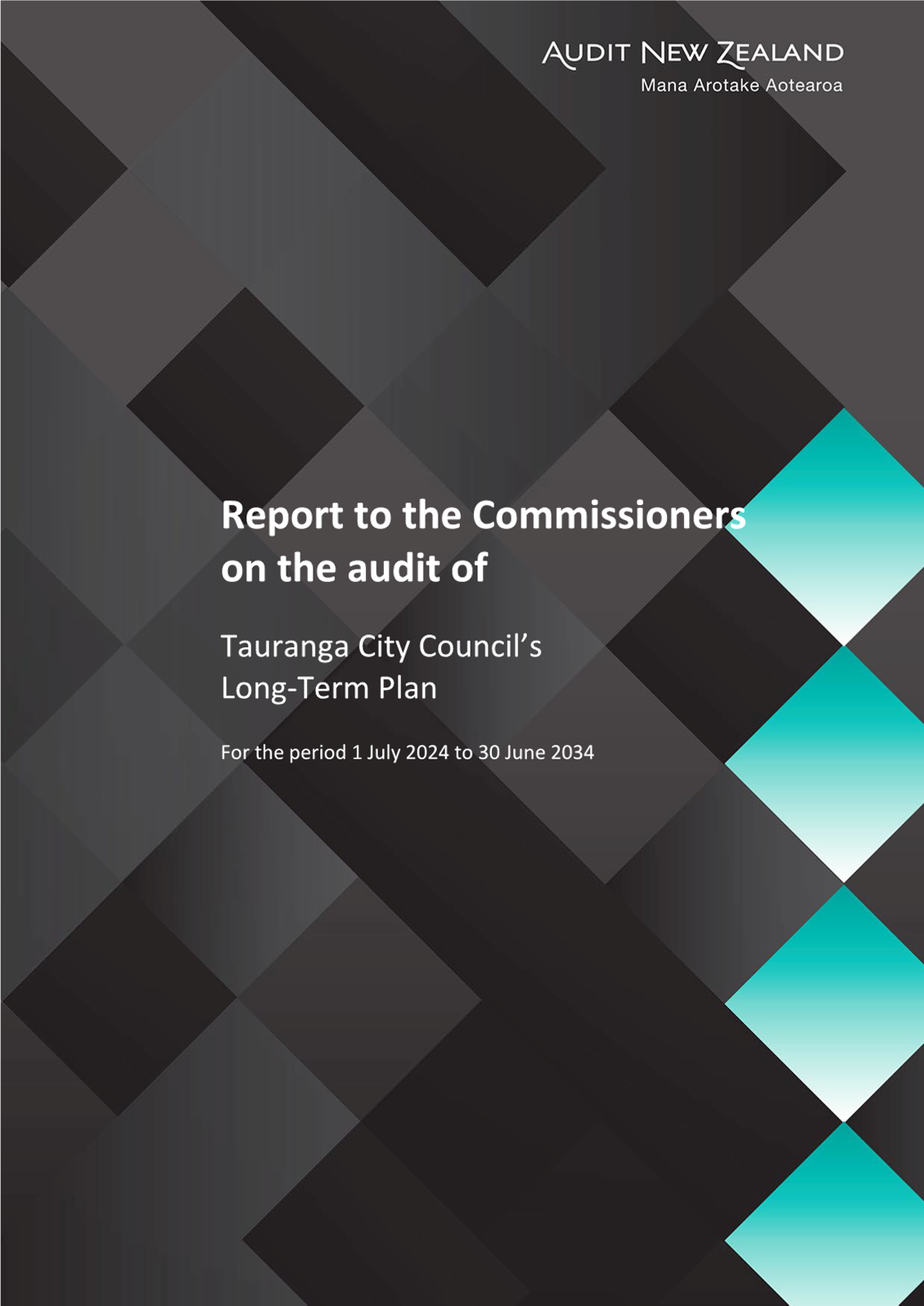
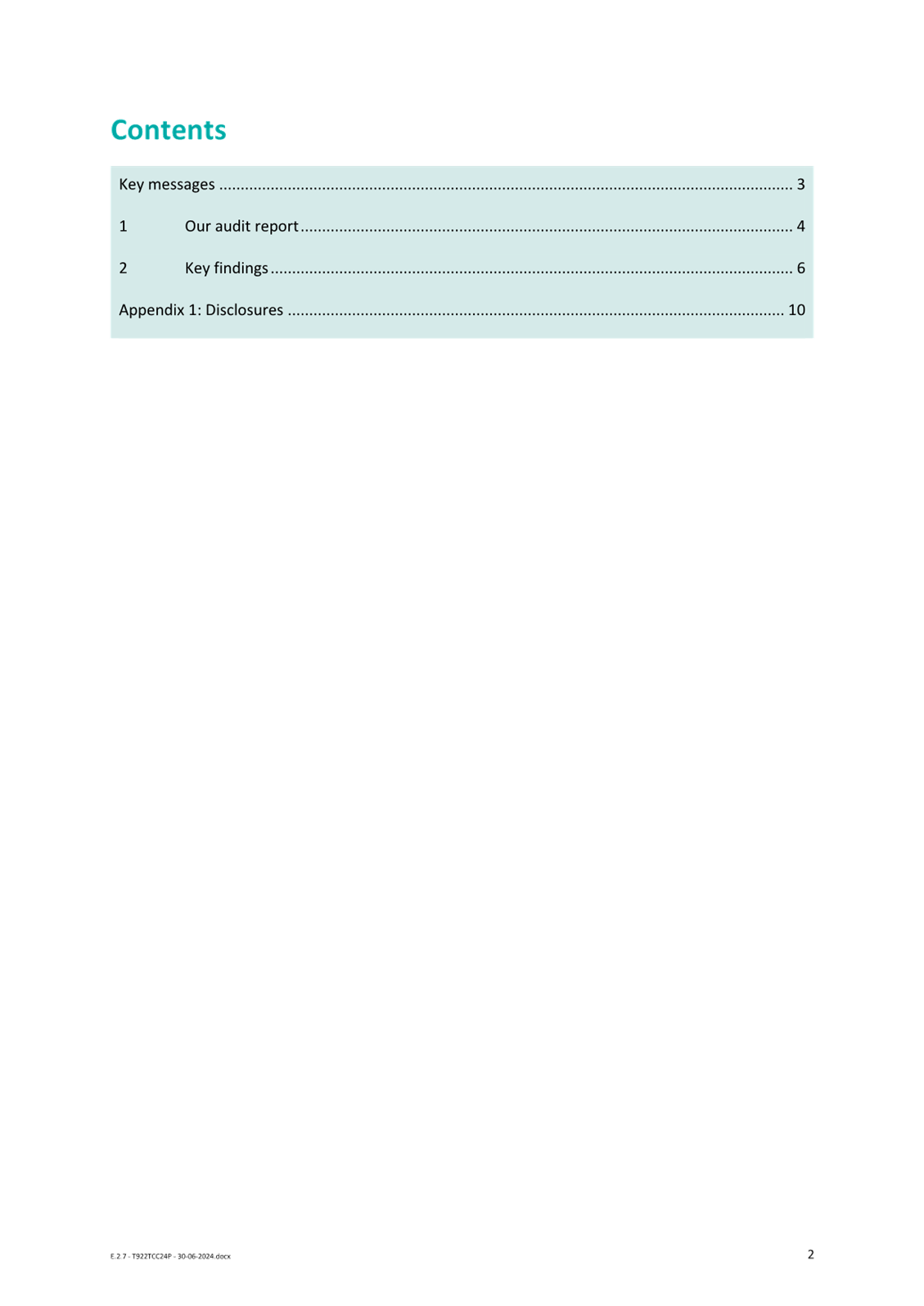
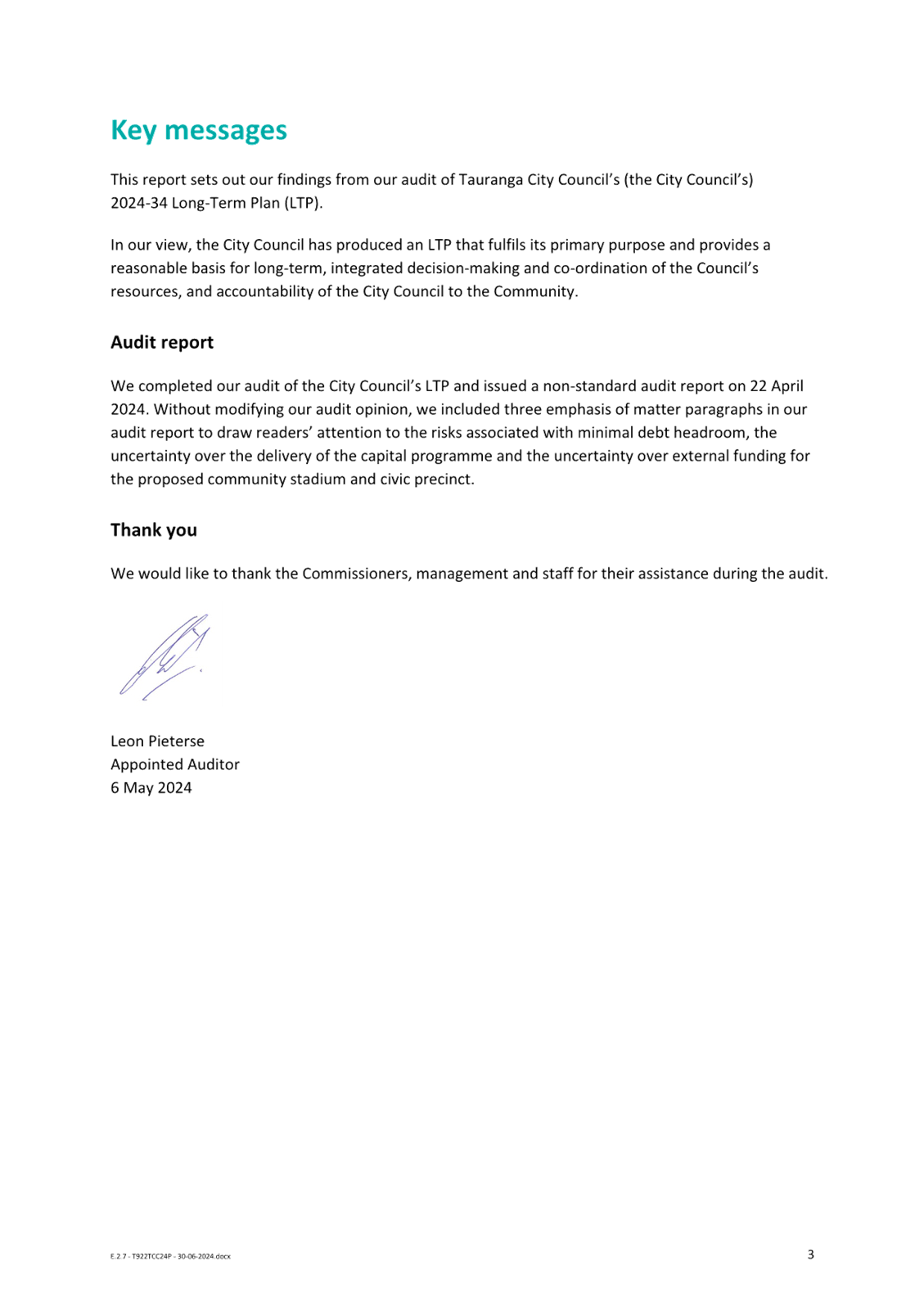
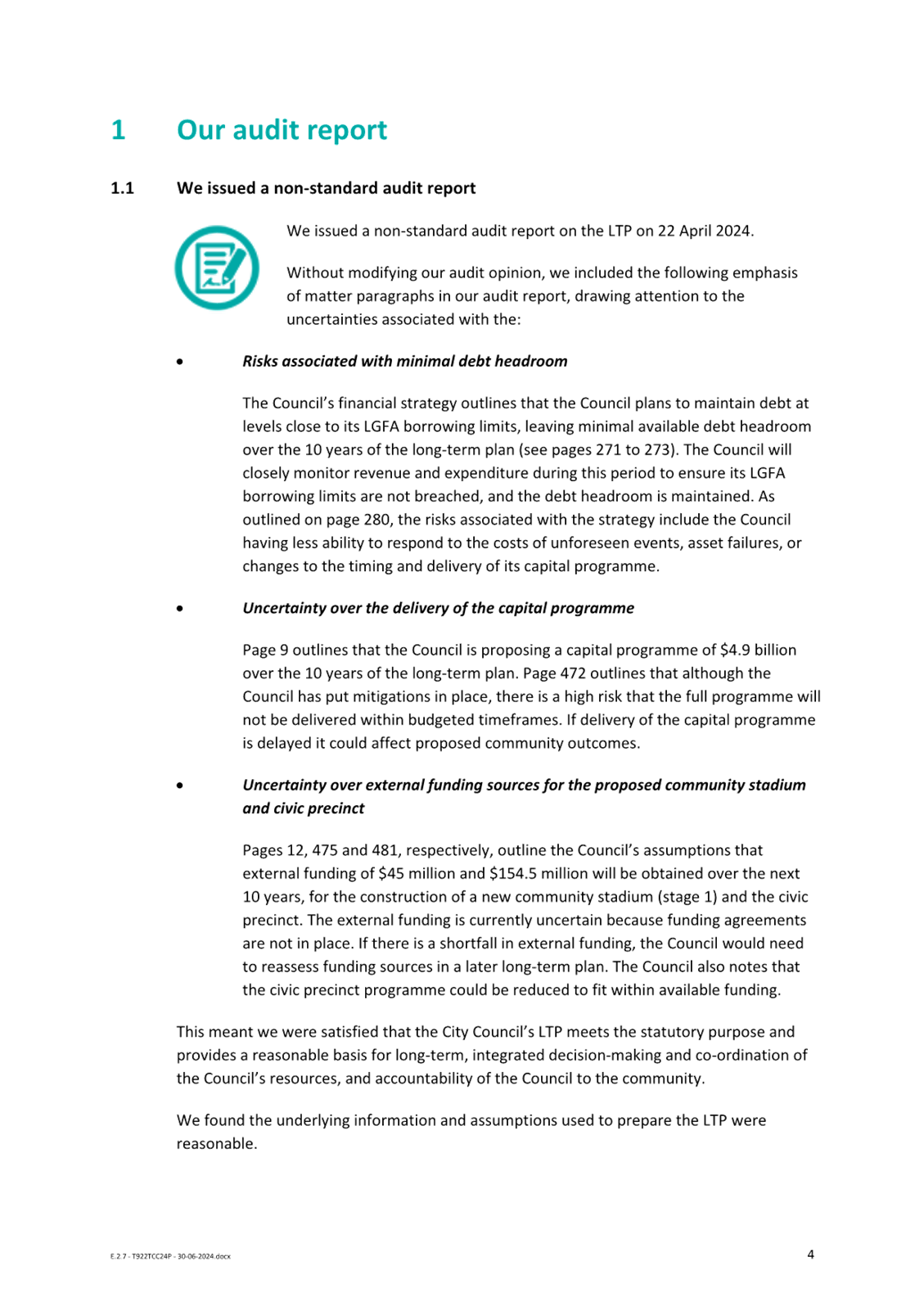
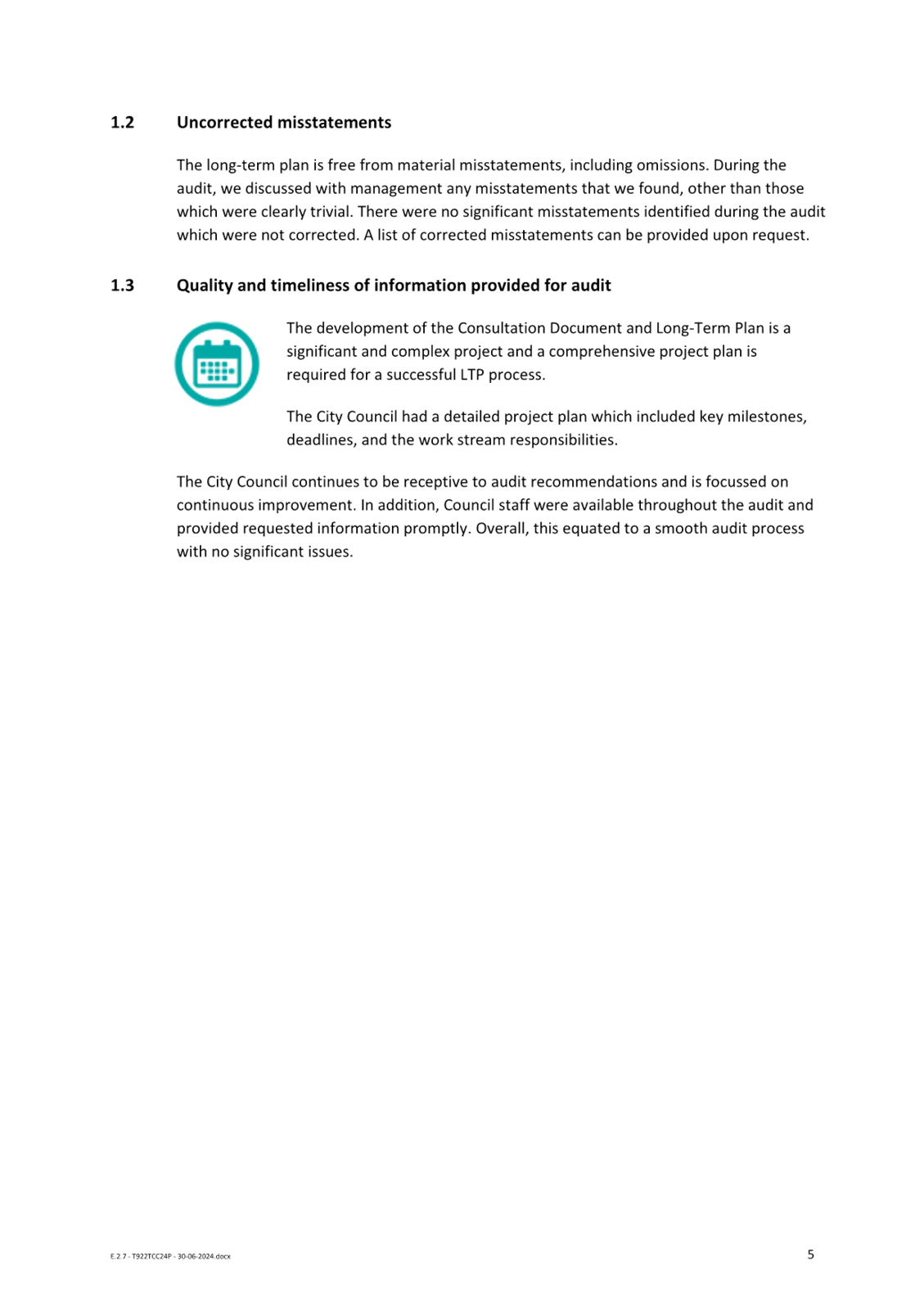
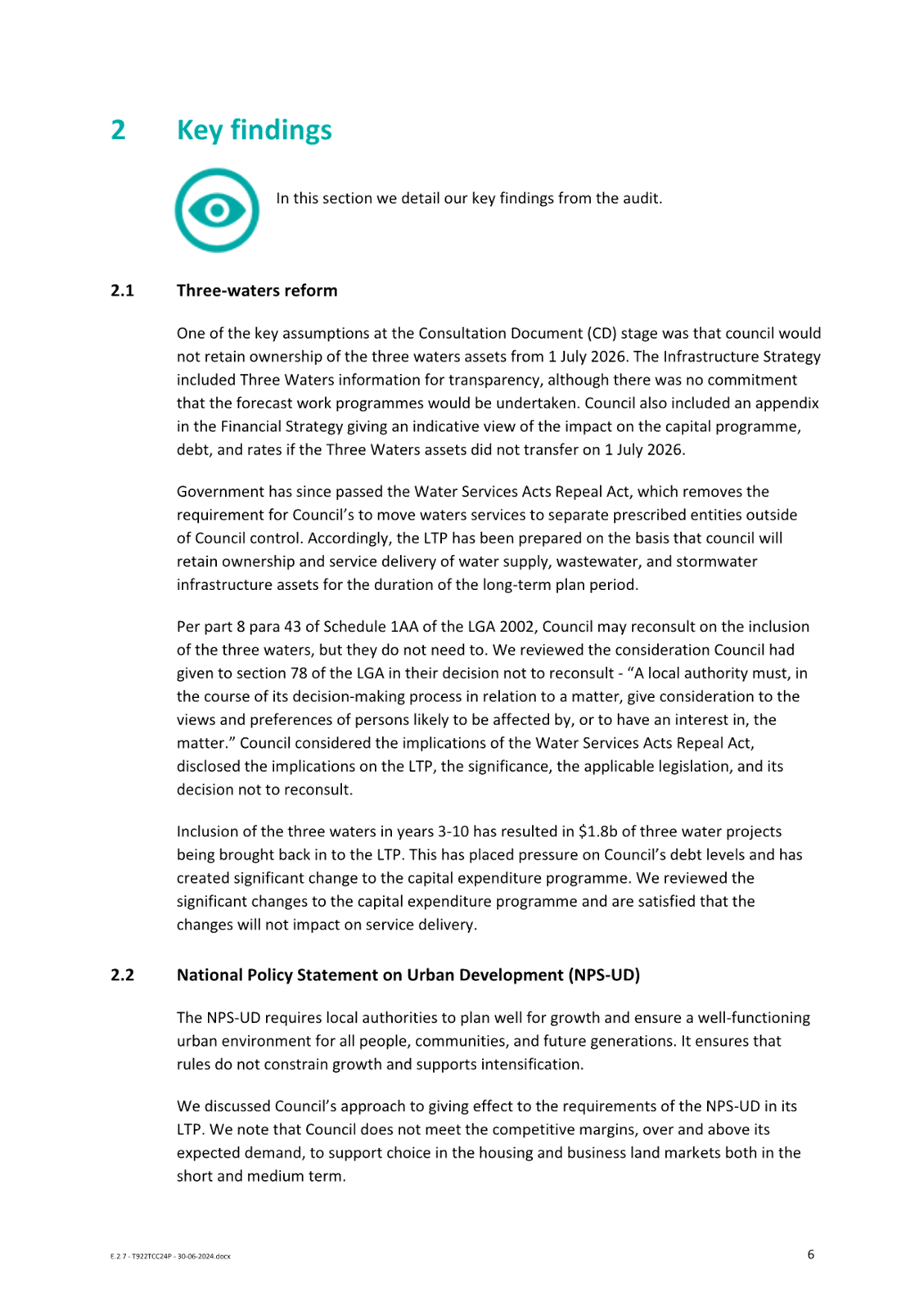
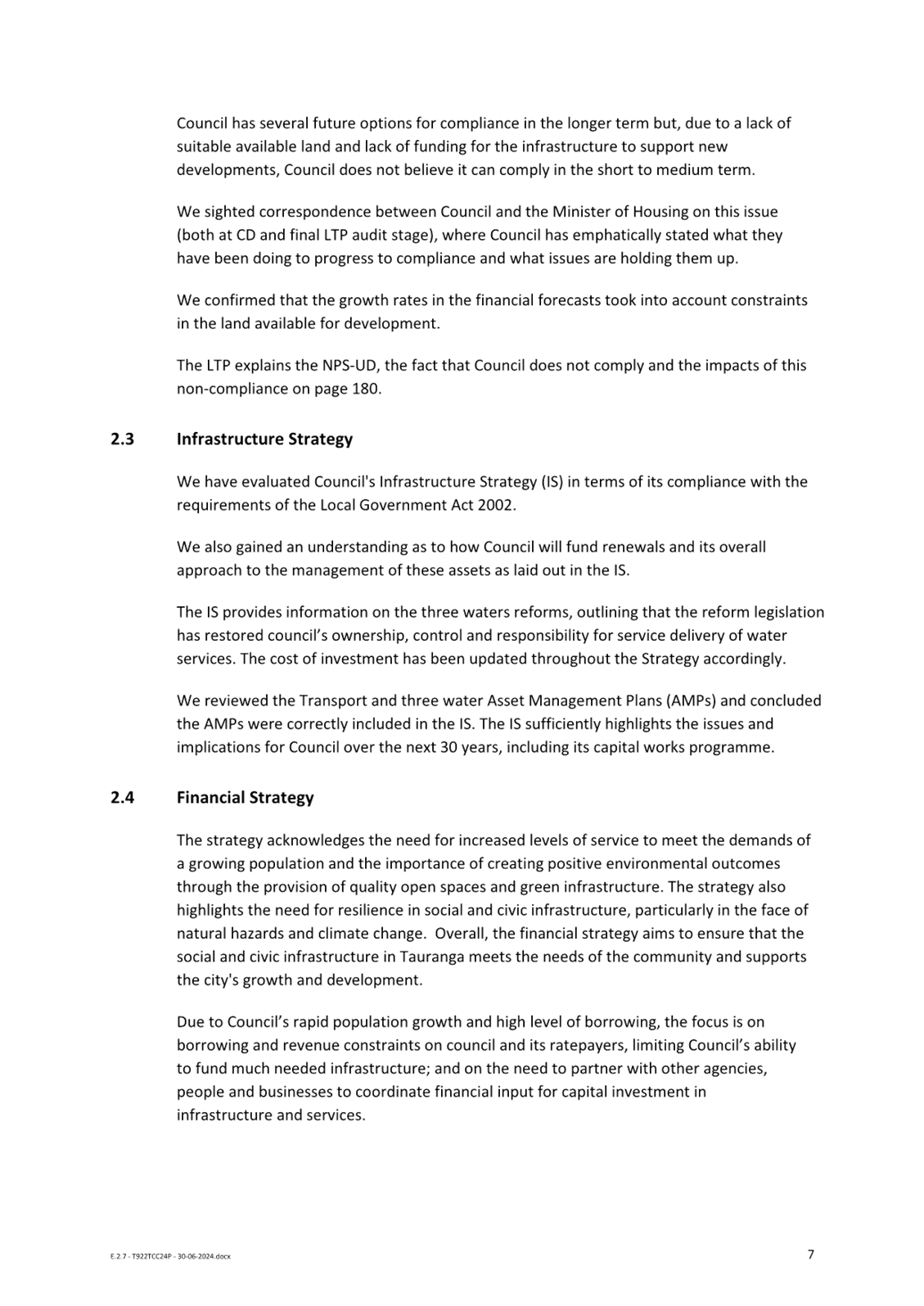
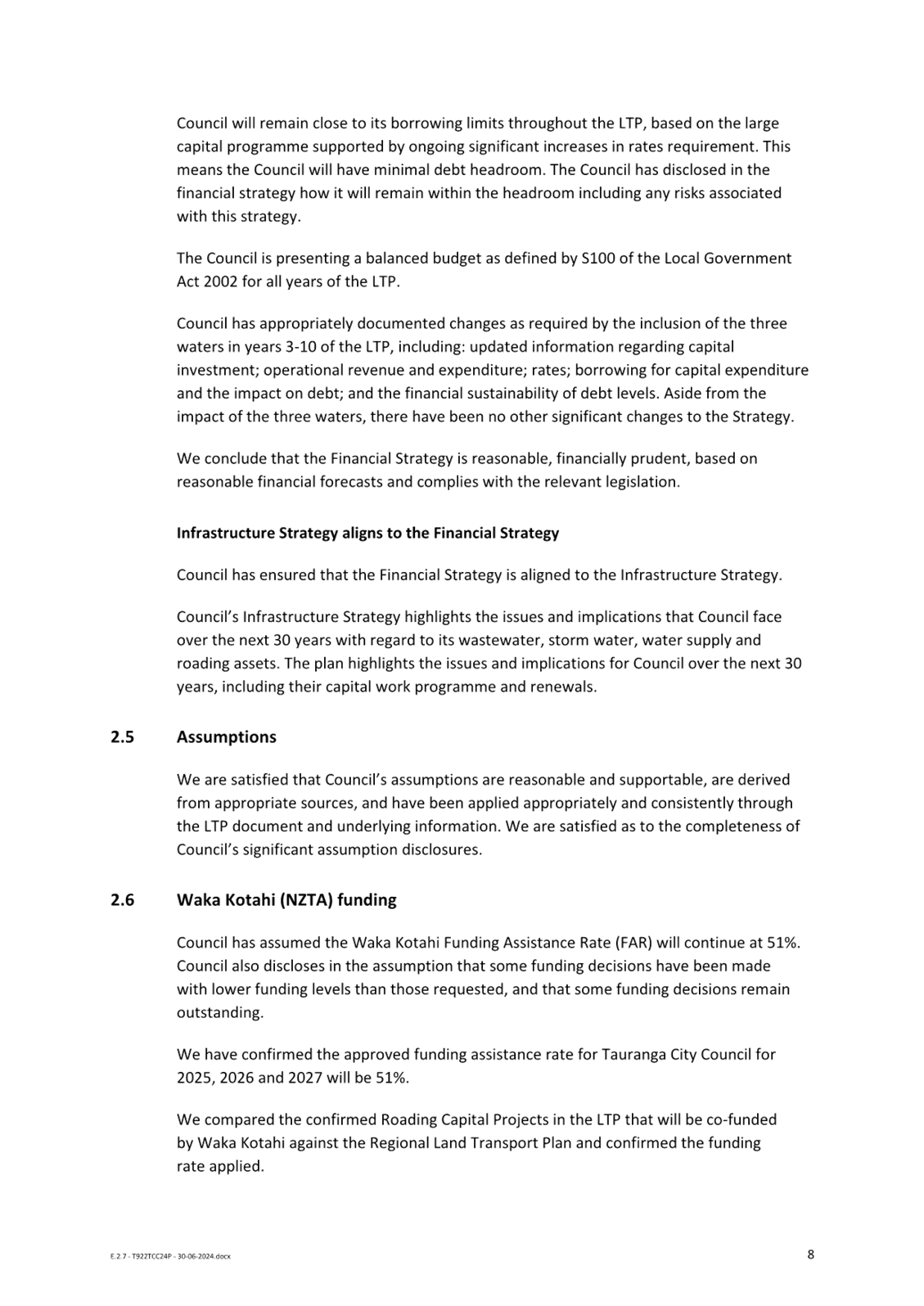
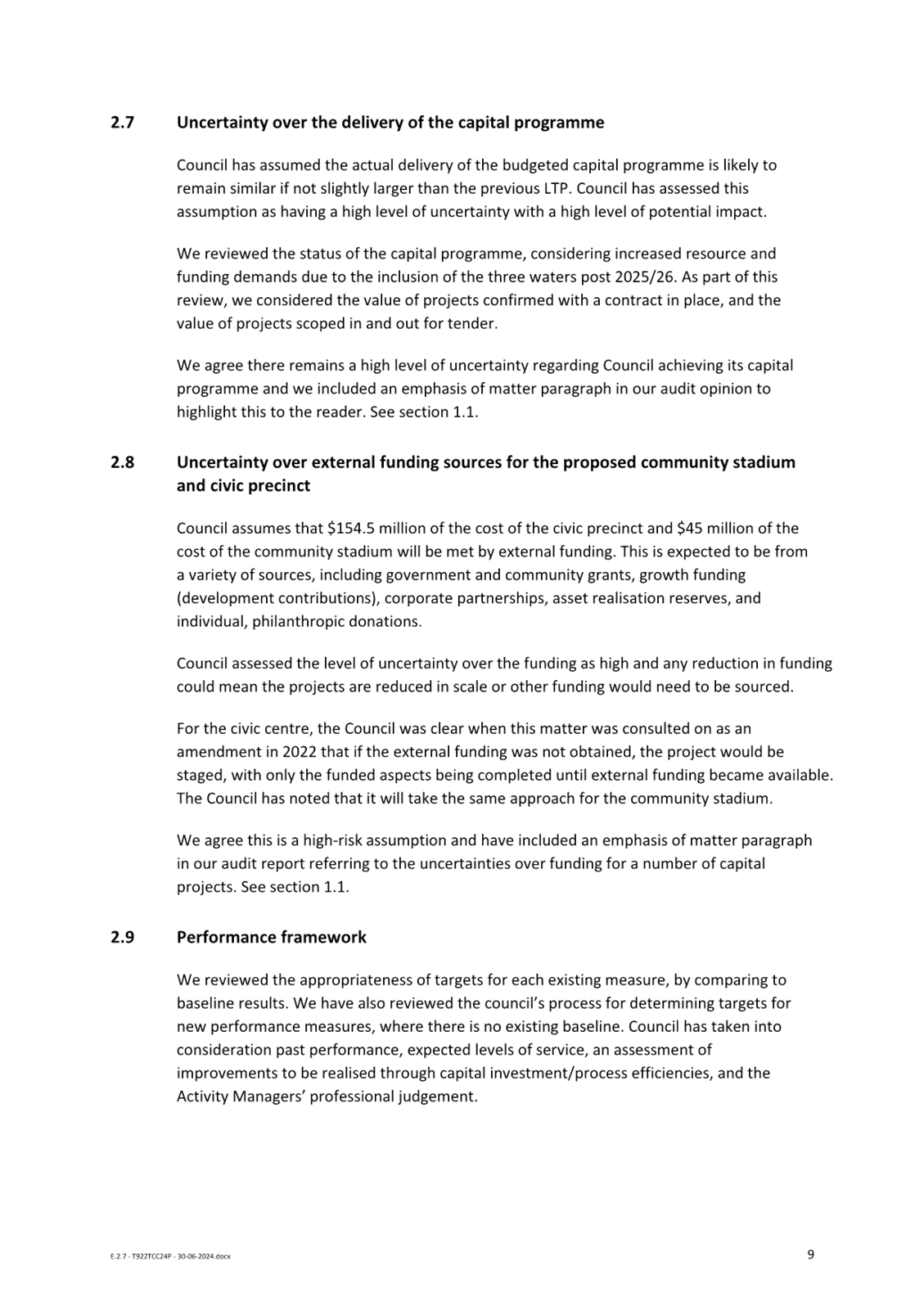
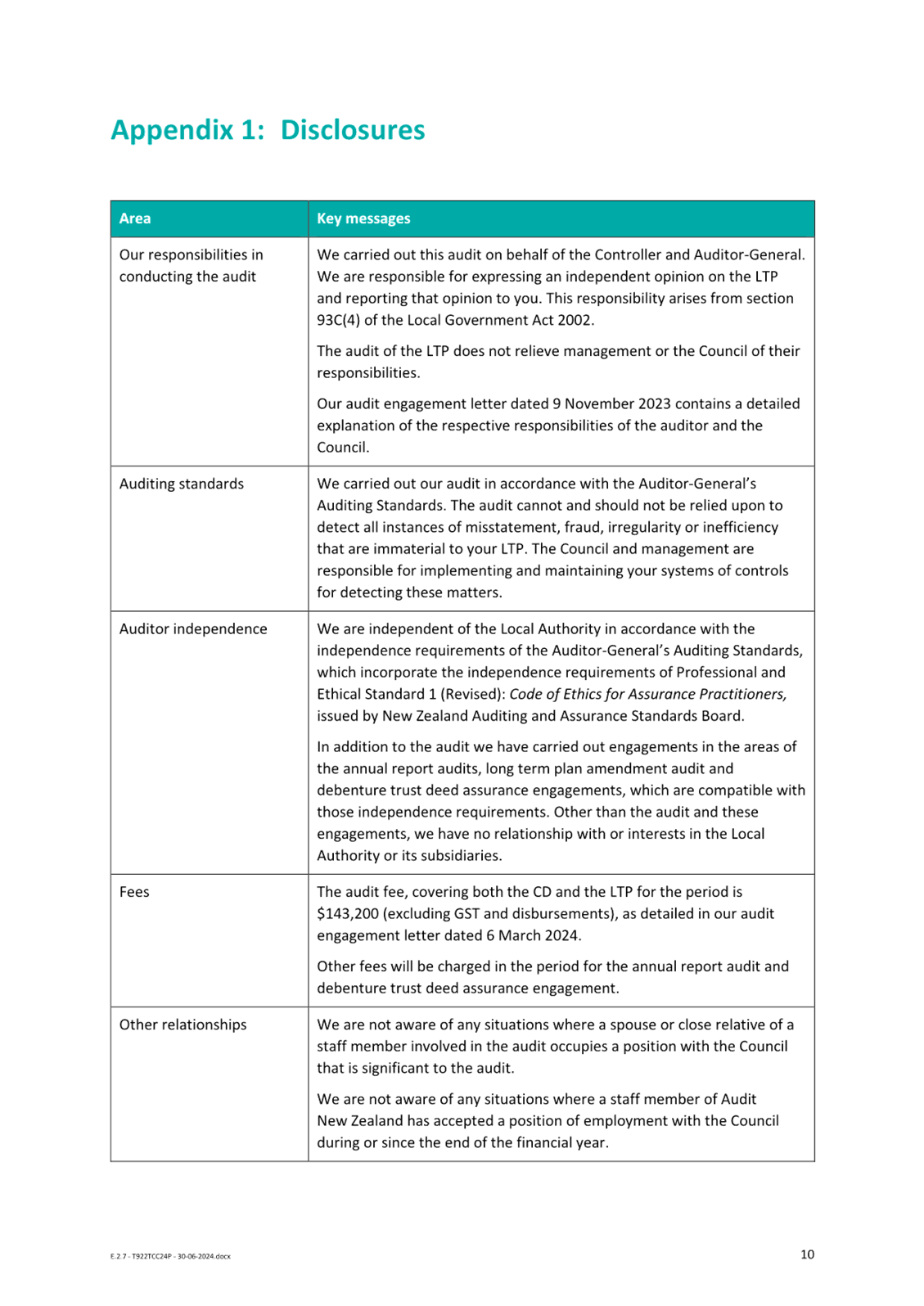
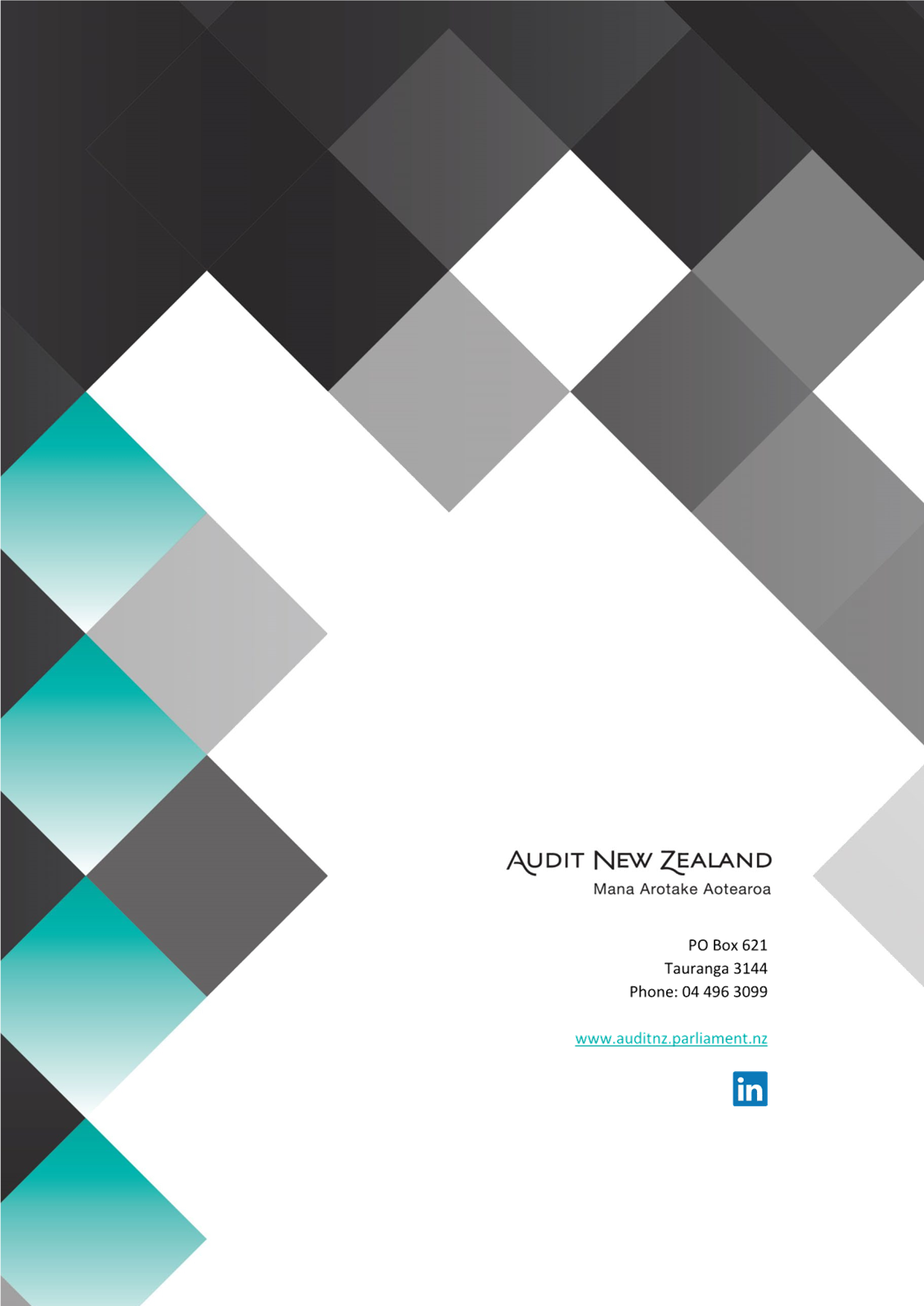
|
Strategy,
Finance and Risk Committee meeting agenda
|
13
May 2024
|
11 Public
excluded session
Resolution to exclude
the public
|
Recommendations
That the public be
excluded from the following parts of the proceedings of this meeting.
The general subject
matter of each matter to be considered while the public is excluded, the
reason for passing this resolution in relation to each matter, and the
specific grounds under section 48 of the Local Government Official
Information and Meetings Act 1987 for the passing of this resolution are as
follows:
|
General subject of each matter to be
considered
|
Reason for passing this resolution in
relation to each matter
|
Ground(s) under section 48 for the
passing of this resolution
|
|
11.1 - Public Excluded minutes of the
Strategy, Finance and Risk Committee meeting held on 25 March 2024
|
s7(2)(a) - The withholding of the information is
necessary to protect the privacy of natural persons, including that of
deceased natural persons
s7(2)(b)(i) - The withholding of the information
is necessary to protect information where the making available of the
information would disclose a trade secret
s7(2)(b)(ii) - The withholding of the information
is necessary to protect information where the making available of the
information would be likely unreasonably to prejudice the commercial
position of the person who supplied or who is the subject of the
information
s7(2)(d) - The withholding of the information is
necessary to avoid prejudice to measures protecting the health or safety of
members of the public
s7(2)(g) - The withholding of the information is
necessary to maintain legal professional privilege
s7(2)(h) - The withholding of the information is
necessary to enable Council to carry out, without prejudice or
disadvantage, commercial activities
s7(2)(i) - The withholding of the information is
necessary to enable Council to carry on, without prejudice or disadvantage,
negotiations (including commercial and industrial negotiations)
|
s48(1)(a) - the public conduct of the relevant
part of the proceedings of the meeting would be likely to result in the
disclosure of information for which good reason for withholding would exist
under section 6 or section 7
|
|
11.2 - Litigation Report
|
s7(2)(a) - The withholding of the information is
necessary to protect the privacy of natural persons, including that of
deceased natural persons
s7(2)(g) - The withholding of the information is
necessary to maintain legal professional privilege
s7(2)(i) - The withholding of the information is
necessary to enable Council to carry on, without prejudice or disadvantage,
negotiations (including commercial and industrial negotiations)
|
s48(1)(a) - the public conduct of the relevant
part of the proceedings of the meeting would be likely to result in the disclosure
of information for which good reason for withholding would exist under
section 6 or section 7
|
|
11.3 - Internal Audit & Assurance
- Quarterly Update
|
s6(b) - The making available of the information
would be likely to endanger the safety of any person
s7(2)(a) - The withholding of the information is
necessary to protect the privacy of natural persons, including that of
deceased natural persons
s7(2)(d) - The withholding of the information is
necessary to avoid prejudice to measures protecting the health or safety of
members of the public
s7(2)(g) - The withholding of the information is
necessary to maintain legal professional privilege
s7(2)(j) - The withholding of the information is
necessary to prevent the disclosure or use of official information for
improper gain or improper advantage
|
s48(1)(a) - the public conduct of the relevant
part of the proceedings of the meeting would be likely to result in the
disclosure of information for which good reason for withholding would exist
under section 6 or section 7
|
|
11.4 - Corporate Risk Register -
Quarterly Update
|
s7(2)(b)(i) - The withholding of the information
is necessary to protect information where the making available of the
information would disclose a trade secret
s7(2)(b)(ii) - The withholding of the information
is necessary to protect information where the making available of the
information would be likely unreasonably to prejudice the commercial
position of the person who supplied or who is the subject of the
information
s7(2)(h) - The withholding of the information is
necessary to enable Council to carry out, without prejudice or
disadvantage, commercial activities
s7(2)(i) - The withholding of the information is
necessary to enable Council to carry on, without prejudice or disadvantage,
negotiations (including commercial and industrial negotiations)
|
s48(1)(a) - the public conduct of the relevant
part of the proceedings of the meeting would be likely to result in the
disclosure of information for which good reason for withholding would exist
under section 6 or section 7
|
|
11.5 - Quarterly Security Report -
FY24
|
s7(2)(c)(ii) - The withholding of the information
is necessary to protect information which is subject to an obligation of
confidence or which any person has been or could be compelled to provide
under the authority of any enactment, where the making available of the
information would be likely otherwise to damage the public interest
|
s48(1)(a) - the public conduct of the relevant
part of the proceedings of the meeting would be likely to result in the
disclosure of information for which good reason for withholding would exist
under section 6 or section 7
|
|





















































































